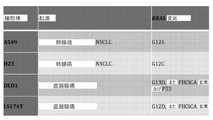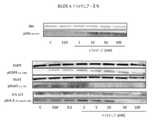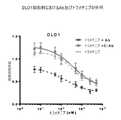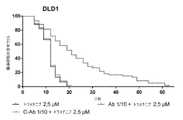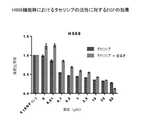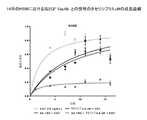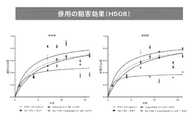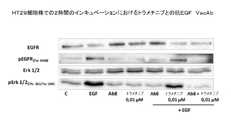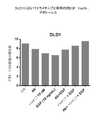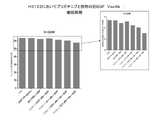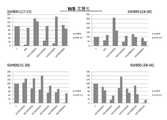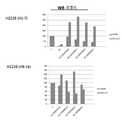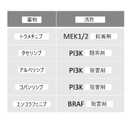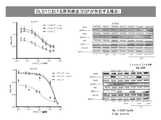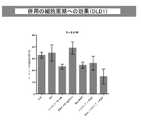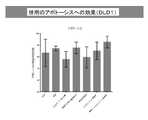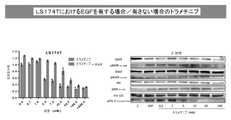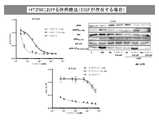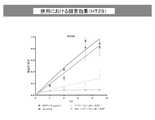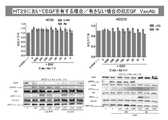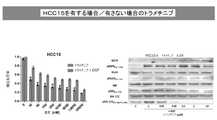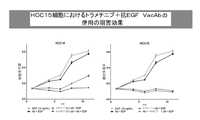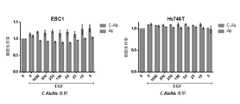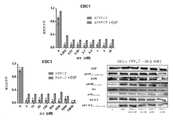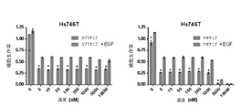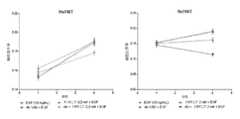JP2023500889A - Methods and compositions for use of growth factor antibodies in combination with non-tyrosine targeted kinase inhibitors - Google Patents
Methods and compositions for use of growth factor antibodies in combination with non-tyrosine targeted kinase inhibitorsDownload PDFInfo
- Publication number
- JP2023500889A JP2023500889AJP2022526005AJP2022526005AJP2023500889AJP 2023500889 AJP2023500889 AJP 2023500889AJP 2022526005 AJP2022526005 AJP 2022526005AJP 2022526005 AJP2022526005 AJP 2022526005AJP 2023500889 AJP2023500889 AJP 2023500889A
- Authority
- JP
- Japan
- Prior art keywords
- seq
- egf
- antibody
- cancer
- combination
- Prior art date
- Legal status (The legal status is an assumption and is not a legal conclusion. Google has not performed a legal analysis and makes no representation as to the accuracy of the status listed.)
- Pending
Links
Images
Classifications
- A—HUMAN NECESSITIES
- A61—MEDICAL OR VETERINARY SCIENCE; HYGIENE
- A61K—PREPARATIONS FOR MEDICAL, DENTAL OR TOILETRY PURPOSES
- A61K38/00—Medicinal preparations containing peptides
- A61K38/16—Peptides having more than 20 amino acids; Gastrins; Somatostatins; Melanotropins; Derivatives thereof
- A61K38/17—Peptides having more than 20 amino acids; Gastrins; Somatostatins; Melanotropins; Derivatives thereof from animals; from humans
- A61K38/177—Receptors; Cell surface antigens; Cell surface determinants
- A61K38/179—Receptors; Cell surface antigens; Cell surface determinants for growth factors; for growth regulators
- A—HUMAN NECESSITIES
- A61—MEDICAL OR VETERINARY SCIENCE; HYGIENE
- A61K—PREPARATIONS FOR MEDICAL, DENTAL OR TOILETRY PURPOSES
- A61K38/00—Medicinal preparations containing peptides
- A61K38/16—Peptides having more than 20 amino acids; Gastrins; Somatostatins; Melanotropins; Derivatives thereof
- A61K38/17—Peptides having more than 20 amino acids; Gastrins; Somatostatins; Melanotropins; Derivatives thereof from animals; from humans
- A61K38/18—Growth factors; Growth regulators
- A61K38/1808—Epidermal growth factor [EGF] urogastrone
- A—HUMAN NECESSITIES
- A61—MEDICAL OR VETERINARY SCIENCE; HYGIENE
- A61K—PREPARATIONS FOR MEDICAL, DENTAL OR TOILETRY PURPOSES
- A61K31/00—Medicinal preparations containing organic active ingredients
- A61K31/33—Heterocyclic compounds
- A61K31/395—Heterocyclic compounds having nitrogen as a ring hetero atom, e.g. guanethidine or rifamycins
- A61K31/41—Heterocyclic compounds having nitrogen as a ring hetero atom, e.g. guanethidine or rifamycins having five-membered rings with two or more ring hetero atoms, at least one of which being nitrogen, e.g. tetrazole
- A61K31/4164—1,3-Diazoles
- A61K31/4184—1,3-Diazoles condensed with carbocyclic rings, e.g. benzimidazoles
- A—HUMAN NECESSITIES
- A61—MEDICAL OR VETERINARY SCIENCE; HYGIENE
- A61K—PREPARATIONS FOR MEDICAL, DENTAL OR TOILETRY PURPOSES
- A61K31/00—Medicinal preparations containing organic active ingredients
- A61K31/33—Heterocyclic compounds
- A61K31/395—Heterocyclic compounds having nitrogen as a ring hetero atom, e.g. guanethidine or rifamycins
- A61K31/435—Heterocyclic compounds having nitrogen as a ring hetero atom, e.g. guanethidine or rifamycins having six-membered rings with one nitrogen as the only ring hetero atom
- A61K31/4353—Heterocyclic compounds having nitrogen as a ring hetero atom, e.g. guanethidine or rifamycins having six-membered rings with one nitrogen as the only ring hetero atom ortho- or peri-condensed with heterocyclic ring systems
- A61K31/437—Heterocyclic compounds having nitrogen as a ring hetero atom, e.g. guanethidine or rifamycins having six-membered rings with one nitrogen as the only ring hetero atom ortho- or peri-condensed with heterocyclic ring systems the heterocyclic ring system containing a five-membered ring having nitrogen as a ring hetero atom, e.g. indolizine, beta-carboline
- A—HUMAN NECESSITIES
- A61—MEDICAL OR VETERINARY SCIENCE; HYGIENE
- A61K—PREPARATIONS FOR MEDICAL, DENTAL OR TOILETRY PURPOSES
- A61K31/00—Medicinal preparations containing organic active ingredients
- A61K31/33—Heterocyclic compounds
- A61K31/395—Heterocyclic compounds having nitrogen as a ring hetero atom, e.g. guanethidine or rifamycins
- A61K31/435—Heterocyclic compounds having nitrogen as a ring hetero atom, e.g. guanethidine or rifamycins having six-membered rings with one nitrogen as the only ring hetero atom
- A61K31/44—Non condensed pyridines; Hydrogenated derivatives thereof
- A61K31/4427—Non condensed pyridines; Hydrogenated derivatives thereof containing further heterocyclic ring systems
- A61K31/4439—Non condensed pyridines; Hydrogenated derivatives thereof containing further heterocyclic ring systems containing a five-membered ring with nitrogen as a ring hetero atom, e.g. omeprazole
- A—HUMAN NECESSITIES
- A61—MEDICAL OR VETERINARY SCIENCE; HYGIENE
- A61K—PREPARATIONS FOR MEDICAL, DENTAL OR TOILETRY PURPOSES
- A61K31/00—Medicinal preparations containing organic active ingredients
- A61K31/33—Heterocyclic compounds
- A61K31/395—Heterocyclic compounds having nitrogen as a ring hetero atom, e.g. guanethidine or rifamycins
- A61K31/435—Heterocyclic compounds having nitrogen as a ring hetero atom, e.g. guanethidine or rifamycins having six-membered rings with one nitrogen as the only ring hetero atom
- A61K31/47—Quinolines; Isoquinolines
- A61K31/4738—Quinolines; Isoquinolines ortho- or peri-condensed with heterocyclic ring systems
- A61K31/4745—Quinolines; Isoquinolines ortho- or peri-condensed with heterocyclic ring systems condensed with ring systems having nitrogen as a ring hetero atom, e.g. phenantrolines
- A—HUMAN NECESSITIES
- A61—MEDICAL OR VETERINARY SCIENCE; HYGIENE
- A61K—PREPARATIONS FOR MEDICAL, DENTAL OR TOILETRY PURPOSES
- A61K31/00—Medicinal preparations containing organic active ingredients
- A61K31/33—Heterocyclic compounds
- A61K31/395—Heterocyclic compounds having nitrogen as a ring hetero atom, e.g. guanethidine or rifamycins
- A61K31/495—Heterocyclic compounds having nitrogen as a ring hetero atom, e.g. guanethidine or rifamycins having six-membered rings with two or more nitrogen atoms as the only ring heteroatoms, e.g. piperazine or tetrazines
- A61K31/505—Pyrimidines; Hydrogenated pyrimidines, e.g. trimethoprim
- A61K31/506—Pyrimidines; Hydrogenated pyrimidines, e.g. trimethoprim not condensed and containing further heterocyclic rings
- A—HUMAN NECESSITIES
- A61—MEDICAL OR VETERINARY SCIENCE; HYGIENE
- A61K—PREPARATIONS FOR MEDICAL, DENTAL OR TOILETRY PURPOSES
- A61K31/00—Medicinal preparations containing organic active ingredients
- A61K31/33—Heterocyclic compounds
- A61K31/395—Heterocyclic compounds having nitrogen as a ring hetero atom, e.g. guanethidine or rifamycins
- A61K31/495—Heterocyclic compounds having nitrogen as a ring hetero atom, e.g. guanethidine or rifamycins having six-membered rings with two or more nitrogen atoms as the only ring heteroatoms, e.g. piperazine or tetrazines
- A61K31/505—Pyrimidines; Hydrogenated pyrimidines, e.g. trimethoprim
- A61K31/519—Pyrimidines; Hydrogenated pyrimidines, e.g. trimethoprim ortho- or peri-condensed with heterocyclic rings
- A—HUMAN NECESSITIES
- A61—MEDICAL OR VETERINARY SCIENCE; HYGIENE
- A61K—PREPARATIONS FOR MEDICAL, DENTAL OR TOILETRY PURPOSES
- A61K31/00—Medicinal preparations containing organic active ingredients
- A61K31/33—Heterocyclic compounds
- A61K31/395—Heterocyclic compounds having nitrogen as a ring hetero atom, e.g. guanethidine or rifamycins
- A61K31/495—Heterocyclic compounds having nitrogen as a ring hetero atom, e.g. guanethidine or rifamycins having six-membered rings with two or more nitrogen atoms as the only ring heteroatoms, e.g. piperazine or tetrazines
- A61K31/505—Pyrimidines; Hydrogenated pyrimidines, e.g. trimethoprim
- A61K31/519—Pyrimidines; Hydrogenated pyrimidines, e.g. trimethoprim ortho- or peri-condensed with heterocyclic rings
- A61K31/52—Purines, e.g. adenine
- A—HUMAN NECESSITIES
- A61—MEDICAL OR VETERINARY SCIENCE; HYGIENE
- A61K—PREPARATIONS FOR MEDICAL, DENTAL OR TOILETRY PURPOSES
- A61K31/00—Medicinal preparations containing organic active ingredients
- A61K31/33—Heterocyclic compounds
- A61K31/395—Heterocyclic compounds having nitrogen as a ring hetero atom, e.g. guanethidine or rifamycins
- A61K31/535—Heterocyclic compounds having nitrogen as a ring hetero atom, e.g. guanethidine or rifamycins having six-membered rings with at least one nitrogen and one oxygen as the ring hetero atoms, e.g. 1,2-oxazines
- A61K31/5375—1,4-Oxazines, e.g. morpholine
- A61K31/5377—1,4-Oxazines, e.g. morpholine not condensed and containing further heterocyclic rings, e.g. timolol
- A—HUMAN NECESSITIES
- A61—MEDICAL OR VETERINARY SCIENCE; HYGIENE
- A61K—PREPARATIONS FOR MEDICAL, DENTAL OR TOILETRY PURPOSES
- A61K31/00—Medicinal preparations containing organic active ingredients
- A61K31/33—Heterocyclic compounds
- A61K31/395—Heterocyclic compounds having nitrogen as a ring hetero atom, e.g. guanethidine or rifamycins
- A61K31/55—Heterocyclic compounds having nitrogen as a ring hetero atom, e.g. guanethidine or rifamycins having seven-membered rings, e.g. azelastine, pentylenetetrazole
- A61K31/553—Heterocyclic compounds having nitrogen as a ring hetero atom, e.g. guanethidine or rifamycins having seven-membered rings, e.g. azelastine, pentylenetetrazole having at least one nitrogen and one oxygen as ring hetero atoms, e.g. loxapine, staurosporine
- A—HUMAN NECESSITIES
- A61—MEDICAL OR VETERINARY SCIENCE; HYGIENE
- A61K—PREPARATIONS FOR MEDICAL, DENTAL OR TOILETRY PURPOSES
- A61K31/00—Medicinal preparations containing organic active ingredients
- A61K31/66—Phosphorus compounds
- A61K31/683—Diesters of a phosphorus acid with two hydroxy compounds, e.g. phosphatidylinositols
- A61K31/685—Diesters of a phosphorus acid with two hydroxy compounds, e.g. phosphatidylinositols one of the hydroxy compounds having nitrogen atoms, e.g. phosphatidylserine, lecithin
- A—HUMAN NECESSITIES
- A61—MEDICAL OR VETERINARY SCIENCE; HYGIENE
- A61K—PREPARATIONS FOR MEDICAL, DENTAL OR TOILETRY PURPOSES
- A61K39/00—Medicinal preparations containing antigens or antibodies
- A61K39/0005—Vertebrate antigens
- A61K39/0011—Cancer antigens
- A61K39/001102—Receptors, cell surface antigens or cell surface determinants
- A61K39/001103—Receptors for growth factors
- A61K39/001104—Epidermal growth factor receptors [EGFR]
- A—HUMAN NECESSITIES
- A61—MEDICAL OR VETERINARY SCIENCE; HYGIENE
- A61K—PREPARATIONS FOR MEDICAL, DENTAL OR TOILETRY PURPOSES
- A61K39/00—Medicinal preparations containing antigens or antibodies
- A61K39/0005—Vertebrate antigens
- A61K39/0011—Cancer antigens
- A61K39/00113—Growth factors
- A61K39/001131—Epidermal growth factor [EGF]
- A—HUMAN NECESSITIES
- A61—MEDICAL OR VETERINARY SCIENCE; HYGIENE
- A61K—PREPARATIONS FOR MEDICAL, DENTAL OR TOILETRY PURPOSES
- A61K39/00—Medicinal preparations containing antigens or antibodies
- A61K39/395—Antibodies; Immunoglobulins; Immune serum, e.g. antilymphocytic serum
- A—HUMAN NECESSITIES
- A61—MEDICAL OR VETERINARY SCIENCE; HYGIENE
- A61K—PREPARATIONS FOR MEDICAL, DENTAL OR TOILETRY PURPOSES
- A61K39/00—Medicinal preparations containing antigens or antibodies
- A61K39/395—Antibodies; Immunoglobulins; Immune serum, e.g. antilymphocytic serum
- A61K39/39533—Antibodies; Immunoglobulins; Immune serum, e.g. antilymphocytic serum against materials from animals
- A61K39/3955—Antibodies; Immunoglobulins; Immune serum, e.g. antilymphocytic serum against materials from animals against proteinaceous materials, e.g. enzymes, hormones, lymphokines
- A—HUMAN NECESSITIES
- A61—MEDICAL OR VETERINARY SCIENCE; HYGIENE
- A61K—PREPARATIONS FOR MEDICAL, DENTAL OR TOILETRY PURPOSES
- A61K47/00—Medicinal preparations characterised by the non-active ingredients used, e.g. carriers or inert additives; Targeting or modifying agents chemically bound to the active ingredient
- A61K47/50—Medicinal preparations characterised by the non-active ingredients used, e.g. carriers or inert additives; Targeting or modifying agents chemically bound to the active ingredient the non-active ingredient being chemically bound to the active ingredient, e.g. polymer-drug conjugates
- A61K47/51—Medicinal preparations characterised by the non-active ingredients used, e.g. carriers or inert additives; Targeting or modifying agents chemically bound to the active ingredient the non-active ingredient being chemically bound to the active ingredient, e.g. polymer-drug conjugates the non-active ingredient being a modifying agent
- A61K47/62—Medicinal preparations characterised by the non-active ingredients used, e.g. carriers or inert additives; Targeting or modifying agents chemically bound to the active ingredient the non-active ingredient being chemically bound to the active ingredient, e.g. polymer-drug conjugates the non-active ingredient being a modifying agent the modifying agent being a protein, peptide or polyamino acid
- A61K47/64—Drug-peptide, drug-protein or drug-polyamino acid conjugates, i.e. the modifying agent being a peptide, protein or polyamino acid which is covalently bonded or complexed to a therapeutically active agent
- A61K47/642—Drug-peptide, drug-protein or drug-polyamino acid conjugates, i.e. the modifying agent being a peptide, protein or polyamino acid which is covalently bonded or complexed to a therapeutically active agent the peptide or protein in the drug conjugate being a cytokine, e.g. IL2, chemokine, growth factors or interferons being the inactive part of the conjugate
- A—HUMAN NECESSITIES
- A61—MEDICAL OR VETERINARY SCIENCE; HYGIENE
- A61K—PREPARATIONS FOR MEDICAL, DENTAL OR TOILETRY PURPOSES
- A61K47/00—Medicinal preparations characterised by the non-active ingredients used, e.g. carriers or inert additives; Targeting or modifying agents chemically bound to the active ingredient
- A61K47/50—Medicinal preparations characterised by the non-active ingredients used, e.g. carriers or inert additives; Targeting or modifying agents chemically bound to the active ingredient the non-active ingredient being chemically bound to the active ingredient, e.g. polymer-drug conjugates
- A61K47/51—Medicinal preparations characterised by the non-active ingredients used, e.g. carriers or inert additives; Targeting or modifying agents chemically bound to the active ingredient the non-active ingredient being chemically bound to the active ingredient, e.g. polymer-drug conjugates the non-active ingredient being a modifying agent
- A61K47/62—Medicinal preparations characterised by the non-active ingredients used, e.g. carriers or inert additives; Targeting or modifying agents chemically bound to the active ingredient the non-active ingredient being chemically bound to the active ingredient, e.g. polymer-drug conjugates the non-active ingredient being a modifying agent the modifying agent being a protein, peptide or polyamino acid
- A61K47/64—Drug-peptide, drug-protein or drug-polyamino acid conjugates, i.e. the modifying agent being a peptide, protein or polyamino acid which is covalently bonded or complexed to a therapeutically active agent
- A61K47/6425—Drug-peptide, drug-protein or drug-polyamino acid conjugates, i.e. the modifying agent being a peptide, protein or polyamino acid which is covalently bonded or complexed to a therapeutically active agent the peptide or protein in the drug conjugate being a receptor, e.g. CD4, a cell surface antigen, i.e. not a peptide ligand targeting the antigen, or a cell surface determinant, i.e. a part of the surface of a cell
- A—HUMAN NECESSITIES
- A61—MEDICAL OR VETERINARY SCIENCE; HYGIENE
- A61K—PREPARATIONS FOR MEDICAL, DENTAL OR TOILETRY PURPOSES
- A61K47/00—Medicinal preparations characterised by the non-active ingredients used, e.g. carriers or inert additives; Targeting or modifying agents chemically bound to the active ingredient
- A61K47/50—Medicinal preparations characterised by the non-active ingredients used, e.g. carriers or inert additives; Targeting or modifying agents chemically bound to the active ingredient the non-active ingredient being chemically bound to the active ingredient, e.g. polymer-drug conjugates
- A61K47/51—Medicinal preparations characterised by the non-active ingredients used, e.g. carriers or inert additives; Targeting or modifying agents chemically bound to the active ingredient the non-active ingredient being chemically bound to the active ingredient, e.g. polymer-drug conjugates the non-active ingredient being a modifying agent
- A61K47/62—Medicinal preparations characterised by the non-active ingredients used, e.g. carriers or inert additives; Targeting or modifying agents chemically bound to the active ingredient the non-active ingredient being chemically bound to the active ingredient, e.g. polymer-drug conjugates the non-active ingredient being a modifying agent the modifying agent being a protein, peptide or polyamino acid
- A61K47/65—Peptidic linkers, binders or spacers, e.g. peptidic enzyme-labile linkers
- A—HUMAN NECESSITIES
- A61—MEDICAL OR VETERINARY SCIENCE; HYGIENE
- A61P—SPECIFIC THERAPEUTIC ACTIVITY OF CHEMICAL COMPOUNDS OR MEDICINAL PREPARATIONS
- A61P11/00—Drugs for disorders of the respiratory system
- A—HUMAN NECESSITIES
- A61—MEDICAL OR VETERINARY SCIENCE; HYGIENE
- A61P—SPECIFIC THERAPEUTIC ACTIVITY OF CHEMICAL COMPOUNDS OR MEDICINAL PREPARATIONS
- A61P35/00—Antineoplastic agents
- C—CHEMISTRY; METALLURGY
- C07—ORGANIC CHEMISTRY
- C07K—PEPTIDES
- C07K16/00—Immunoglobulins [IGs], e.g. monoclonal or polyclonal antibodies
- C07K16/18—Immunoglobulins [IGs], e.g. monoclonal or polyclonal antibodies against material from animals or humans
- C07K16/22—Immunoglobulins [IGs], e.g. monoclonal or polyclonal antibodies against material from animals or humans against growth factors ; against growth regulators
- C—CHEMISTRY; METALLURGY
- C07—ORGANIC CHEMISTRY
- C07K—PEPTIDES
- C07K16/00—Immunoglobulins [IGs], e.g. monoclonal or polyclonal antibodies
- C07K16/40—Immunoglobulins [IGs], e.g. monoclonal or polyclonal antibodies against enzymes
- A—HUMAN NECESSITIES
- A61—MEDICAL OR VETERINARY SCIENCE; HYGIENE
- A61K—PREPARATIONS FOR MEDICAL, DENTAL OR TOILETRY PURPOSES
- A61K39/00—Medicinal preparations containing antigens or antibodies
- A61K2039/505—Medicinal preparations containing antigens or antibodies comprising antibodies
- A—HUMAN NECESSITIES
- A61—MEDICAL OR VETERINARY SCIENCE; HYGIENE
- A61K—PREPARATIONS FOR MEDICAL, DENTAL OR TOILETRY PURPOSES
- A61K2300/00—Mixtures or combinations of active ingredients, wherein at least one active ingredient is fully defined in groups A61K31/00 - A61K41/00
- C—CHEMISTRY; METALLURGY
- C07—ORGANIC CHEMISTRY
- C07K—PEPTIDES
- C07K2317/00—Immunoglobulins specific features
- C07K2317/70—Immunoglobulins specific features characterized by effect upon binding to a cell or to an antigen
- C07K2317/73—Inducing cell death, e.g. apoptosis, necrosis or inhibition of cell proliferation
- C—CHEMISTRY; METALLURGY
- C07—ORGANIC CHEMISTRY
- C07K—PEPTIDES
- C07K2317/00—Immunoglobulins specific features
- C07K2317/70—Immunoglobulins specific features characterized by effect upon binding to a cell or to an antigen
- C07K2317/76—Antagonist effect on antigen, e.g. neutralization or inhibition of binding
Landscapes
- Health & Medical Sciences (AREA)
- Life Sciences & Earth Sciences (AREA)
- Chemical & Material Sciences (AREA)
- Medicinal Chemistry (AREA)
- General Health & Medical Sciences (AREA)
- Pharmacology & Pharmacy (AREA)
- Veterinary Medicine (AREA)
- Public Health (AREA)
- Animal Behavior & Ethology (AREA)
- Epidemiology (AREA)
- Immunology (AREA)
- Engineering & Computer Science (AREA)
- Bioinformatics & Cheminformatics (AREA)
- Proteomics, Peptides & Aminoacids (AREA)
- Organic Chemistry (AREA)
- Microbiology (AREA)
- Mycology (AREA)
- Gastroenterology & Hepatology (AREA)
- Molecular Biology (AREA)
- Cell Biology (AREA)
- Dermatology (AREA)
- Oncology (AREA)
- Zoology (AREA)
- Biophysics (AREA)
- Biochemistry (AREA)
- Genetics & Genomics (AREA)
- Nuclear Medicine, Radiotherapy & Molecular Imaging (AREA)
- General Chemical & Material Sciences (AREA)
- Chemical Kinetics & Catalysis (AREA)
- Endocrinology (AREA)
- Pulmonology (AREA)
- Medicines Containing Antibodies Or Antigens For Use As Internal Diagnostic Agents (AREA)
- Medicines That Contain Protein Lipid Enzymes And Other Medicines (AREA)
- Peptides Or Proteins (AREA)
- Medicinal Preparation (AREA)
Abstract
Translated fromJapaneseDescription
Translated fromJapanese 関連出願の相互参照
本出願は、2019年11月7日に出願された米国仮特許出願第62/932,131号、発明の名称「COMPOSITIONS AND METHODS FOR USE OF ANTI-EGF ANTIBODIES WITH MEK INHIBITORS」、及び2020年10月20日に出願された米国仮特許出願第63/094,018号、発明の名称「ANTI-EPIDERMAL GROWTH FACTOR VACCINE ANTIBODIES INCREASE THE ANTITUMOR ACTIVITY OF KINASE INHIBITORS IN NON SMALL CELL LUNG CANCER CELL LINES」に対する優先権を主張し、これらは、あらゆる目的のためにそれらの全体が参照により本明細書に組み込まれる。CROSS-REFERENCE TO RELATED APPLICATIONS This application is based on U.S. Provisional Patent Application No. 62/932,131, filed November 7, 2019, entitled "COMPOSITIONS AND METHODS FOR USE OF ANTI-EGF ANTIBODIES WITH MEK INHIBITORS"; and U.S. Provisional Patent Application No. 63/094,018, filed Oct. 20, 2020, entitled "ANTI-EPIDERMAL GROWTH FACTOR VACCINE ANTIBODYS INCREASE THE ANTIUMOR ACTIVITY OF KINASE INHIBITORS IN NON SMALL CELLULCELL CELL CELLUNER". which are hereby incorporated by reference in their entireties for all purposes.
本開示は、癌を治療するための方法に関する。より具体的には、本開示は、癌の治療、及び、NTKIに対する内因性及び/又は獲得性の耐性の予防における、非チロシン標的化キナーゼ阻害剤(NTKI)と組み合わせたキメラ非天然合成タンパク質の使用に関する。 The present disclosure relates to methods for treating cancer. More specifically, the present disclosure relates to the use of chimeric, non-naturally occurring synthetic proteins in combination with non-tyrosine-targeted kinase inhibitors (NTKIs) in the treatment of cancer and prevention of endogenous and/or acquired resistance to NTKIs. Regarding use.
世界保健機関によれば、新生物(例えば、癌)は、世界中で主要な死因の1つであり、2015年には880万人の死亡の原因であった。世界のヒト集団における癌の頻度は顕著であり、死者6人のうちほぼ1人を占める。2015年では、最も一般的な癌の死亡は、以下の種類の癌に起因していた。肺癌(約170万人が死亡)、肝癌(約80万人が死亡)、結腸直腸癌(約80万人が死亡)、胃癌(約80万人が死亡)、及び乳癌(約60万人が死亡)。 Neoplasms (eg, cancer) are one of the leading causes of death worldwide, responsible for 8.8 million deaths in 2015, according to the World Health Organization. The frequency of cancer in the world's human population is significant, accounting for nearly 1 in 6 deaths. In 2015, the most common cancer deaths were attributed to the following types of cancer. lung cancer (approximately 1.7 million deaths), liver cancer (approximately 800,000 deaths), colorectal cancer (approximately 800,000 deaths), stomach cancer (approximately 800,000 deaths), and breast cancer (approximately 600,000 deaths) death).
ほとんどの化学療法剤は、悪性表現型の発生に関与すると考えられる特定の分子標的に作用する。しかしながら、シグナル伝達経路の複雑なネットワークは細胞増殖を調節し、悪性癌の大部分はこれらの経路における複数の遺伝子異常によって促進される。標準的な細胞傷害性化学療法による癌の治療は有効性のために最適化されているが、より最近の手法は、それらの異なる癌遺伝子ドライバーに基づいて分子サブセットに分類することに基づいている。癌のこれらの分子ドライバーは、特定の癌遺伝子に対する標的薬剤で治療的に攻撃することができる。 Most chemotherapeutic agents act on specific molecular targets thought to be involved in the development of the malignant phenotype. However, a complex network of signaling pathways regulates cell proliferation and the majority of malignant cancers are driven by multiple genetic abnormalities in these pathways. Treatment of cancer with standard cytotoxic chemotherapy is optimized for efficacy, but more recent approaches are based on classifying molecular subsets based on their distinct oncogene drivers. . These molecular drivers of cancer can be therapeutically attacked with targeted agents against specific oncogenes.
癌治療における治療的介入のための有望な標的セットには、HER-キナーゼ軸のメンバー及びその下流のエフェクターが含まれる。それらは、例として、前立腺、肺及び乳房の固形上皮腫瘍において頻繁に変異を示し、膠芽腫においても上方制御される。野生型EGFRエフェクタータンパク質(例えば、RAS、BRAF及びPIK3CA)を有する患者は、EGFRを標的とするチロシンキナーゼ阻害剤(TKI)、例えばセツキシマブ及びエルロチニブで治療することができる。しかしながら、EGFRエフェクタータンパク質に変異を有する癌患者の大きなコホートが存在する。変異は、EGFRを標的とするTKIに対する耐性をもたらし、EGFRエフェクターを標的とする非チロシン標的化キナーゼ阻害剤(NTKI)に対する耐性の発生を可能にするため、これらの患者には既存の治療は有効ではない。同様に、野生型EGFRエフェクタータンパク質を有する患者におけるEGFRを標的とするTKIによる治療は、癌遺伝子変異の選択のために耐性の発生をもたらすことが多い。したがって、TKI及びNTKIを用いた既存の治療は、一部の患者においてEGFR経路を標的とする強力な抗腫瘍特性を示すが、耐性が生じた患者ではそれほど強力でなくなるか、又は効果が完全になくなる。EGFRエフェクターキナーゼは、TKI及びNTKIに対する内因性及び獲得性の両方の耐性の機構として同定されているという点で、「バイパス経路」と呼ばれることがある。理論に拘束されるものではないが、EGFRシグナル伝達カスケード中の並行キナーゼ又は他のキナーゼが変異キナーゼを補い、これによってより強いEGFRシグナル伝達効果を誘導すると考えられる。したがって、EGFR又は同様の成長因子が介在する疾患及び癌を効果的に治療するために、非チロシン標的化キナーゼ阻害剤に対するEGFR経路の耐性を克服する更なる治療法が必要とされている。 A promising set of targets for therapeutic intervention in cancer therapy includes members of the HER-kinase axis and their downstream effectors. They are frequently mutated in solid cell tumors of the prostate, lung and breast, for example, and are also upregulated in glioblastoma. Patients with wild-type EGFR effector proteins (eg, RAS, BRAF and PIK3CA) can be treated with tyrosine kinase inhibitors (TKIs) that target EGFR, such as cetuximab and erlotinib. However, there is a large cohort of cancer patients with mutations in EGFR effector proteins. Mutations confer resistance to TKIs that target the EGFR and allow the development of resistance to non-tyrosine-targeted kinase inhibitors (NTKIs) that target the EGFR effectors, making existing treatments effective in these patients. is not. Similarly, treatment with EGFR-targeted TKIs in patients with wild-type EGFR effector proteins often results in the development of resistance due to selection of oncogene mutations. Thus, existing treatments with TKIs and NTKIs show potent anti-tumor properties targeting the EGFR pathway in some patients, but become less potent or completely ineffective in patients who develop resistance. Gone. EGFR effector kinases are sometimes referred to as "bypass pathways" in that they have been identified as mechanisms of both intrinsic and acquired resistance to TKIs and NTKIs. Without being bound by theory, it is believed that parallel kinases or other kinases in the EGFR signaling cascade complement the mutated kinases, thereby inducing stronger EGFR signaling effects. Therefore, there is a need for additional therapeutics that overcome EGFR pathway resistance to non-tyrosine-targeted kinase inhibitors in order to effectively treat diseases and cancers mediated by EGFR or similar growth factors.
本開示は、非チロシン標的化キナーゼ阻害剤(NTKI)に対する耐性を防止又は最小化し、これにより細胞増殖を阻害する、EGFRエフェクター非チロシン標的化キナーゼ阻害剤と組み合わせたキメラ非天然合成タンパク質の使用に関する。これらの療法は、例えば、肺癌、乳癌、膀胱癌、前立腺癌、卵巣癌、外陰癌、結腸癌、結腸直腸癌、腸癌、肺癌、脳癌、食道癌、及び他の癌などの癌を治療するために使用することができる。 The present disclosure relates to the use of chimeric, non-naturally occurring synthetic proteins in combination with EGFR effector non-tyrosine-targeted kinase inhibitors (NTKIs) to prevent or minimize resistance to non-tyrosine-targeted kinase inhibitors (NTKIs), thereby inhibiting cell proliferation. . These therapies treat cancers such as, for example, lung cancer, breast cancer, bladder cancer, prostate cancer, ovarian cancer, vulvar cancer, colon cancer, colorectal cancer, intestinal cancer, lung cancer, brain cancer, esophageal cancer, and other cancers. can be used to
例示的な実施形態では、本開示は、対象に、非チロシン標的化キナーゼ阻害剤(NTKI)、並びに、成長因子又は成長因子受容体の全長又はその断片、免疫原性ポリペプチド及びリンカーを含む非天然合成ポリペプチド(NNSP)の活性レジメンを投与することを含み、ポリペプチドがリンカーによって免疫原性ポリペプチドから分離されている、対象の癌を治療する方法を提供する。 In exemplary embodiments, the present disclosure is directed to non-tyrosine-targeted kinase inhibitors (NTKIs), as well as non-tyrosine-targeted kinase inhibitors, including full-length or fragments thereof, immunogenic polypeptides and linkers of growth factors or growth factor receptors. A method of treating cancer in a subject is provided comprising administering an active regimen of a naturally occurring synthetic polypeptide (NNSP), wherein the polypeptide is separated from an immunogenic polypeptide by a linker.
いくつかの実施形態では、対象において癌を治療する方法は、非チロシン標的化キナーゼ阻害剤(NTKI)及び成長因子又は成長因子受容体に対する抗体の活性レジメンを対象に投与することを含む。 In some embodiments, a method of treating cancer in a subject comprises administering to the subject an active regimen of a non-tyrosine-targeted kinase inhibitor (NTKI) and an antibody against a growth factor or growth factor receptor.
他の実施形態では、非チロシン標的化キナーゼ阻害剤(NTKI)、並びに、成長因子又は成長因子受容体の全長又はその断片、免疫原性ポリペプチド及びリンカーを含む非天然合成ポリペプチド(NNSP)を投与することを含み、ポリペプチドがリンカーによって免疫原性ポリペプチドから分離されている、対象の非小細胞肺癌(NSCLC)又は結腸直腸癌(CRC)を治療する方法が開示される。 In other embodiments, non-tyrosine-targeted kinase inhibitors (NTKIs) and non-naturally occurring synthetic polypeptides (NNSPs) comprising full length or fragments of growth factors or growth factor receptors, immunogenic polypeptides and linkers. Disclosed are methods of treating non-small cell lung cancer (NSCLC) or colorectal cancer (CRC) in a subject comprising administering, wherein the polypeptide is separated from the immunogenic polypeptide by a linker.
いくつかの実施形態では、非チロシン標的化キナーゼ阻害剤(NTKI)及び成長因子又は成長因子受容体に対する抗体を対象に投与することを含む、対象における非小細胞肺癌(NSCLC)又は結腸直腸癌(CRC)を治療する方法が開示される。 In some embodiments, non-small cell lung cancer (NSCLC) or colorectal cancer ( Disclosed are methods of treating CRC.
いくつかの実施形態では、成長因子はEGFである。 In some embodiments the growth factor is EGF.
いくつかの態様では、成長因子受容体はEGFRである。 In some aspects, the growth factor receptor is EGFR.
更なる実施形態では、免疫原性ポリペプチドは、コレラ毒素B(CT-B)タンパク質の全長又はその一部を含む。 In a further embodiment, the immunogenic polypeptide comprises full-length cholera toxin B (CT-B) protein or a portion thereof.
いくつかの実施形態では、NNSPは、配列番号7又は配列番号8を含むか、又はNNSPは、配列番号7又は配列番号8を発現する細胞に由来する。 In some embodiments, the NNSP comprises SEQ ID NO:7 or SEQ ID NO:8, or the NNSP is derived from cells expressing SEQ ID NO:7 or SEQ ID NO:8.
いくつかの実施形態では、NNSPは、配列番号2又は配列番号6を含むか、又はNNSPは、配列番号2又は配列番号6を発現する細胞に由来する。 In some embodiments, the NNSP comprises SEQ ID NO:2 or SEQ ID NO:6, or the NNSP is derived from cells expressing SEQ ID NO:2 or SEQ ID NO:6.
いくつかの実施形態では、抗体はハイブリドーマ細胞に由来する。 In some embodiments, antibodies are derived from hybridoma cells.
いくつかの実施形態では、NTKIは、トラメチニブ、タセリシブ、アルペリシブ、コパンリシブ、イデアリシブ(Idealisib)、デュベリシブ、ブパルリシブ、ウンブラリシブ、PX-866、ダクトリシブ、CUDC-907、ボクタリシブ(SAR245409、XL765)ME-401、IPI-549、SF1126、INK1117ピクチリシブ、XL147(SAR245408)、GSK1059615、ZSTK474、PWT33597、IC87114、TG100-115、CAL263、RP6503、GNE-477 AEZS-136、エンコラフェニブ、ベムラフェニブ、ダブラフェニブ、GDC-0879、PLX-4720、コビメチニブ、ビニメチニブ、セルメチニブ、PD-325901、PD035901、CI-1040、TAK-733、ペリホシン、パロミド529又はそれらの薬学的に許容され得る塩である。 In some embodiments, the NTKI is trametinib, tacelisib, alpelisib, copanlisib, idealisib, duvelisib, buparlisib, umbralisib, PX-866, ductalisib, CUDC-907, boctalisib (SAR245409, XL765) ME-401, IPI -549, SF1126, INK1117 pictilisib, XL147 (SAR245408), GSK1059615, ZSTK474, PWT33597, IC87114, TG100-115, CAL263, RP6503, GNE-477 AEZS-136, encorafenib, vemurafenib, G2X0-fenib, G2X0-fenib, dabra cobimetinib, binimetinib, selumetinib, PD-325901, PD035901, CI-1040, TAK-733, perifosine, palomid 529, or a pharmaceutically acceptable salt thereof.
いくつかの実施形態では、EGFはヒトEGF又はマウスEGFである。 In some embodiments, EGF is human EGF or mouse EGF.
いくつかの実施形態では、リンカーは、SSG、GSSG(配列番号9)、SSGGG(配列番号10)、SGG、GGSGG(配列番号11)、GGGGS(配列番号12)、SSGGGSGG(配列番号13)、SSGGGGSGGG(配列番号14)、TSGGGSG(配列番号15)、TSGGGGSGG(配列番号16)、SSGGSGGGSG(配列番号17)、SSGGGSGGSSG(配列番号18)、GGSGGTSGGGSG(配列番号19)、SGGTSGGGGSGG(配列番号20)、GGSGGTSGGGGSGG(配列番号21)、SSGGGGSGGGSSG(配列番号22)、SSGGGSGGSSGGG(配列番号23)、及びSSGGGGSGGGSSGGG(配列番号24)からなる群から選択される。 In some embodiments, the linker is SSG, GSSG (SEQ ID NO:9), SSGGG (SEQ ID NO:10), SGG, GGSGG (SEQ ID NO:11), GGGGS (SEQ ID NO:12), SSGGGSGG (SEQ ID NO:13), SSGGGGSGGG (SEQ ID NO: 14), TSGGGSG (SEQ ID NO: 15), TSGGGGSGG (SEQ ID NO: 16), SSGGSGGGSG (SEQ ID NO: 17), SSGGGSGGSSG (SEQ ID NO: 18), GGSGGTSGGGSG (SEQ ID NO: 19), SGGTSGGGGGSGG (SEQ ID NO: 20), GGSGGTSGGGGGSGG ( 21), SSGGGGSGGGSSG (SEQ ID NO:22), SSGGGSGGSSGGG (SEQ ID NO:23), and SSGGGGSGGGSSGGG (SEQ ID NO:24).
いくつかの実施形態では、リンカーは、GSSG(配列番号9)又はGGSGGTSGGGGGSG(配列番号21)である。 In some embodiments, the linker is GSSG (SEQ ID NO:9) or GGSGGTSGGGGGSG (SEQ ID NO:21).
いくつかの実施形態では、NNSPは、少なくとも2つの異なる成長因子又は2つの異なる成長因子受容体の全長又はその断片を含む。 In some embodiments, the NNSP comprises full length or fragments thereof of at least two different growth factors or two different growth factor receptors.
いくつかの実施形態では、活性レジメンは、10~400mgの範囲の平均1日用量に基づく連続レジメンでのNTKIの投与と組み合わせて、治療有効量に従って、繰返し週に3回、2回又は1回、2週間に1回、3週間に1回あるいは少なくとも月に1回、対象に投与され、この方法は、NTKI治療に対する耐性を獲得するのを防ぐ。 In some embodiments, the active regimen is combined with administration of NTKI in a continuous regimen based on an average daily dose in the range of 10-400 mg, repeated three times, twice or once a week according to the therapeutically effective amount. , once every two weeks, once every three weeks, or at least once a month, this method prevents the acquisition of resistance to NTKI treatment.
いくつかの実施形態では、平均1日用量は、10mg、20mg、30mg、40mg、50mg、60mg、70mg、80mg、90mg、100mg、110mg、120mg、130mg、140mg、150mg、160mg、170mg、180mg、190mg、200mg、210mg、220mg、230mg、240mg、250mg、260mg、270mg、280mg、290mg、300mg、310mg、320mg、330mg、340mg、350mg、360mg、370mg、380mg、390mg、及び400mgからなる群から選択される。 In some embodiments, the average daily dose is 10 mg, 20 mg, 30 mg, 40 mg, 50 mg, 60 mg, 70 mg, 80 mg, 90 mg, 100 mg, 110 mg, 120 mg, 130 mg, 140 mg, 150 mg, 160 mg, 170 mg, 180 mg, 190 mg. , 200 mg, 210 mg, 220 mg, 230 mg, 240 mg, 250 mg, 260 mg, 270 mg, 280 mg, 290 mg, 300 mg, 310 mg, 320 mg, 330 mg, 340 mg, 350 mg, 360 mg, 370 mg, 380 mg, 390 mg, and 400 mg .
いくつかの実施形態では、活性レジメンは、10~400mgの範囲の平均1日用量に基づく連続レジメンでのNTKIの投与の前に、治療有効量に従って、繰返し週に3回、2回又は1回、2週間に1回、3週間に1回あるいは少なくとも月に1回、対象に投与され、この方法は、NTKI治療に対する耐性を獲得するのを防ぐ。 In some embodiments, the active regimen is repeated three times, twice or once a week according to the therapeutically effective amount, prior to administration of NTKI in a continuous regimen based on an average daily dose ranging from 10-400 mg. , once every two weeks, once every three weeks, or at least once a month, this method prevents the acquisition of resistance to NTKI treatment.
いくつかの実施形態では、活性レジメンは、10~400mgの範囲の平均1日用量に基づく連続レジメンでのNTKIの投与の後に、治療有効量に従って、繰返し週に3回、2回又は1回、2週間に1回、3週間に1回あるいは少なくとも月に1回、対象に投与され、この方法は、NTKI治療に対する耐性を獲得するのを防ぐ。 In some embodiments, the active regimen is administration of NTKI in a continuous regimen based on an average daily dose ranging from 10 to 400 mg, followed by repeated 3, 2, or 1 times weekly, according to the therapeutically effective amount. Administered to the subject once every two weeks, once every three weeks, or at least once a month, this method prevents the acquisition of resistance to NTKI treatment.
いくつかの実施形態では、NNSPは、EGF/EGFR経路の阻害が生じる経路免疫化をもたらす。 In some embodiments, the NNSP provides pathway immunization resulting in inhibition of the EGF/EGFR pathway.
いくつかの実施形態では、抗体は、EGF/EGFR経路の阻害が生じる経路免疫化をもたらす。 In some embodiments, the antibody provides pathway immunization that results in inhibition of the EGF/EGFR pathway.
いくつかの実施形態では、対象は、HRAS、NRAS、KRAS、PIK3CA、BRAF、及び/又はMEKタンパク質の変異型を発現する。 In some embodiments, the subject expresses variants of HRAS, NRAS, KRAS, PIK3CA, BRAF, and/or MEK proteins.
いくつかの実施形態では、NTKIは、HRAS、NRAS、KRAS、PIK3CA、BRAF及び/又はMEKタンパク質を標的とする。 In some embodiments, NTKI targets HRAS, NRAS, KRAS, PIK3CA, BRAF and/or MEK proteins.
いくつかの実施形態では、対象は、NTKI治療に対する耐性を獲得しており、本方法はNTKI治療に対する耐性を克服する。 In some embodiments, the subject has acquired resistance to NTKI treatment and the method overcomes resistance to NTKI treatment.
いくつかの実施形態では、癌は、HRAS、NRAS、KRAS、PIK3CA、BRAF、及び/又はMEKタンパク質の変異型に関連する。 In some embodiments, the cancer is associated with variants of HRAS, NRAS, KRAS, PIK3CA, BRAF, and/or MEK proteins.
いくつかの実施形態では、対象の癌を治療する方法は、対象から組織試料を得ることと、対象からの前記組織試料中の1又は複数の変異を同定することと、1又は複数の変異が1又は複数の成長因子受容体エフェクタータンパク質にあると同定された場合、投与工程を実施することとを更に含む。 In some embodiments, a method of treating cancer in a subject comprises obtaining a tissue sample from the subject; identifying one or more mutations in the tissue sample from the subject; If identified to be on the one or more growth factor receptor effector proteins, performing the administering step.
いくつかの実施形態では、1又は複数のエフェクタータンパク質は、HRAS、NRAS、KRAS、PIK3CA、BRAF、及び/又はMEKタンパク質である。 In some embodiments, one or more effector proteins are HRAS, NRAS, KRAS, PIK3CA, BRAF, and/or MEK proteins.
いくつかの実施形態では、1又は複数の変異は、KRAS G12S、KRAS G12C、KRAS G13D、KRAS G12D、EML4-ALK(V3;E6:A20)、BRAF V600E、BRAF G596R、PIK3CA E545K及びNRAS Q61Kから選択される。 In some embodiments, the one or more mutations are selected from KRAS G12S, KRAS G12C, KRAS G13D, KRAS G12D, EML4-ALK(V3;E6:A20), BRAF V600E, BRAF G596R, PIK3CA E545K and NRAS Q61K be done.
いくつかの実施形態では、EGFはヒトEGF又はマウスEGFである。 In some embodiments, EGF is human EGF or mouse EGF.
いくつかの実施形態では、抗体は、約0.01~0.1μg/kg~約95mg/kg体重、又は約0.1~1.0μg/kg~約90mg/kg体重、又は約0.5~5.0μg/kg~約80mg/kg体重、又は約1.0~10.0μg/kg~約60mg/kg体重、又は約5.0~20.0μg/kg~約50mg/kg体重、又は約20~50μg/kg~約25mg/kg体重、又は約50~100μg/kg~約20mg/kg体重で投与される。他の実施形態では、この用量は、約1、5、10、25、50、75、100、150、200、250、300、350、400、450、500、550、600、650、700、750、800、850、900、950、1000、1050、1100、1150、1200、1250、1300、1350、1400、1450、1500、1600、1700、1800、1900、2000、2500、3000、3500、4000、4500、又は5000μg/kg体重であり得る。 In some embodiments, the antibody is about 0.01-0.1 μg/kg to about 95 mg/kg body weight, or about 0.1-1.0 μg/kg to about 90 mg/kg body weight, or about 0.5 ~5.0 μg/kg to about 80 mg/kg body weight, or from about 1.0 to 10.0 μg/kg to about 60 mg/kg body weight, or from about 5.0 to 20.0 μg/kg to about 50 mg/kg body weight, or It is administered at about 20-50 μg/kg to about 25 mg/kg body weight, or about 50-100 μg/kg to about 20 mg/kg body weight. In other embodiments, the dose is about 1, 5, 10, 25, 50, 75, 100, 150, 200, 250, 300, 350, 400, 450, 500, 550, 600, 650, 700, 750 , 800, 850, 900, 950, 1000, 1050, 1100, 1150, 1200, 1250, 1300, 1350, 1400, 1450, 1500, 1600, 1700, 1800, 1900, 2000, 2500, 3000, 3500, 4000, 4500 , or 5000 μg/kg body weight.
定義
「改善する」とは、疾患の発症又は進行を縮小、抑制、減弱、減少、停止又は安定化することを意味する。DEFINITIONS "Ameliorating" means reducing, inhibiting, attenuating, reducing, arresting or stabilizing the onset or progression of a disease.
「疾患」とは、細胞、組織又は器官の正常な機能を損なうか、又は妨げるいずれかの状態又は障害を意味する。
「IN01」としても知られる「BVN22E核酸分子」とは、BVN22Eポリペプチドをコードするポリヌクレオチドを意味する。例示的なBVN22E核酸分子を以下に再現する(配列番号1)。
By "disease" is meant any condition or disorder that impairs or interferes with the normal functioning of a cell, tissue or organ.
A "BVN22E nucleic acid molecule," also known as "IN01," refers to a polynucleotide that encodes a BVN22E polypeptide. An exemplary BVN22E nucleic acid molecule is reproduced below (SEQ ID NO: 1).
「IN01」としても知られる「BVN22Eポリペプチド」とは、以下のアミノ酸配列(配列番号2)と少なくとも約85%、90%、91%、92%、93%、94%、95%、96%、97%、98%、又は99%のアミノ酸同一性を有するポリペプチド又はその断片(以下のアミノ酸変化を除く:T2S、E3D、N4S、D5E、E11D、A12G、V38I、F44Y、R48K、D51E、及びA52L)を意味する。
A "BVN22E polypeptide", also known as "IN01", comprises the following amino acid sequence (SEQ ID NO: 2) and at least about 85%, 90%, 91%, 92%, 93%, 94%, 95%, 96% , 97%, 98% or 99% amino acid identity or a fragment thereof (excluding the following amino acid changes: T2S, E3D, N4S, D5E, E11D, A12G, V38I, F44Y, R48K, D51E, and A52L).
「上皮成長因子受容体(EGFR)核酸分子」とは、EGFRポリペプチドをコードするポリヌクレオチドを意味する。例示的なEGFR核酸分子は、NCBIアクセッション番号NM_005228.4で提供され、以下に再現される(配列番号3)。
By "epidermal growth factor receptor (EGFR) nucleic acid molecule" is meant a polynucleotide that encodes an EGFR polypeptide. An exemplary EGFR nucleic acid molecule is provided under NCBI Accession No. NM_005228.4 and is reproduced below (SEQ ID NO:3).
「上皮成長因子受容体(EGFR)ポリペプチド」とは、NCBIアクセッション番号NP_005219.2と少なくとも約85%のアミノ酸同一性を有し、上皮成長因子(EGF)結合活性を有する、ポリペプチド又はその断片を意味し、以下に再現される通りである(配列番号4)。
"Epidermal growth factor receptor (EGFR) polypeptide" refers to a polypeptide having at least about 85% amino acid identity with NCBI Accession No. NP_005219.2 and having epidermal growth factor (EGF) binding activity or Fragment, as reproduced below (SEQ ID NO: 4).
「上皮成長因子(EGF)核酸分子」とは、EGFポリペプチドをコードするポリヌクレオチドを意味する。例示的なEGF核酸分子は、NCBIアクセッション番号NM_001963.5で提供され、以下に再現される(配列番号5)。
(配列番号5)
By "epidermal growth factor (EGF) nucleic acid molecule" is meant a polynucleotide that encodes an EGF polypeptide. An exemplary EGF nucleic acid molecule is provided under NCBI Accession No. NM_001963.5 and is reproduced below (SEQ ID NO:5).
(SEQ ID NO:5)
「上皮成長因子(EGF)ポリペプチド」とは、NCBIアクセッション番号NP_001954.2と少なくとも約85%のアミノ酸同一性を有し、53アミノ酸のEGF分子(太字で示す)を産生するように処理され、EGFR結合活性(hEGF標的化シグナル伝達経路(Targeted Signaling Pathway(TSP)ドメイン)を有するEGFのプレ-プロタンパク質形態に対応する、ポリペプチド又はその断片を意味し、以下に再現される通りである(配列番号6)。
An "epidermal growth factor (EGF) polypeptide" has at least about 85% amino acid identity with NCBI Accession No. NP_001954.2 and is processed to produce a 53 amino acid EGF molecule (shown in bold). , a polypeptide or fragment thereof corresponding to the pre-proprotein form of EGF with EGFR binding activity (hEGF Targeted Signaling Pathway (TSP) domain), as reproduced below. (SEQ ID NO:6).
「断片」とは、ポリペプチド又は核酸分子の一部を意味する。この部分は、好ましくは、参照核酸分子又はポリペプチドの全長の少なくとも10%、20%、30%、40%、50%、60%、70%、80%、又は90%を含む。断片は、10、20、30、40、50、60、70、80、90、若しくは100、200、300、400、500、600、700、800、900、若しくは1000のヌクレオチド又はアミノ酸を含み得る。 By "fragment" is meant a portion of a polypeptide or nucleic acid molecule. This portion preferably comprises at least 10%, 20%, 30%, 40%, 50%, 60%, 70%, 80%, or 90% of the total length of the reference nucleic acid molecule or polypeptide. Fragments may comprise 10, 20, 30, 40, 50, 60, 70, 80, 90, or 100, 200, 300, 400, 500, 600, 700, 800, 900, or 1000 nucleotides or amino acids.
「マーカー」とは、疾患又は障害に関連する発現レベル又は活性の変化を有する任意のタンパク質又はポリヌクレオチドを意味する。 By "marker" is meant any protein or polynucleotide that has an altered expression level or activity associated with a disease or disorder.
「新生物」とは、過剰な増殖又はアポトーシスの減少を特徴とする疾患又は障害を意味する。本発明を使用することができる例示的な新生物には、膵臓癌、白血病(例えば、急性白血病、急性リンパ性白血病、急性骨髄性白血病、急性骨髄芽球性白血病、急性前骨髄球性白血病、急性骨髄単球性白血病、急性単球性白血病、急性赤白血病、慢性白血病、慢性骨髄性白血病、慢性リンパ性白血病)、真性赤血球増加症、リンパ腫(ホジキン病、非ホジキン病)、ワルデンストレーム高ガンマグロブリン血症、重鎖疾患、並びに肉腫及び癌腫などの固形腫瘍(例えば、線維肉腫、粘液肉腫、脂肪肉腫、軟骨肉腫、骨肉腫、脊索腫、血管肉腫、内皮肉腫、リンパ管肉腫、リンパ管内皮肉腫、滑膜腫、中皮腫、ユーイング腫瘍、平滑筋肉腫、横紋筋肉腫、結腸癌、乳癌、卵巣癌、前立腺癌、扁平上皮癌、基底細胞癌、腺癌、汗腺癌、脂腺癌、乳頭状癌、乳頭状腺癌、嚢胞腺癌、髄様癌腫、気管支原性肺癌、腎細胞癌、肝細胞癌、胆管癌(nile duct carcinoma)、絨毛癌、セミノーマ、胎児性癌、ウィルムス腫瘍、子宮頸癌、子宮癌、精巣癌、肺癌、小細胞肺癌、膀胱癌、上皮癌、多形神経膠芽腫、星細胞腫、髄芽腫、頭蓋咽頭腫、上皮腫、松果体腫、血管芽細胞腫、聴神経腫瘍、乏突起神経膠腫(oligodenroglioma)、シュワン細胞腫、髄膜腫、黒色腫、神経芽腫、及び網膜芽細胞腫)が含まれるが、これらに限定されない。 By "neoplasm" is meant a disease or disorder characterized by excessive proliferation or decreased apoptosis. Exemplary neoplasms in which the present invention can be used include pancreatic cancer, leukemia (e.g., acute leukemia, acute lymphoblastic leukemia, acute myelogenous leukemia, acute myeloblastic leukemia, acute promyelocytic leukemia, acute myelomonocytic leukemia, acute monocytic leukemia, acute erythroleukemia, chronic leukemia, chronic myelogenous leukemia, chronic lymphocytic leukemia), polycythemia vera, lymphoma (Hodgkin's disease, non-Hodgkin's disease), Waldenström Hypergammaglobulinemia, heavy chain disease, and solid tumors such as sarcoma and carcinoma (e.g., fibrosarcoma, myxosarcoma, liposarcoma, chondrosarcoma, osteosarcoma, chordoma, angiosarcoma, endothelial sarcoma, lymphangiosarcoma, lymphoma) Tubular endothelioma, synovial tumor, mesothelioma, Ewing tumor, leiomyosarcoma, rhabdomyosarcoma, colon cancer, breast cancer, ovarian cancer, prostate cancer, squamous cell carcinoma, basal cell carcinoma, adenocarcinoma, sweat gland carcinoma, lipid adenocarcinoma, papillary carcinoma, papillary adenocarcinoma, cystadenocarcinoma, medullary carcinoma, bronchogenic lung carcinoma, renal cell carcinoma, hepatocellular carcinoma, nile duct carcinoma, choriocarcinoma, seminoma, embryonal carcinoma, Wilms tumor, cervical cancer, uterine cancer, testicular cancer, lung cancer, small cell lung cancer, bladder cancer, epithelial cancer, glioblastoma multiforme, astrocytoma, medulloblastoma, craniopharyngioma, epithelioma, pineal gland tumor, hemangioblastoma, acoustic neuroma, oligodenroglioma, schwannoma, meningioma, melanoma, neuroblastoma, and retinoblastoma).
「タンパク質」又は「ポリペプチド」又は「ペプチド」とは、翻訳後修飾(例えば、グリコシル化又はリン酸化)にかかわらず、本明細書に記載される天然に存在するか、又は天然に存在しないポリペプチド又はペプチドの全部又は一部を構成する、2つを超える天然又は非天然アミノ酸の任意の鎖を意味する。 "Protein" or "polypeptide" or "peptide" refers to naturally occurring or non-naturally occurring polypeptides described herein, regardless of post-translational modifications (e.g., glycosylation or phosphorylation). Any chain of more than two natural or non-natural amino acids that constitutes all or part of a peptide or peptide.
「対象」とは、ヒト又は非ヒト哺乳動物、例えばウシ、ウマ、イヌ、ヒツジ又はネコを含むがこれらに限定されない哺乳動物を意味する。 By "subject" is meant a human or non-human mammal, such as, but not limited to, a bovine, equine, canine, ovine, or feline mammal.
「EGFRエフェクター」とは、本明細書に開示され、当技術分野で一般的に知られているように、EGFRの下流にあるキナーゼを含む任意のタンパク質を意味する。 By "EGFR effector" is meant any protein comprising a kinase that is downstream of EGFR, as disclosed herein and generally known in the art.
「NTKI」又は「非チロシン標的化キナーゼ阻害剤」とは、チロシンリン酸化に影響を及ぼさずにキナーゼを特異的に標的化する任意の化合物を意味する。チロシンキナーゼ阻害剤(TKI)とは対照的に、「NTKI」は、受容体型チロシンキナーゼ(例えばEGFR)ではないキナーゼのキナーゼ阻害剤を指す。むしろ、NTKIは受容体の下流のキナーゼを標的とする。いくつかの実施形態では、これらのキナーゼは、EGFRの下流にある。 By "NTKI" or "non-tyrosine targeted kinase inhibitor" is meant any compound that specifically targets a kinase without affecting tyrosine phosphorylation. In contrast to tyrosine kinase inhibitors (TKIs), "NTKI" refers to kinase inhibitors of kinases that are not receptor tyrosine kinases (eg, EGFR). Rather, NTKI targets kinases downstream of the receptor. In some embodiments, these kinases are downstream of EGFR.
範囲は、本明細書では、「約」+1つの特定の値から、及び/又は「約」+別の特定の値までとして表すことができる。そのような範囲が表現される場合、別の態様は、1つの特定の値及び/又は他の特定の値を含む。同様に、先行詞「約」を使用して値が近似値として表される場合、特定の値が別の態様を形成することが理解される。各範囲の終点は、他方の終点に関して、及び他方の終点とは無関係にも有意であることが更に理解される。また、本明細書に開示されているいくつかの値があり、各値はまた、値自体に加えてその特定の値の「約」として本明細書に開示されていることも理解される。また、本出願を通して、データは多数の異なるフォーマットで提供され、このデータは、終点及び始点並びにデータ点の任意の組合わせの範囲を表すことも理解される。例えば、特定のデータ点「10」及び特定のデータ点「15」が開示されている場合、10及び15より大きい、それら以上、それら未満、それら以下、及びそれらに等しいこと、並びに10~15の間が開示されていると見なされることが理解される。また、2つの特定の単位間の各単位も開示されていることが理解される。例えば、10及び15が開示されている場合、11、12、13、及び14も開示されている。 Ranges can be expressed herein as from "about" plus one particular value, and/or to "about" plus another particular value. When such a range is expressed, another aspect includes the one particular value and/or the other particular value. Similarly, when values are expressed as approximations using the antecedent "about," it is understood that the particular value forms another aspect. It is further understood that the endpoint of each range is significant with respect to and independent of the other endpoint. It is also understood that there are several values disclosed herein, and each value is also disclosed herein as "about" that particular value in addition to the value itself. It is also understood that throughout the application, data are provided in a number of different formats and represent endpoints and starting points and ranges for any combination of the data points. For example, if the particular data point "10" and the particular data point "15" are disclosed, greater than, greater than, greater than, less than, less than, and equal to 10 and 15; It is understood that a period of time is considered disclosed. It is also understood that each unit between two particular units is also disclosed. For example, if 10 and 15 are disclosed, 11, 12, 13, and 14 are also disclosed.
本明細書で提供される範囲は、その範囲内のすべての値の省略表現であると理解される。例えば、1~50の範囲は、1、2、3、4、5、6、7、8、9、10、11、12、13、14、15、16、17、18、19、20、21、22、23、24、25、26、27、28、29、30、31、32、33、34、35、36、37、38、39、40、41、42、43、44、45、46、47、48、49又は50、並びに例えば1.1、1.2、1.3、1.4、1.5、1.6、1.7、1.8及び1.9などの前述の整数間に介在するすべての小数値からなる群からの、任意の数字、数字の組合わせ、又は部分範囲を含むと理解される。部分範囲に関して、範囲のいずれかの終点から延びる「入れ子部分範囲(nested sub-range)」が特に企図される。例えば、1~50の例示的な範囲の入れ子部分範囲は、一方向に1~10、1~20、1~30、及び1~40、又は反対方向に50~40、50~30、50~20、及び50~10を含むことができる。 Ranges provided herein are understood to be shorthand for all values within the range. For example, the range from 1 to 50 is 1,2,3,4,5,6,7,8,9,10,11,12,13,14,15,16,17,18,19,20,21 , 22, 23, 24, 25, 26, 27, 28, 29, 30, 31, 32, 33, 34, 35, 36, 37, 38, 39, 40, 41, 42, 43, 44, 45, 46 , 47, 48, 49 or 50, and the aforementioned, such as 1.1, 1.2, 1.3, 1.4, 1.5, 1.6, 1.7, 1.8 and 1.9. It is understood to include any number, combination of numbers, or subranges from the group consisting of all intervening fractional values between integers. With respect to subranges, "nested sub-ranges" extending from either endpoint of the range are specifically contemplated. For example, nested subranges of exemplary ranges of 1 to 50 are 1 to 10, 1 to 20, 1 to 30, and 1 to 40 in one direction, or 50 to 40, 50 to 30, 50 to 40 in the opposite direction. 20, and 50-10.
「参照」とは、標準又は対照条件を意味する。一実施形態では、細胞に対する薬剤の効果を、対照細胞に対する薬剤の効果と比較する。 "Reference" means a standard or control condition. In one embodiment, the effect of the drug on cells is compared to the effect of the drug on control cells.
「参照配列」は、配列比較の基礎として使用される定義された配列である。参照配列は、指定された配列のサブセット又はその全体、例えば、完全長cDNA若しくは遺伝子配列の断片、又は完全なcDNA若しくは遺伝子配列であり得る。ポリペプチドの場合、参照ポリペプチド配列の長さは、一般に、少なくとも約16アミノ酸、好ましくは少なくとも約20アミノ酸、より好ましくは少なくとも約25アミノ酸、更により好ましくは約35アミノ酸、約50アミノ酸、又は約100アミノ酸である。核酸の場合、参照核酸配列の長さは、一般に、少なくとも約50ヌクレオチド、好ましくは少なくとも約60ヌクレオチド、より好ましくは少なくとも約75ヌクレオチド、更により好ましくは約100ヌクレオチド若しくは約300ヌクレオチド、又はそれらの周り若しくはそれらの間の任意の整数である。 A "reference sequence" is a defined sequence used as a basis for sequence comparison. A reference sequence can be a subset of a designated sequence or the entirety thereof, eg, a fragment of a full-length cDNA or gene sequence, or a complete cDNA or gene sequence. For polypeptides, the length of the reference polypeptide sequence is generally at least about 16 amino acids, preferably at least about 20 amino acids, more preferably at least about 25 amino acids, even more preferably about 35 amino acids, about 50 amino acids, or about 100 amino acids. For nucleic acids, the reference nucleic acid sequence is generally at least about 50 nucleotides, preferably at least about 60 nucleotides, more preferably at least about 75 nucleotides, even more preferably about 100 or about 300 nucleotides in length, or about or any integer between them.
「特異的に結合する」とは、本発明のポリペプチドを認識し、結合するが、試料中の他の分子を実質的に認識せず、結合しない化合物又は抗体を意味する。 By "specifically binds" is meant a compound or antibody that recognizes and binds a polypeptide of the invention but does not substantially recognize or bind other molecules in the sample.
「実質的に同一」とは、参照アミノ酸配列(例えば、本明細書に記載されるアミノ酸配列のいずれか1つ)又は核酸配列(例えば、本明細書に記載される核酸配列のいずれか1つ)に対して少なくとも50%の同一性を示すポリペプチド又は核酸分子を意味する。好ましくは、そのような配列は、比較に使用される配列に対して、アミノ酸レベル又は核酸において、少なくとも60%、より好ましくは80%又は85%、最も好ましくは90%、95%又は更には99%同一である。 "Substantially identical" refers to a reference amino acid sequence (e.g., any one of the amino acid sequences described herein) or a nucleic acid sequence (e.g., any one of the nucleic acid sequences described herein) ) is a polypeptide or nucleic acid molecule that exhibits at least 50% identity to ). Preferably, such sequences are at least 60%, more preferably 80% or 85%, most preferably 90%, 95% or even 99%, at the amino acid level or nucleic acid level, relative to the sequences used for comparison. % identical.
「合成TSPドメイン」とは、以下のアミノ酸配列(配列番号7)に対して少なくとも約85%、90%、91%、92%、93%、94%、95%、96%、97%、98%、又は99%の同一性を有するアミノ酸又はその断片を意味する。
>合成TSPドメイン
A "synthetic TSP domain" refers to at least about 85%, 90%, 91%, 92%, 93%, 94%, 95%, 96%, 97%, 98% of the following amino acid sequence (SEQ ID NO:7) %, or amino acids or fragments thereof having 99% identity.
>Synthetic TSP domain
「hEGF TSPドメイン」とは、配列番号6で上に太字で示されているような、以下のアミノ酸配列(配列番号8)に対して少なくとも約85%、90%、91%、92%、93%、94%、95%、96%、97%、98%、若しくは99%のアミノ酸同一性を有するアミノ酸又はその断片を意味する。
>hEGF TSPドメイン
"hEGF TSP domain" means at least about 85%, 90%, 91%, 92%, 93% to the following amino acid sequence (SEQ ID NO:8), as shown in bold above in SEQ ID NO:6 %, 94%, 95%, 96%, 97%, 98%, or 99% amino acid identity or fragments thereof.
>hEGF TSP domain
「CTBポリペプチド」とは、以下のアミノ酸配列(配列番号25)に対して少なくとも約85%、90%、91%、92%、93%、94%、95%、96%、97%、98%、又は99%の同一性を有するアミノ酸又はその断片を意味する。
>CTBポリペプチド
A "CTB polypeptide" refers to at least about 85%, 90%, 91%, 92%, 93%, 94%, 95%, 96%, 97%, 98% of the following amino acid sequence (SEQ ID NO:25) %, or amino acids or fragments thereof having 99% identity.
>CTB polypeptide
適用可能であるか、又は具体的に排除されない場合、本明細書に記載された実施形態のいずれか1つは、実施形態が本開示の異なる態様の下で説明されている場合であっても、任意の他の1又は複数の実施形態と組み合わせることができると考えられる。 Where applicable or not specifically excluded, any one of the embodiments described herein may be used, even if the embodiments are described under different aspects of the disclosure. , could be combined with any other embodiment or embodiments.
これら及び他の実施形態は、以下の発明を実施するための形態によって開示及び/又は包含される。 These and other embodiments are disclosed and/or encompassed by the detailed description below.
例として与えられるが、説明される特定の実施形態のみに本開示を限定することを意図するものではない以下の詳細な説明は、添付の図面と併せて最もよく理解され得る。 The following detailed description, given by way of example and not intended to limit the present disclosure only to the particular embodiments described, may best be understood in conjunction with the accompanying drawings.
本開示は、新生物を治療するための組成物及び方法を提供する。特に、本開示は、新生物(例えば、結腸腺癌及び非小細胞肺癌)を治療するための非チロシン標的化キナーゼ阻害剤(NTKI)の有効性を増強するための組成物及び方法を提供する。特に、本開示は、EGFRエフェクターを標的とするNTKIと組み合わせて、EGF、EGFR又は他の成長因子に対する免疫化を誘導するための、非天然合成ポリペプチド(例えば、組換えタンパク質)及び/又は抗体を含む併用療法を提供して、NTKIに対する耐性を防止又は最小化し、それによって新生物(例えば、非小細胞肺癌及び腺癌)を阻害する。特に、本開示は、KRAS/NRAS、PIK3CA、又はBRAF遺伝子に変異を有する患者における癌の治療のために、1又は複数のNKTI、例えばトラメチニブ、タセリシブ、アルペリシブ、コパンリシブ、及び/又はエンコラフェニブと組み合わせて抗IN01抗体を投与するための組成物及び方法を提供して、NKTIに対する耐性を遅延又は防止する。 The present disclosure provides compositions and methods for treating neoplasms. In particular, the disclosure provides compositions and methods for enhancing the efficacy of non-tyrosine-targeted kinase inhibitors (NTKIs) for treating neoplasms (e.g., colon adenocarcinoma and non-small cell lung cancer). . In particular, the disclosure provides non-naturally occurring synthetic polypeptides (e.g., recombinant proteins) and/or antibodies to induce immunization against EGF, EGFR or other growth factors in combination with NTKIs targeting EGFR effectors. to prevent or minimize resistance to NTKIs, thereby inhibiting neoplasms such as non-small cell lung cancer and adenocarcinoma. In particular, the disclosure provides for the treatment of cancer in patients with mutations in the KRAS/NRAS, PIK3CA, or BRAF genes in combination with one or more NKTIs, such as trametinib, taselisib, alpelisib, copanlisib, and/or encorafenib. Compositions and methods for administering anti-IN01 antibodies are provided to delay or prevent resistance to NKTIs.
本開示は、少なくとも部分的には、生理学的濃度の抗IN01抗体が、NTKIと組み合わせて、NTKIに対する耐性の発生を有意に遅延させ、NTKI単独と比較して癌細胞生存率を低下させ、NTKI単独よりもpEGFR及びpErk1/2の活性化を大幅に阻害したという発見に基づく。これらのデータは、EGF非天然合成ポリペプチド(NNSP)及び/又はその抗体が、EGFRエフェクターキナーゼ及びEGFR経路シグナル伝達の阻害におけるEGFRエフェクターNTKIの効果を有意に増強したことを実証している。1又は複数のNKTIと組み合わせたEGF非天然合成ポリペプチド及び/又は抗体によるKRAS/NRAS、PIK3CA、又はBRAF変異を示す患者の治療は、これらの化合物に対する耐性を遅延又は阻害するための重要な機構を提供し、それによって耐性癌の治療を促進する。 The present disclosure provides, at least in part, that anti-IN01 antibodies at physiological concentrations in combination with NTKI significantly delay the development of resistance to NTKI, reduce cancer cell viability compared to NTKI alone, Based on the finding that it inhibited the activation of pEGFR and pErk1/2 to a greater extent than alone. These data demonstrate that EGF non-naturally occurring synthetic polypeptide (NNSP) and/or its antibodies significantly enhanced the effect of EGFR effector NTKI in inhibiting EGFR effector kinase and EGFR pathway signaling. Treatment of patients exhibiting KRAS/NRAS, PIK3CA, or BRAF mutations with EGF non-naturally occurring synthetic polypeptides and/or antibodies in combination with one or more NKTIs is an important mechanism for delaying or inhibiting resistance to these compounds. , thereby facilitating treatment of resistant cancers.
野生型EGFRエフェクタータンパク質(例えば、RAS、BRAF、MEK及びPIK3CA)を有する患者は、EGFRを標的とするチロシンキナーゼ阻害剤(TKI)、例えばセツキシマブ及びエルロチニブで治療することができる。しかしながら、EGFRエフェクタータンパク質に変異を有する癌患者の大きなコホートが存在する。変異は、EGFRを標的化するTKI及び下流タンパク質を標的化する他の非チロシン標的化キナーゼ阻害剤に対する耐性をもたらすことが多いため、これらの患者には、既存の治療は有効ではない。同様に、野生型EGFRエフェクタータンパク質を有する患者におけるEGFRを標的とするTKIによる治療は、癌遺伝子変異の選択のために耐性の発生をもたらすことが多い。したがって、TKI及び他の非チロシン標的化キナーゼ阻害剤による既存の治療は、一部の患者においてEGFR経路を標的とする強力な抗腫瘍特性を示すが、耐性を示す患者ではそれほど強力でなくなるか、又は効果が完全にない。EGFRエフェクターキナーゼは、TKI及び非チロシン標的化キナーゼ阻害剤に対する内因性及び獲得性の両方の耐性の機構として同定されているという点で、「バイパス経路」と呼ばれることがある。理論に拘束されるものではないが、EGFRシグナル伝達カスケード中の並行又は他のキナーゼが変異キナーゼを補償し、それによってより強いEGFRシグナル伝達効果を誘導すると考えられる。したがって、EGFR又は同様の成長因子が媒介する疾患及び癌を効果的に治療するために、EGFR経路非チロシン標的化キナーゼ阻害剤(NTKI)に対する耐性を克服するための更なる治療法が必要とされている。 Patients with wild-type EGFR effector proteins (eg, RAS, BRAF, MEK and PIK3CA) can be treated with tyrosine kinase inhibitors (TKIs) that target EGFR, such as cetuximab and erlotinib. However, there is a large cohort of cancer patients with mutations in EGFR effector proteins. Existing treatments are not effective in these patients because mutations often lead to resistance to TKIs that target EGFR and other non-tyrosine-targeted kinase inhibitors that target downstream proteins. Similarly, treatment with EGFR-targeted TKIs in patients with wild-type EGFR effector proteins often results in the development of resistance due to selection of oncogene mutations. Thus, existing treatments with TKIs and other non-tyrosine-targeted kinase inhibitors show potent anti-tumor properties targeting the EGFR pathway in some patients, but become less potent in resistant patients, or completely ineffective. The EGFR effector kinase is sometimes referred to as a "bypass pathway" in that it has been identified as a mechanism of both intrinsic and acquired resistance to TKIs and non-tyrosine-targeted kinase inhibitors. Without being bound by theory, it is believed that parallel or other kinases in the EGFR signaling cascade compensate for the mutated kinase, thereby inducing stronger EGFR signaling effects. Therefore, additional therapeutics are needed to overcome resistance to EGFR pathway non-tyrosine-targeted kinase inhibitors (NTKIs) in order to effectively treat EGFR or similar growth factor-mediated diseases and cancers. ing.
そのような治療の1つは、免疫応答の開始である。例えば、EGFに対する抗体は、EGFRシグナル伝達を遮断することによって悪性細胞の分裂及び増殖を制御する。本開示は、NTKIに対する耐性を防止又は最小化し、それによって腫瘍細胞成長を阻害するための、EGF、EGFR又は他の成長因子に対する免疫化における、及びEGFRエフェクターを標的とするNTKIと組み合わせた、非天然合成ポリペプチド(NNSP)及び/又はその抗体の併用療法を記載する。 One such treatment is the initiation of an immune response. For example, antibodies to EGF control malignant cell division and proliferation by blocking EGFR signaling. The present disclosure provides non-toxic drugs in immunization against EGF, EGFR or other growth factors and in combination with NTKIs targeting EGFR effectors to prevent or minimize resistance to NTKIs and thereby inhibit tumor cell growth. Combination therapy of naturally occurring synthetic polypeptides (NNSPs) and/or antibodies thereof is described.
いくつかの態様では、そのような抗体又はその抗原結合断片は、癌又は成長因子調節の他の障害を治療する方法で使用することができる。抗EGF抗体は、EGFに対する免疫応答を産生するワクチン(すなわち、IN01ペプチド)の投与によって、インビボで活発に産生され得ることが本開示の範囲内で企図される。受動的モノクローナル抗EFG抗体を投与することができることも本開示の範囲内で企図される(例えば、抗IN01)。いくつかの実施形態では、他の成長因子シグナル伝達経路における変異が、NTKIに対する耐性を提供することにおいて同様の代償的役割を果たし得ることが企図される。 In some aspects, such antibodies or antigen-binding fragments thereof can be used in methods of treating cancer or other disorders of growth factor regulation. It is contemplated within the present disclosure that anti-EGF antibodies can be actively raised in vivo by administration of a vaccine that produces an immune response against EGF (ie, the IN01 peptide). It is also contemplated within the scope of this disclosure that passive monoclonal anti-EFG antibodies can be administered (eg, anti-IN01). In some embodiments, it is contemplated that mutations in other growth factor signaling pathways may play similar compensatory roles in providing resistance to NTKI.
概要
癌免疫学は、免疫系と癌細胞、例えば腫瘍又は悪性腫瘍との間の相互作用の研究である。ヒト腫瘍によって発現され、正常組織では発現されない癌特異的抗原の認識などの免疫応答の開始は特に興味深い。一般に、悪性細胞の分裂及び増殖を制御する方法は、これらの抗原を単離し、それらを提示して、外来抗原として免疫系によって認識されて、特異的免疫応答を誘導することに焦点を当ててきた。Overview Cancer immunology is the study of interactions between the immune system and cancer cells, such as tumors or malignancies. Of particular interest is the initiation of immune responses, such as the recognition of cancer-specific antigens expressed by human tumors and not normal tissues. In general, methods of controlling the division and proliferation of malignant cells have focused on isolating these antigens and presenting them to be recognized by the immune system as foreign antigens and to induce specific immune responses. rice field.
現在同定されている相当数の成長因子が存在し、すべてではないにしてもほとんどが、他の疾患状態に関与していることに加えて、様々な癌における細胞増殖の重要なメディエータであることが示されている。一般に、成長因子は、細胞表面に位置する一群の成長因子受容体を認識して結合する可溶性血清タンパク質である。特定の成長因子は、単一の受容体に特異的であり得るか、又は様々な親和性で2種以上の密接に関連する受容体に結合し得る。同様に、いくつかの受容体は、単一の成長因子リガンドにのみ結合するが、他の受容体は、同様に通常は異なる親和性で、複数の関連する成長因子に結合することができる。その天然の受容体に結合すると、受容体の細胞質ドメインがリン酸化され、これが細胞内シグナル伝達カスケードを開始させ、1又は複数の遺伝子の転写の調節、並びに最終的には細胞周期及び細胞増殖を通じた進行をもたらす。 There are a substantial number of growth factors currently identified, most if not all of which are important mediators of cell proliferation in various cancers, in addition to being implicated in other disease states. It is shown. In general, growth factors are soluble serum proteins that recognize and bind to a group of growth factor receptors located on the cell surface. A particular growth factor may be specific for a single receptor or may bind two or more closely related receptors with varying affinities. Similarly, some receptors bind only a single growth factor ligand, while other receptors can bind multiple related growth factors, also usually with different affinities. Upon binding to its native receptor, the cytoplasmic domain of the receptor is phosphorylated, which initiates intracellular signaling cascades that regulate the transcription of one or more genes and ultimately through the cell cycle and cell proliferation. bring progress.
成長因子及びそれらの受容体は、成長、発達及び修復の正常なプロセスの必須成分であり、それらの組織分布プロファイル及び発現レベルは細胞成長を密接に調節する。多数の研究が、成長因子がインビトロ及びインビボの両方で様々な細胞型の増殖を刺激することができることを示している(Cohen S.,Carpenter G.,PNAS USA72,1317,1975,Witsch E et al:Physiology:25(2):85-101,(2010))。更に、特定の成長因子は、いくつかの癌細胞株において増殖を刺激することが示されている。例えば、上皮成長因子(EGF)は、いくつかの非小細胞肺癌細胞を刺激することができる(Osborne C.K.et al.Can Res.40,2.361(1980))。血管内皮成長因子(VEGF)、線維芽細胞成長因子(FGF)、及び血小板由来成長因子(PDGF)などの他の成長因子は、非小細胞肺癌(NSCLC)(Ballas MS,Chachoua A.,Onco Targets and Therapy:4,43-58(2011))、前立腺癌(Cox ME et al;Prostate 69(l):33-40(2009))、及び乳癌(Law J et al,Cancer Res;68,24:10238-10346(2008))などのいくつかの腫瘍学的疾患において重要である。 Growth factors and their receptors are essential components of normal processes of growth, development and repair, and their tissue distribution profile and expression levels tightly regulate cell growth. Numerous studies have shown that growth factors can stimulate proliferation of various cell types both in vitro and in vivo (Cohen S., Carpenter G., PNAS USA 72, 1317, 1975, Witsch E et al. : Physiology: 25(2):85-101, (2010)). In addition, certain growth factors have been shown to stimulate proliferation in some cancer cell lines. For example, epidermal growth factor (EGF) can stimulate some non-small cell lung cancer cells (Osborne CK et al. Can Res. 40, 2.361 (1980)). Other growth factors, such as vascular endothelial growth factor (VEGF), fibroblast growth factor (FGF), and platelet-derived growth factor (PDGF), have been reported in non-small cell lung cancer (NSCLC) (Ballas MS, Chachoua A., Onco Targets). and Therapy: 4, 43-58 (2011)), prostate cancer (Cox ME et al; Prostate 69(l): 33-40 (2009)), and breast cancer (Law J et al, Cancer Res; 68, 24: 10238-10346 (2008)).
本出願のいくつかの実施形態で使用されると予想される成長因子の核酸又はペプチド配列には、ヒト又はマウスEGF、IGF-1、IGF-2、FGF1、FGF2、TGF-α、TGF-β、VEGF-A、VEGF-B、VEGF-C、VEGF、D、PDGF、NGF、EGF、HGF、BMP、KGF、MSF、PDL1、IL’s1~6、ニューレグリン1~4、及びニューロトロフィンの全長又はその一部の核酸又はペプチド配列が含まれる。同様に、成長因子受容体の関連する全長又はその一部の核酸又はペプチド配列が使用され得ることが予想される。 Growth factor nucleic acid or peptide sequences contemplated for use in some embodiments of the present application include human or mouse EGF, IGF-1, IGF-2, FGF1, FGF2, TGF-α, TGF-β , VEGF-A, VEGF-B, VEGF-C, VEGF, D, PDGF, NGF, EGF, HGF, BMP, KGF, MSF, PDL1, IL's 1-6, neuregulins 1-4, and neurotrophins Full-length or partial nucleic acid or peptide sequences are included. Likewise, it is anticipated that the relevant full-length or partial nucleic acid or peptide sequences of growth factor receptors may be used.
EGFR
上皮成長因子受容体(EGFR)は、受容体のErbBファミリーのメンバーであり、4つの密接に関連する受容体チロシンキナーゼのサブファミリーは、EGFR(ErbB-1)、HER2/neu(ErbB-2)、Her3(ErbB-3)及びHer4(ErbB-4)である。EGFRは、上皮成長因子及びトランスフォーミング成長因子α(TGFα)を含むその特異的リガンドの結合によって活性化される膜貫通タンパク質である。EGFR
Epidermal growth factor receptor (EGFR) is a member of the ErbB family of receptors and four closely related subfamilies of receptor tyrosine kinases are EGFR (ErbB-1), HER2/neu (ErbB-2) , Her3 (ErbB-3) and Her4 (ErbB-4). EGFR is a transmembrane protein that is activated by binding of its specific ligands, including epidermal growth factor and transforming growth factor alpha (TGFα).
EGFR二量体化は、その固有の細胞内タンパク質-チロシンキナーゼ活性を刺激する。その結果、EGFRのC末端ドメイン中のいくつかのチロシン(Y)残基の自己リン酸化が起こる。これらには、Y992、Y1045、Y1068、Y1148及びY1173が含まれる。EGFRの自己リン酸化は、いくつかの他のエフェクタータンパク質の下流活性化及びシグナル伝達を誘発し、いくつかのシグナル伝達カスケード、例えばMAPK、Akt及びJNK経路を開始し、DNA合成及び細胞増殖を導く。EGFRエフェクターは、細胞遊走、接着及び増殖などの必須の表現型を調節する。 EGFR dimerization stimulates its own intracellular protein-tyrosine kinase activity. This results in autophosphorylation of several tyrosine (Y) residues in the C-terminal domain of EGFR. These include Y992, Y1045, Y1068, Y1148 and Y1173. Autophosphorylation of EGFR triggers the downstream activation and signaling of several other effector proteins, initiating several signaling cascades such as the MAPK, Akt and JNK pathways, leading to DNA synthesis and cell proliferation. . EGFR effectors regulate essential phenotypes such as cell migration, adhesion and proliferation.
EGFRエフェクター
合計219の反応及び322の種が、EGFRシグナル伝達の下流、すなわち、EGFRエフェクターとして同定され、Abi、abl-interactor;ADAM、ディスインテグリン及びメタロプロテイナーゼ;ADPR、ADP-リボース;Akt、v-aktマウス胸腺腫ウイルス癌遺伝子ホモログ;AP-1、活性化タンパク質-1;Bad、細胞死のBCL2アンタゴニスト;cADPR、環状ADP-リボース;CAK、サイクリン依存性キナーゼ活性化キナーゼ;CaM、カルモジュリン;CaMK、カルシウム/カルモジュリン依存性プロテインキナーゼ;c-Cbl、Casitas B系列リンパ腫癌原遺伝子;CD、分化クラスター;Cdc、細胞分裂周期;Cdk、サイクリン依存性キナーゼ;c-Fos、v-fos FBJマウス骨肉腫ウイルス癌遺伝子;Chk、c-srcチロシンキナーゼ(Csk)相同キナーゼ;c-Jun、v-jun肉腫ウイルス17癌遺伝子ホモログ;c-Myc、v-myc骨髄細胞腫症ウイルス癌遺伝子ホモログ;CREB、cAMP応答エレメント結合タンパク質;c-Src、v-src肉腫ウイルス癌遺伝子ホモログ;cyt、サイトゾル;DAG、ジアシルグリセロール;EGF、上皮成長因子;EGFR、上皮成長因子受容体;Elk、Ets様タンパク質;end、エンドソーム;EP、プロスタグランジンE受容体;Eps、EGF受容体経路基質;ER、小胞体;ErbB、赤芽球性白血病ウイルス(v-erb-b)癌遺伝子ホモログ;ERK、細胞外シグナル調節キナーゼ;Gab、GRB2関連結合タンパク質;GPCR、Gタンパク質共役受容体;Grb、成長因子受容体結合タンパク質;HB-EGF、ヘパリン結合EGF様成長因子;IP3R、イノシトール1,4,5三リン酸受容体;IP3、イノシトール1,4,5-三リン酸;JNK、c-Jun N末端キナーゼ;KDI、キナーゼドメインI;LARG、白血病関連rhoグアニンヌクレオチド交換因子;LIMK、LIM(Lin-11 Isl-1 Mec-3)キナーゼ;LPA、リゾホスファチジン酸;LPA1/2、リゾホスファチジン酸Gタンパク質共役受容体1/2;lyso、リソソーム;m、メッセンジャー;MAPK、マイトジェン活性化タンパク質キナーゼ;MEKK、MAPK/ERKキナーゼキナーゼ;MKK、MAPキナーゼキナーゼ;MKP、MAPキナーゼホスファターゼ;MLK、混合系列キナーゼ;NAD,ニコチンアミドアデニンジヌクレオチド;nuc、核;PAK1、p21/Cdc42/Rac1活性化キナーゼ;PDK、3-ホスホイノシチド依存性タンパク質キナーゼ;PGE2、プロスタグランジンE2;Pi、リン酸イオン;PI3,4,5-P3、ホスファチジルイノシトール-3,4,5三リン酸;PI3,4-P2、ホスファチジルイノシトール-3,4-ビスホスファート;PI3K、ホスファチジルイノシトール-3-キナーゼ;PI4,5-P2、ホスファチジルイノシトール-4,5-ビスホスファート;PI4-P、ホスファチジルイノシトール-4-ホスファート;PI5K、ホスファチジルイノシトール-5-キナーゼ;PIP、ホスファチジルイノシトールポリホスファート;PKB、プロテインキナーゼB;PKC、プロテインキナーゼC;pl.m.、原形質膜;PLC、ホスホリパーゼC;PLD、ホスホリパーゼD;PP、タンパク質ホスファターゼ;PTB、ホスホチロシン結合ドメイン;PTEN、ホスファターゼ及びテンシンホモログ;Pyk、プロリンリッチチロシンキナーゼ;Rab5a、RAS関連タンパク質RAB5a;Raf、v-raf-1マウス白血病ウイルス癌遺伝子ホモログ;Ras、ラット肉腫ウイルス癌遺伝子ホモログ;RasGAP、Ras GTPase活性化タンパク質;Rb、網膜芽細胞腫;RGS、Gタンパク質シグナル伝達の調節因子;Rin、Ras相互作用;RN-tre、treのN末端に関連;RSK、リボソームタンパク質S6キナーゼ;RYR、リアノジン受容体;S、セリン;S1P、スフィンゴシン-1-ホスファート;S1P1/2/3、スフィンゴ脂質Gタンパク質共役受容体1/2/3;SERCA、筋小胞体カルシウムATPase;Shc、Src相同2ドメイン含有形質転換タンパク質;SHP、Shp-2チロシンホスファターゼ;SOS、son of sevenless homolog;SPRY、Sprouty;STAT、シグナル伝達及び転写活性化因子;T、トレオニン;TGFα、トランスフォーミング成長因子α;Ubc、ユビキチン結合酵素;Y、チロシン(Oda,K et al.Molecular Systems Biology 2005)が挙げられる。したがって、EGFR及びその下流のエフェクターを標的とする抗体及びNTKIの併用療法は、広範囲の疾患及び障害に対する療法として役立ち得ることが予想される。EGFR effectors A total of 219 reactions and 322 species were identified as downstream of EGFR signaling, namely EGFR effectors, Abi, abl-interactors; ADAMs, disintegrins and metalloproteinases; ADPR, ADP-ribose; akt mouse thymoma virus oncogene homolog; AP-1, activating protein-1; Bad, BCL2 antagonist of cell death; cADPR, cyclic ADP-ribose; CAK, cyclin-dependent kinase-activated kinase; Calcium/calmodulin-dependent protein kinase; c-Cbl, Casitas B-lineage lymphoma proto-oncogene; CD, cluster of differentiation; Cdc, cell division cycle; Cdk, cyclin-dependent kinase; Oncogene; Chk, c-src tyrosine kinase (Csk) homologous kinase; c-Jun, v-jun sarcoma virus 17 oncogene homolog; c-Myc, v-myc myelocytomatosis virus oncogene homolog; CREB, cAMP response element binding protein; c-Src, v-src sarcoma viral oncogene homolog; cyt, cytosol; DAG, diacylglycerol; EGF, epidermal growth factor; EGFR, epidermal growth factor receptor; Elk, Ets-like protein; EP, prostaglandin E receptor; Eps, EGF receptor pathway substrate; ER, endoplasmic reticulum; ErbB, erythroid leukemia virus (v-erb-b) oncogene homolog; ERK, extracellular signal-regulated kinase; Gab, GRB2-related binding protein; GPCR, G protein-coupled receptor; Grb, growth factor receptor binding protein; HB-EGF, heparin-binding EGF-like growth factor; IP3R, inositol 1,4,5 triphosphate receptor; , inositol 1,4,5-trisphosphate; JNK, c-Jun N-terminal kinase; KDI, kinase domain I; LARG, leukemia-associated rho guanine nucleotide exchange factor; LIMK, LIM (Lin-11 Isl-1 Mec-3 ) kinase; LPA, lysophosphatidic acid; LPA1/2, lysophosphatidic acid G protein-coupled receptor 1/2; lyso, lysosome; m, messenger; MAPK, mitogen-activated protein kinase; MKK, MAP kinase kinase; MKP, MAP kinase phosphatase; MLK, mixed lineage kinase; NAD, nicotinamide adenine dinucleotide; nuc, nuclear; Kinase; PGE2, prostaglandin E2; Pi, phosphate ion; PI3,4,5-P3, phosphatidylinositol-3,4,5 triphosphate; PI3K, phosphatidylinositol-3-kinase; PI4,5-P2, phosphatidylinositol-4,5-bisphosphate; PI4-P, phosphatidylinositol-4-phosphate; PI5K, phosphatidylinositol-5-kinase; phosphatidylinositol polyphosphate; PKB, protein kinase B; PKC, protein kinase C; pl. m. PLD, phospholipase D; PP, protein phosphatase; PTB, phosphotyrosine binding domain; PTEN, phosphatase and tensin homolog; Pyk, proline-rich tyrosine kinase; - raf-1 mouse leukemia virus oncogene homolog; Ras, rat sarcoma virus oncogene homolog; RasGAP, Ras GTPase activating protein; Rb, retinoblastoma; RGS, regulator of G protein signaling; RN-tre, related to the N-terminus of tre; RSK, ribosomal protein S6 kinase; RYR, ryanodine receptor; S, serine; S1P, sphingosine-1-phosphate; 1/2/3; SERCA, sarcoplasmic reticulum calcium ATPase; Shc,
Rasタンパク質
Rasタンパク質は、ヒト癌において頻繁に変異する癌原遺伝子である。これらは、3つの遍在的に発現される遺伝子:HRAS、KRAS、及びNRASによってコードされる。これらのタンパク質は、増殖及び細胞生存を担う経路を調節する際の分子スイッチとして機能するGTPaseである。KRAS(カーステンラット肉腫ウイルス癌遺伝子ホモログ)変異は、すべてのヒト腫瘍の25%超に存在し、KRASは最も頻繁に活性化される癌遺伝子の1つである。過去四半世紀にわたる研究により、Rasタンパク質が、細胞の増殖、分化、又は生存を制御するシグナル伝達ネットワークの必須成分として特性決定されてきた。ヒト腫瘍に頻繁に見られるH-ras、N-ras又はK-ras遺伝子の発癌性変異は、これらのシグナル伝達経路の正常な結果のバランスを崩すことが知られており、したがって腫瘍発生を導く。Rasシグナル伝達経路(膜RTK又はサイトゾルキナーゼを含む)の他の上流又は下流の多数の成分における発癌性変異が、様々な癌に関連してより最近になって検出されている。興味深いことに、発癌性Ras変異及びRas/MAPKシグナル伝達経路の他の構成要素における変異は、ほとんどの腫瘍において相互に排他的な事象であるように思われ、Ras依存性シグナル伝達の調節解除が腫瘍形成の必須要件であることを示している。最後に、原因となる力ではないにしても、不完全なRasシグナル伝達は、糖尿病並びに免疫学的及び炎症性障害を含む多くの他のヒト疾患の一因として挙げられている。KRAS G12S、KRAS G12C、KRAS G13D、KRAS G12D、及びNRAS Q61Kは、とりわけ、癌腫の阻害されない成長及び細胞分裂を引き起こすことが知られている例示的な変異である。Ras Protein Ras protein is a proto-oncogene that is frequently mutated in human cancers. They are encoded by three ubiquitously expressed genes: HRAS, KRAS, and NRAS. These proteins are GTPases that function as molecular switches in regulating pathways responsible for proliferation and cell survival. KRAS (Kirsten-rat sarcoma viral oncogene homologue) mutations are present in over 25% of all human tumors, making KRAS one of the most frequently activated oncogenes. Research over the past quarter-century has characterized Ras proteins as essential components of signaling networks that control cell proliferation, differentiation, or survival. Oncogenic mutations in the H-ras, N-ras or K-ras genes that are frequently found in human tumors are known to unbalance the normal consequences of these signaling pathways, thus leading to tumorigenesis. . Oncogenic mutations in numerous other upstream or downstream components of the Ras signaling pathway, including membrane RTKs or cytosolic kinases, have more recently been detected in association with various cancers. Interestingly, oncogenic Ras mutations and mutations in other components of the Ras/MAPK signaling pathway appear to be mutually exclusive events in most tumors, with deregulation of Ras-dependent signaling It has been shown to be an essential requirement for tumorigenesis. Finally, defective Ras signaling, if not the causative force, has been implicated in many other human diseases, including diabetes and immunological and inflammatory disorders. KRAS G12S, KRAS G12C, KRAS G13D, KRAS G12D, and NRAS Q61K are exemplary mutations known to cause uninhibited growth and cell division of carcinomas, among others.
PIK3CA
ホスホイノシチドキナーゼ(PIK)は、ホスホイノシチドのイノシトール環をリン酸化する脂質キナーゼであり、したがってシグナルトランスデューサとして作用し、様々なヒト癌において変異している。炭水化物上のリン酸化部位に応じて、PIKは3つのファミリー、ホスホイノシチド3-キナーゼ(PI3K)、ホスホイノシチド4-キナーゼ(PIP4K)及びホスホイノシチド5-キナーゼ(PIP5K)に分類される。PIK3CAは、結腸直腸癌の32%、ヒト乳癌の40%、卵巣癌の12%、及び子宮類内膜癌の36%において体細胞変異していると推定される。脳において、PIK3CA変異は、退形成乏突起膠腫の14%、GBMの5%、髄芽腫の5%、及び退形成星細胞腫の3%に見られる。PIK3CA E545Kは、癌の成長に寄与することが知られている例示的な変異である。PIK3CA
Phosphoinositide kinases (PIKs) are lipid kinases that phosphorylate the inositol ring of phosphoinositides, thus acting as signal transducers and are mutated in various human cancers. Depending on the phosphorylation site on the carbohydrate, PIKs are classified into three families, phosphoinositide 3-kinases (PI3K), phosphoinositide 4-kinases (PIP4K) and phosphoinositide 5-kinases (PIP5K). PIK3CA is estimated to be somatically mutated in 32% of colorectal cancers, 40% of human breast cancers, 12% of ovarian cancers, and 36% of uterine endometrioid cancers. In the brain, PIK3CA mutations are found in 14% of anaplastic oligodendrogliomas, 5% of GBMs, 5% of medulloblastomas, and 3% of anaplastic astrocytomas. PIK3CA E545K is an exemplary mutation known to contribute to cancer growth.
BRAF
B-Raf癌原遺伝子、セリン/トレオニンキナーゼは、細胞増殖、分化、及び転写調節を含む多くの細胞プロセスに関与している。BRAFは、すべての結腸腺癌、皮膚黒色腫、肺腺癌、黒色腫、及び甲状腺乳頭癌の5%で変化すると推定される。とりわけ、BRAF V600E及びBRAF G596Rは、癌腫の発生を促すことが知られている更なる例示的な変異である。BRAF
The B-Raf proto-oncogene, a serine/threonine kinase, is involved in many cellular processes including cell proliferation, differentiation, and transcriptional regulation. BRAF is estimated to be altered in 5% of all colon adenocarcinoma, cutaneous melanoma, lung adenocarcinoma, melanoma, and papillary thyroid carcinoma. BRAF V600E and BRAF G596R, among others, are additional exemplary mutations known to promote carcinoma development.
EGFRの下流のKRAS、NRAS、PIK3CA及びBRAFタンパク質は、変異がEGFRを標的とするTKI及びEGFRエフェクターを標的とするNTKIに対する耐性をもたらす例示的なタンパク質である。いくつかの実施形態では、他の成長因子シグナル伝達経路における変異が、NTKIに対する耐性を提供することにおいて同様の代償的役割を果たし得ることが企図される。 KRAS, NRAS, PIK3CA and BRAF proteins downstream of EGFR are exemplary proteins whose mutations confer resistance to EGFR-targeted TKIs and EGFR effector-targeted NTKIs. In some embodiments, it is contemplated that mutations in other growth factor signaling pathways may play similar compensatory roles in providing resistance to NTKI.
合成タンパク質/分子
本開示は、免疫原性合成タンパク質/分子の要素としての最大数の成長因子エピトープ、腫瘍抗原エピトープ、及び/又は受容体結合部位の提示を改善するための均質な合成タンパク質/分子を提供する。例示的な一実施形態では、免疫原性の担体ドメイン(例えば、コレラ毒素B(CT-B))、合成上皮成長因子(sEGF)、及び/又は受容体の全部又は一部を発現する合成タンパク質/分子が記載される。代替の例示的な実施形態では、タンパク質は、既知の免疫原性タンパク質に基づいてモデル化された他の免疫原性の合成又は組換えタンパク質/分子を発現することができる。そのような合成タンパク質/分子は、ヒト免疫系に対して高度に免疫原性であるポリペプチドを発現し得ることが本開示の範囲内で企図される。好ましくは、合成タンパク質/分子は、例えば、高い発現収率及び製造の容易さ、経口安定性及び腸から血流への交差能、並びに/あるいはヒトにおける事前の安全な使用などの追加の特性をキメラタンパク質に付与する。Synthetic Proteins/Molecules The present disclosure provides homogenous synthetic proteins/molecules for improved presentation of the maximum number of growth factor epitopes, tumor antigen epitopes, and/or receptor binding sites as components of immunogenic synthetic proteins/molecules. I will provide a. In an exemplary embodiment, a synthetic protein expressing all or part of an immunogenic carrier domain (eg, cholera toxin B (CT-B)), synthetic epidermal growth factor (sEGF), and/or receptor / molecules are described. In alternative exemplary embodiments, the protein can express other immunogenic synthetic or recombinant proteins/molecules modeled based on known immunogenic proteins. It is contemplated within the present disclosure that such synthetic proteins/molecules may express polypeptides that are highly immunogenic to the human immune system. Preferably, the synthetic protein/molecule possesses additional properties such as, for example, high expression yield and ease of manufacture, oral stability and ability to cross from the intestine to the bloodstream, and/or prior safe use in humans. Confer to the chimeric protein.
例示的な実施形態では、本明細書に開示される合成タンパク質/分子は、単一の成長因子の全体若しくは一部の複数のコピー、又は2つ以上の異なる成長因子の全体若しくは一部のコピーとして成長因子エピトープを含むか、又は発現し得る。これらの成長因子エピトープは、天然に存在していてもよく、又は合成であってもよい(例えば、人工)。例えば、本明細書に記載の例示的な非天然合成タンパク質(NNSP)であるBVN22E(以下、IN01)は、約120kDの分子量を有し得る。IN01(配列番号2)は、2つの反復合成EGF(標的化シグナル伝達経路)(配列番号7)ドメイン、グリシン-セリン反復リンカー、及びCTB配列(配列番号9)からなる。例示的な実施形態では、本明細書に記載の成長因子エピトープは、成長因子内の1又は複数のドメイン(例えば、EGF標的化シグナル伝達経路(TSP)ドメイン)に対応し得る。 In exemplary embodiments, the synthetic proteins/molecules disclosed herein are multiple copies of all or part of a single growth factor, or whole or part copies of two or more different growth factors. may contain or express growth factor epitopes as These growth factor epitopes may be naturally occurring or synthetic (eg, man-made). For example, BVN22E (hereinafter IN01), an exemplary non-naturally occurring synthetic protein (NNSP) described herein, can have a molecular weight of approximately 120 kD. IN01 (SEQ ID NO:2) consists of two repeated synthetic EGF (targeted signaling pathway) (SEQ ID NO:7) domains, a glycine-serine repeat linker, and a CTB sequence (SEQ ID NO:9). In exemplary embodiments, the growth factor epitopes described herein may correspond to one or more domains within the growth factor (eg, the EGF-targeted signaling pathway (TSP) domain).
本開示によれば、発現された成長因子エピトープは、それらの天然の立体配座が実質的に保持され、エピトープに対する堅牢な宿主免疫応答を誘発するように宿主免疫系の成分に提示されることを可能にするような様式で折り畳まれるべきである。そのようなエピトープの折畳みは、合成タンパク質/分子内の1又は複数のドメインが適切に折り畳まれ、免疫応答を誘導する能力を支持する適切な天然タンパク質によって促進され得、限定されないが、コレラ毒素Bサブユニット、大腸菌熱不安定性LT及びLT-IIエンテロトキシンBサブユニット、ベラトキシン、百日咳毒素、C.ジェジュニ(C.jejuni)エンテロトキシン、志賀毒素、リステリア毒素、破傷風トキソイド、ジフテリアトキソイド、髄膜炎菌(N.meningitidisl)外膜タンパク質、バクテリオファージコートタンパク質、アデノウイルス及び他のウイルスコートタンパク質を含み得る。本明細書に記載されるように、全タンパク質に免疫原性を付与し、成長因子、受容体、腫瘍抗原又はそのエピトープの宿主免疫系への適切な折畳み及び提示を可能にする要件を満たす非天然合成ポリペプチド(例えば、BVN22E、IN01)を使用することができる。 According to the present disclosure, the expressed growth factor epitopes are substantially retained in their native conformation and are presented to components of the host immune system so as to elicit a robust host immune response against the epitopes. should be folded in a manner that allows Folding of such epitopes can be facilitated by synthetic proteins/appropriate natural proteins that support the ability of one or more domains within the molecule to properly fold and induce an immune response, including but not limited to cholera toxin B. subunits, E. coli heat-labile LT and LT-II enterotoxin B subunits, veratoxin, pertussis toxin, C.I. C. jejuni enterotoxin, Shiga toxin, listeria toxin, tetanus toxoid, diphtheria toxoid, N. meningitidisl outer membrane protein, bacteriophage coat protein, adenovirus and other viral coat proteins. As described herein, non-human proteins that meet the requirements to confer immunogenicity on the whole protein and to allow proper folding and presentation of growth factors, receptors, tumor antigens or epitopes thereof to the host immune system. Natural synthetic polypeptides (eg, BVN22E, IN01) can be used.
本開示によれば、本明細書で提供される合成タンパク質/分子は、成長因子又はその一部、細胞受容体又はその一部、又は腫瘍抗原又はその一部にかかわらず、当該合成タンパク質内の腫瘍抗原として使用するための、慢性疾患、成長因子ベース又は受容体ベースの癌、及び/又は固形腫瘍に関与する広範囲の細胞経路に関連する。タンパク質は、合成タンパク質/分子の形態であり、慢性疾患、例えば、乳癌、肺癌、膀胱癌、卵巣癌、外陰癌、結腸癌、肺癌、脳癌、結腸直腸癌、腸癌、頭頚部癌、及び食道癌の治療に有用であり得る。 According to the present disclosure, the synthetic proteins/molecules provided herein, whether a growth factor or portion thereof, a cell receptor or portion thereof, or a tumor antigen or portion thereof, within the synthetic protein. A wide range of cellular pathways involved in chronic diseases, growth factor- or receptor-based cancers, and/or solid tumors are relevant for use as tumor antigens. The protein is in the form of a synthetic protein/molecule and is used to treat chronic diseases such as breast cancer, lung cancer, bladder cancer, ovarian cancer, vulvar cancer, colon cancer, lung cancer, brain cancer, colorectal cancer, intestinal cancer, head and neck cancer, and cancer. It may be useful in treating esophageal cancer.
EGFRエフェクターNTKI化合物
本明細書に記載されるように、上記EGFRエフェクターNTKI化合物は、EGFRの下流のキナーゼを阻害し、特にシスプラチンなどのアルキル化剤と組み合わせて、非小細胞肺癌及び結腸腺癌などの新生物の治療に有用である。理論に拘束されることを望むものではないが、これらの併用療法は、新生物細胞がNTKIに対して耐性になる能力を低減又は排除するため、新生物細胞に対して特に有効であり得る。EGFR Effector NTKI Compounds As described herein, the EGFR effector NTKI compounds inhibit kinases downstream of EGFR, particularly in combination with alkylating agents such as cisplatin, to treat cancers such as non-small cell lung cancer and colon adenocarcinoma. is useful in the treatment of neoplasms of Without wishing to be bound by theory, these combination therapies may be particularly effective against neoplastic cells because they reduce or eliminate the ability of neoplastic cells to become resistant to NTKIs.
ある特定の実施形態では、本発明の化合物は、EGFRエフェクターキナーゼの活性を少なくとも10%、25%、50%、75%、又は100%防止し、阻害し、又は破壊し、又は低下させることができる。 In certain embodiments, compounds of the invention are capable of preventing, inhibiting, or abolishing or reducing the activity of EGFR effector kinase by at least 10%, 25%, 50%, 75%, or 100%. can.
特定の実施形態では、本発明の化合物は、約1,300ダルトン未満、1000ダルトン未満、800ダルトン未満、600ダルトン未満、500ダルトン未満、400ダルトン未満、又は約300ダルトン未満の分子量を有する低分子である。本発明の化合物の例としては、本開示のEGFRエフェクターNTKI化合物が挙げられ、これには、限定されないが、トラメチニブ、タセリシブ、アルペリシブ、コパンリシブ、イディアリシブ、デュベリシブ、ブパルリシブ、ウムブラリシブ、PX-866ダクトリシブ、CUDC-907、ボクタリシブ(SAR245409、XL765)ME-401、IPI-549、SF1126、INK1117ピクチリシブ、XL147(SAR245408)、GSK1059615、ZSTK474、PWT33597、IC87114、TG100-115、CAL263、RP6503、GNE-477、AEZS-136、ベムラフェニブ、ダブラフェニブ、GDC-0879、PLX-4720コビメチニブ、ビニメチニブ、セルメチニブ、PD-325901、PD035901、CI-1040、TAK-733、ペリホシン、パロミド529を含んでもよく、EGFR経路キナーゼを標的とする他の例示的な非チロシン標的化キナーゼ阻害剤(NTKI)である。 In certain embodiments, the compounds of the invention are small molecule compounds having a molecular weight of less than about 1,300 Daltons, less than 1000 Daltons, less than 800 Daltons, less than 600 Daltons, less than 500 Daltons, less than 400 Daltons, or less than about 300 Daltons. is. Examples of compounds of the invention include, but are not limited to, the EGFR effector NTKI compounds of the present disclosure, including but not limited to trametinib, tacerisib, alpelisib, copanlisib, idialisib, duvelisib, buparlisib, umbralisib, PX-866 ductolisib, CUDC -907, Vokutilisib (SAR245409, XL765) ME-401, IPI-549, SF1126, INK1117 Pictilisib, XL147 (SAR245408), GSK1059615, ZSTK474-PWT33597, IC87114, TG100-115, CAL6EZ7, CAL25EZ7, RP35EZ363, RP35EZ363 , vemurafenib, dabrafenib, GDC-0879, PLX-4720 cobimetinib, binimetinib, selumetinib, PD-325901, PD035901, CI-1040, TAK-733, perifosine, palomide 529, and others that target EGFR pathway kinases Exemplary non-tyrosine targeted kinase inhibitors (NTKIs).
トラメチニブ(MW615.4g/mol)は、ミトゲン活性化タンパク質キナーゼキナーゼ(MEK MAPK/ERKキナーゼ)の経口で生体利用可能な阻害剤である。トラメチニブはMEK1及び2に特異的に結合して阻害し、様々な癌における成長因子媒介性細胞シグナル伝達及び細胞増殖の阻害をもたらす。MEK1及び2、二重特異性トレオニン/チロシンキナーゼは、様々な癌細胞型においてしばしば上方制御され、細胞増殖を調節するRAS/RAF/MEK/ERKシグナル伝達経路の活性化において重要な役割を果たす。トラメチニブは、FDA承認試験によって検出されるように、BRAF V600E又はV600K変異を有する切除不能又は転移性黒色腫の治療に適応される。トラメチニブはピリドピリミジンであり、既存の方法では、DMSOにおいて、BRAF V600E又はV600K変異を有する切除不能又は転移性黒色腫を有し、事前のBRAF阻害剤治療を受けていない患者を治療するために使用される。トラメチニブは容易に吸収される。BRAF V600変異陽性黒色腫の患者にトラメチニブを経口投与した場合、投与1.5時間後にピーク血漿中濃度が生じた(Tmax)。単回2mg経口用量は72%の生体利用率を有する。2mg/日の用量が投与される場合、ピーク血漿中濃度(Cmax)は22.2ng/mLである。トラメチニブは、主に脱アセチル化を介して単独で、又はモノ酸素化を伴って、又はインビトロでグルクロン酸抱合生体内変換経路と組み合わせて代謝される。脱アセチル化は、カルボキシルエステラーゼ又はアミダーゼなどの加水分解酵素によって媒介される可能性が高い。血漿中の主な循環構成要素は親薬物である。排出半減期=3.9~4.8日。IUPAC名:N-[3-[3-シクロプロピル-5-(2-フルオロ-4-ヨードアニリノ)-6,8-ジメチル-2,4,7-トリオキソピリド[4,3-d]ピリミジン-1-イル]フェニル]アセトアミド。 Trametinib (MW 615.4 g/mol) is an orally bioavailable inhibitor of mitogen-activated protein kinase kinase (MEK MAPK/ERK kinase). Trametinib specifically binds to and inhibits MEK1 and 2, resulting in inhibition of growth factor-mediated cell signaling and cell proliferation in various cancers. MEK1 and 2, bispecific threonine/tyrosine kinases, are often upregulated in various cancer cell types and play a critical role in the activation of the RAS/RAF/MEK/ERK signaling pathways that regulate cell proliferation. Trametinib is indicated for the treatment of unresectable or metastatic melanoma with BRAF V600E or V600K mutations, as detected by FDA-approved studies. Trametinib is a pyridopyrimidine and in existing methods in DMSO to treat patients with unresectable or metastatic melanoma with BRAF V600E or V600K mutations and no prior BRAF inhibitor therapy. used. Trametinib is readily absorbed. Oral administration of trametinib in patients with BRAF V600 mutation-positive melanoma resulted in peak plasma concentrations (Tmax) 1.5 hours after dosing. A single 2 mg oral dose has a bioavailability of 72%. The peak plasma concentration (Cmax) is 22.2 ng/mL when a dose of 2 mg/day is administered. Trametinib is metabolized primarily via deacetylation alone or with monooxygenation or in combination with glucuronidation biotransformation pathways in vitro. Deacetylation is likely mediated by hydrolases such as carboxylesterases or amidases. The major circulating component in plasma is the parent drug. Elimination half-life = 3.9-4.8 days. IUPAC name: N-[3-[3-cyclopropyl-5-(2-fluoro-4-iodoanilino)-6,8-dimethyl-2,4,7-trioxopyrido[4,3-d]pyrimidine-1- yl]phenyl]acetamide.
タセリシブ(MW460.5g/mol)は、クラスIのホスファチジルイノシトール3-キナーゼ(PI3K)αアイソフォーム(PIK3CA)の経口で生体利用可能阻害剤である。タセリシブは、PI3K/Akt/mTOR経路においてPIK3CA及びその変異型を選択的に阻害し、PIK3CA発現腫瘍細胞における腫瘍細胞アポトーシス及び増殖阻害をもたらし得る。クラスIのPI3Kアルファを特異的に標的とすることにより、この薬剤は、panPI3K阻害剤よりも有効性が高く、毒性が低くなり得る。PI3K/Akt/mTOR経路の調節不全は、固形腫瘍において頻繁に見られ、腫瘍細胞の成長、生存、並びに化学療法及び放射線療法の両方に対する抵抗性の増加を引き起こす。クラスIのPI3Kのp110-α触媒サブユニットをコードするPIK3CAは、様々な癌細胞型において変異しており、癌細胞の成長及び浸潤において重要な役割を果たす。IUPAC名:2-メチル-2-[4-[2-(5-メチル-2-プロパン-2-イル-1,2,4-トリアゾール-3-イル)-5,6-ジヒドロイミダゾ[1,2-d][1,4]ベンゾオキサゼピン-9-イル]ピラゾール-1-イル]プロペンアミド。 Tacelisib (MW 460.5 g/mol) is an orally bioavailable inhibitor of class I phosphatidylinositol 3-kinase (PI3K) alpha isoform (PIK3CA). Taselisib selectively inhibits PIK3CA and its variants in the PI3K/Akt/mTOR pathway, which can lead to tumor cell apoptosis and growth inhibition in PIK3CA-expressing tumor cells. By specifically targeting Class I PI3K alpha, the drug may be more efficacious and less toxic than panPI3K inhibitors. Dysregulation of the PI3K/Akt/mTOR pathway is frequently found in solid tumors, causing increased tumor cell growth, survival, and resistance to both chemotherapy and radiotherapy. PIK3CA, which encodes the p110-α catalytic subunit of class I PI3Ks, is mutated in various cancer cell types and plays an important role in cancer cell growth and invasion. IUPAC name: 2-methyl-2-[4-[2-(5-methyl-2-propan-2-yl-1,2,4-triazol-3-yl)-5,6-dihydroimidazo[1, 2-d][1,4]benzoxazepin-9-yl]pyrazol-1-yl]propenamide.
アルペリシブ(MW441.5g/mol)は、強力な抗腫瘍活性を有するホスファチジルイノシトール3-キナーゼ(PI3K)阻害剤である。アルペリシブは、増殖、生存、分化、及び代謝を含む様々な生物学的プロセスにおいて役割を果たす脂質キナーゼであるPI3Kの触媒サブユニットであるクラスIのPI3Kp110αを選択的に阻害することによって作用する。アルペリシブは、ヒト癌においてほぼ30%の割合で変異していると思われるこの酵素を標的とし、過活性化をもたらすように設計された。アルペリシブは、2019年5月にFDAによって承認され、閉経後の女性及び男性患者に対する、ホルモン受容体(HR)陽性、ヒト上皮成長因子受容体2(HER2)陰性、PIK3CA変異型、進行性又は転移性乳癌の治療に適応された最初に承認されたPI3K阻害剤である。既存の方法では、アルペリシブ治療を開始するために、組織及び/又は液体生検試料の採取におけるPIK3CA変異の存在が、FDA承認の診断テストによって必要とされる。アルペリシブは、商品名Piqrayで販売されており、経口錠剤として入手可能である。アルペリシブを服用している患者は、100mgの用量を超える200mgの1日用量の51%の利点、及び150mgを超える1日2回の300mgの1日1回の22%の利点を伴って、治療による用量依存的な利益を経験する。より低い用量を必要とする患者は、1日2回の投与から利益を得ることができる。アルペリシブの平均半減期は8~9時間である。IUPAC名:(2S)-1-N-[4-メチル-5-[2-(1,1,1-トリフルオロ-2-メチルプロパン-2-イル)ピリジン-4-イル]-1,3-チアゾール-2-イル]ピロリジン-1,2-ジカルボキサミド。 Alpelisib (MW 441.5 g/mol) is a phosphatidylinositol 3-kinase (PI3K) inhibitor with potent antitumor activity. Alpelisib acts by selectively inhibiting class I PI3Kp110α, the catalytic subunit of PI3K, a lipid kinase that plays a role in a variety of biological processes, including proliferation, survival, differentiation, and metabolism. Alpelisib was designed to target and overactivate this enzyme, which appears to be mutated in approximately 30% of human cancers. Alpelisib was approved by the FDA in May 2019 for the treatment of postmenopausal female and male patients with hormone receptor (HR)-positive, human epidermal growth factor receptor 2 (HER2)-negative, PIK3CA-mutant, progressive or metastatic It is the first approved PI3K inhibitor indicated for the treatment of breast cancer. In existing methods, the presence of a PIK3CA mutation in tissue and/or liquid biopsy specimen collection is required by an FDA-approved diagnostic test to initiate alpelisib treatment. Alpelisib is marketed under the trade name Piqray and is available as an oral tablet. Patients taking alpelisib had a 51% benefit of a daily dose of 200 mg over a dose of 100 mg, and a 22% benefit of a daily dose of 300 mg over a dose of 150 mg twice daily. experience a dose-dependent benefit from Patients requiring lower doses may benefit from twice daily dosing. The mean half-life of alpelisib is 8-9 hours. IUPAC name: (2S)-1-N-[4-methyl-5-[2-(1,1,1-trifluoro-2-methylpropan-2-yl)pyridin-4-yl]-1,3 -thiazol-2-yl]pyrrolidine-1,2-dicarboxamide.
コパンリシブ(MW480.5g/mol)は、Bayer Healthcare Pharmaceuticals,Inc.によって最初に開発された選択的pan-ClassIのホスホイノシチド3-キナーゼ(PI3K/ホスファチジルイノシトール-4,5-ビスホスファート3-キナーゼ/ホスファチジルイノシチド3-キナーゼ)阻害剤である。この薬物は、細胞の成長及び生存を調節する役割を果たす酵素を標的とする。コパンリシブは、再発性濾胞性リンパ腫及び少なくとも2つの以前の全身療法の治療歴を有する成人患者の治療に対して、市場名アリコパとして2017年9月14日に加速承認された。濾胞性リンパ腫は、リンパ球の制御されない増殖及び成長によって引き起こされる増殖の遅い種類の非ホジキンリンパ腫である。アリコパ静脈内治療における有効成分は、コパンリシブ二塩酸塩である。コパンリシブは、様々な腫瘍細胞株及び異種移植片モデルにおいて強力な抗腫瘍活性及びアポトーシス促進活性を示した。臨床試験では、コパンリシブを受けている患者の59%が、中央値12.2ヶ月後に腫瘍の完全な又は部分的な縮小を達成した。コパンリシブのより高い全身レベルは、血漿グルコースレベルの上昇に関連する。0.8mg/kgにおける定常状態曝露後、コパンリシブの平均ピーク血漿中濃度(Cmax)は463ng/mLであり、105~1670ng/mLの範囲である。コパンリシブの幾何平均最終排出半減期は39.1時間(範囲:14.6~82.4;SD:15.0)である。コパンリシブのインビトロヒト血漿タンパク質結合は84.2%であり、アルブミンが主な結合タンパク質である。IUPAC名:2-アミノ-N-[7-メトキシ-8-(3-モルホリン-4-イルプロポキシ)-2,3-ジヒドロ-1H-イミダゾ[1,2-c]キナゾリン-5-イリデン]ピリミジン-5-カルボキサミド。 Copanlisib (MW 480.5 g/mol) was obtained from Bayer Healthcare Pharmaceuticals, Inc.; It is a selective pan-Class I phosphoinositide 3-kinase (PI3K/phosphatidylinositol-4,5-bisphosphate 3-kinase/phosphatidylinositide 3-kinase) inhibitor originally developed by . This drug targets enzymes that play a role in regulating cell growth and survival. Copanlisib received accelerated approval under the market name Alicopa on September 14, 2017 for the treatment of adult patients with recurrent follicular lymphoma and a history of at least two prior systemic therapies. Follicular lymphoma is a slow-growing type of non-Hodgkin's lymphoma caused by uncontrolled proliferation and growth of lymphocytes. The active ingredient in Alicopa intravenous therapy is copanlisib dihydrochloride. Copanlisib has shown potent anti-tumor and pro-apoptotic activity in various tumor cell lines and xenograft models. In clinical trials, 59% of patients receiving copanlisib achieved complete or partial tumor shrinkage after a median of 12.2 months. Higher systemic levels of copanlisib are associated with elevated plasma glucose levels. After steady-state exposure at 0.8 mg/kg, the mean peak plasma concentration (Cmax) of copanlisib is 463 ng/mL with a range of 105-1670 ng/mL. The geometric mean terminal elimination half-life of copanlisib is 39.1 hours (range: 14.6-82.4; SD: 15.0). The in vitro human plasma protein binding of copanlisib is 84.2%, with albumin being the major binding protein. IUPAC name: 2-amino-N-[7-methoxy-8-(3-morpholin-4-ylpropoxy)-2,3-dihydro-1H-imidazo[1,2-c]quinazolin-5-ylidene]pyrimidine -5-carboxamides.
エンコラフェニブ(MW540g/mol)は、BRAFTOVIとしても知られており、キナーゼ阻害剤である。エンコラフェニブは、MAPキナーゼ/ERKシグナル伝達経路の調節において役割を果たすBRAFを阻害し、細胞分裂、分化及び分泌に影響を及ぼす。この遺伝子の変異、最も頻繁にはV600E変異は、黒色腫において最も一般的に同定されている癌原因変異であり、非ホジキンリンパ腫、結腸直腸癌、甲状腺癌、非小細胞肺癌、ヘアリー細胞白血病及び肺腺癌を含む様々な他の癌においても単離されている。2018年6月27日に、食品医薬品局は、FDA承認の試験によって検出された、BRAF V600E又はV600K変異を有する切除不能又は転移性黒色腫を有する患者に対して、エンコラフェニブ及びビニメチニブ(BRAFTOVI及びMEKTOVI,Array BioPharma Inc.)の併用を承認した。経口投与後、エンコラフェニブのTmax中央値は2時間である。用量の少なくとも86%が吸収される。見かけのクリアランスは1日目で14L/h(54%)であり、定常状態では32L/h(59%)に増加する。IUPAC名は、メチルN-[(2S)-1-[[4-[3-[5-クロロ-2-フルオロ-3-(メタンスルホンアミド)フェニル]-1-プロパン-2-イルピラゾール-4-イル]ピリミジン-2-イル]アミノ]プロパン-2-イル]カルバマートである。 Encorafenib (MW 540 g/mol), also known as BRAFTOVI, is a kinase inhibitor. Encorafenib inhibits BRAF, which plays a role in regulating the MAP kinase/ERK signaling pathway, affecting cell division, differentiation and secretion. Mutations in this gene, most frequently the V600E mutation, are the most commonly identified cancer-causing mutations in melanoma, non-Hodgkin's lymphoma, colorectal cancer, thyroid cancer, non-small cell lung cancer, hairy cell leukemia and It has also been isolated in various other cancers, including lung adenocarcinoma. On June 27, 2018, the Food and Drug Administration approved encorafenib and binimetinib (BRAFTOVI and MEKTOVI) for patients with unresectable or metastatic melanoma with BRAF V600E or V600K mutations detected by FDA-approved studies. , Array BioPharma Inc.). After oral administration, encorafenib has a median Tmax of 2 hours. At least 86% of the dose is absorbed. Apparent clearance is 14 L/h (54%) on
「薬学的に許容される塩」という用語はまた、カルボン酸官能基などの酸性官能基及び薬学的に許容される無機又は有機塩基を有する本発明の化合物から調製される塩を指す。適切な塩基としては、限定されないが、ナトリウム、カリウム及びリチウムなどのアルカリ金属の水酸化物;カルシウム及びマグネシウム等のアルカリ土類金属の水酸化物;アルミニウム及び亜鉛などの他の金属の水酸化物;アンモニア、及び非置換又はヒドロキシ置換モノ、ジ、又はトリアルキルアミンなどの有機アミン;ジシクロヘキシルアミン;トリブチルアミン;ピリジン;Nメチル,Nエチルアミン;ジエチルアミン;トリエチルアミン;モノ、ビス、又はトリス(2ヒドロキシ低級アルキルアミン)、例えばモノ、ビス、又はトリス(2ヒドロキシエチル)-アミン、2ヒドロキシtertブチルアミン、又はトリス(ヒドロキシメチル)メチルアミン、N,N,ジ低級アルキルN(ヒドロキシ低級アルキル)アミン、例えばN,NジメチルN(2ヒドロキシエチル)-アミン、又はトリ(2ヒドロキシエチル)アミン;NメチルDグルカミン;及びアミノ酸、例えばアルギニン、リジンなどが挙げられる。「薬学的に許容され得る塩」という用語はまた、アミノ官能基などの塩基性官能基及び薬学的に許容される無機酸又は有機酸を有する本明細書に開示される化合物、例えばNSC-30049から調製される塩を指す。適切な酸としては、限定されないが、硫酸水素、クエン酸、酢酸、シュウ酸、塩酸、臭化水素、ヨウ化水素、硝酸、リン酸、イソニコチン酸、乳酸、サリチル酸、酒石酸、アスコルビン酸、コハク酸、マレイン酸、ベシル酸、フマル酸、グルコン酸、グルカロン酸(glucaronic acid)、糖酸、ギ酸、安息香酸、グルタミン酸、メタンスルホン酸、エタンスルホン酸、ベンゼンスルホン酸、及びp-トルエンスルホン酸が挙げられる。 The term "pharmaceutically acceptable salt" also refers to salts prepared from compounds of the invention that have acidic functional groups, such as carboxylic acid functional groups, and pharmaceutically acceptable inorganic or organic bases. Suitable bases include, but are not limited to, hydroxides of alkali metals such as sodium, potassium and lithium; hydroxides of alkaline earth metals such as calcium and magnesium; hydroxides of other metals such as aluminum and zinc. dicyclohexylamine; tributylamine; pyridine; N-methyl, N-ethylamine; diethylamine; triethylamine; alkylamines), such as mono-, bis-, or tris(2-hydroxyethyl)-amine, 2-hydroxytertbutylamine, or tris(hydroxymethyl)methylamine, N,N, di-lower alkyl N(hydroxy-lower-alkyl)amines, such as N , N-dimethyl N(2-hydroxyethyl)-amine, or tri(2-hydroxyethyl)-amine; N-methyl-D-glucamine; and amino acids such as arginine, lysine, and the like. The term "pharmaceutically acceptable salt" also refers to compounds disclosed herein having a basic functional group such as an amino functional group and a pharmaceutically acceptable inorganic or organic acid, such as NSC-30049. refers to a salt prepared from Suitable acids include, but are not limited to, hydrogen sulfate, citric acid, acetic acid, oxalic acid, hydrochloric acid, hydrogen bromide, hydrogen iodide, nitric acid, phosphoric acid, isonicotinic acid, lactic acid, salicylic acid, tartaric acid, ascorbic acid, succinic acid. acid, maleic acid, besylic acid, fumaric acid, gluconic acid, glucaronic acid, sugar acid, formic acid, benzoic acid, glutamic acid, methanesulfonic acid, ethanesulfonic acid, benzenesulfonic acid, and p-toluenesulfonic acid. mentioned.
アジュバント
本明細書で提供される特定の例示的な実施形態は、合成タンパク質/分子に加えて、アジュバント活性を有するそのような組成物の成分を指す少なくとも1つのアジュバントを含有する、ワクチン組成物及び免疫アジュバント組成物(医薬組成物を含む)内での本開示による合成タンパク質/分子の組成物及び使用方法を含む。そのようなアジュバント活性を有するアジュバントには、ヒト(例えば、ヒト患者)、非ヒト霊長類、哺乳動物又は認識された免疫系を有する別の高等真核生物などの対象に投与した場合に、免疫応答の効力及び/又は寿命を変化させる(すなわち、統計的に有意な様式で増加又は減少させる、特定の好ましい実施形態では、増強又は増加させる)ことができる組成物が含まれる。本明細書に開示される特定の例示的な実施形態では、所望の抗原及び/又は複数の抗原は、タンパク質担体内に含有され、任意選択的に1又は複数のアジュバントは、所望の抗原及び/又は複数の抗原に対する免疫応答を変化させる、例えば誘発又は増強することができ、その投与において同時に投与され得るか、又は時間的及び/又は空間的に分離され得る(例えば、異なる解剖学的部位で)が、特定の例示的な実施形態は、そのように限定されることを意図するものではなく、したがって、特定の抗原を含まないが、1又は複数のコアジュバントであるイミダゾキンリン免疫応答調節剤も含み得るがこれらに限定されない組成物中の合成タンパク質/分子の投与も企図する。Adjuvants Certain exemplary embodiments provided herein include vaccine compositions and vaccine compositions that, in addition to synthetic proteins/molecules, contain at least one adjuvant, which refers to a component of such compositions that has adjuvant activity. Compositions and methods of use of synthetic proteins/molecules according to the present disclosure in immunological adjuvant compositions (including pharmaceutical compositions) are included. Adjuvants with such adjuvant activity include immune responses when administered to subjects such as humans (e.g., human patients), non-human primates, mammals, or other higher eukaryotes with a recognized immune system. Included are compositions capable of altering (ie, increasing or decreasing, in certain preferred embodiments enhancing or increasing) the efficacy and/or longevity of the response in a statistically significant manner. In certain exemplary embodiments disclosed herein, the desired antigen and/or antigens are contained within a protein carrier, and optionally one or more adjuvants are added to the desired antigen and/or antigens. or may alter, e.g., induce or enhance, immune responses to multiple antigens, which may be administered simultaneously or separated temporally and/or spatially (e.g., at different anatomical sites). ), although certain exemplary embodiments are not intended to be so limited and therefore do not include specific antigens, but are one or more coadjuvants imidazoquinphosphorus immune response modifiers Administration of synthetic proteins/molecules in compositions that may include, but are not limited to, is also contemplated.
医薬組成物
特定の例示的な実施形態では、医薬組成物は、本開示による合成タンパク質/分子の両方を含むワクチン組成物であり、本明細書で提供される1又は複数の構成要素を更に含み得、これは薬学的に許容される担体、賦形剤又は希釈剤と組み合わせて、TLRアゴニスト、コアジュバント(例えば、サイトカイン、イミダゾキノリン免疫応答調節剤及び/又はdSLIMを含む)など及び/又は組換え発現構築物から選択される。Pharmaceutical Compositions In certain exemplary embodiments, the pharmaceutical composition is a vaccine composition comprising both a synthetic protein/molecule according to the present disclosure and further comprising one or more components provided herein. , including TLR agonists, coadjuvants (e.g., cytokines, imidazoquinoline immune response modifiers and/or dSLIMs), etc. and/or in combination with pharmaceutically acceptable carriers, excipients or diluents. selected from recombinant expression constructs.
例示的な担体は、使用される投与量及び濃度でレシピエントに対して非毒性である。合成タンパク質/分子を含むワクチンの場合、約0.01μg/kg~約100mg/kg体重が、典型的には皮内、皮下、筋肉内又は静脈内経路によって、あるいは他の経路によって投与される。実施形態では、合成タンパク質/分子を含むワクチンは、約0.01~0.1μg/kg~約95mg/kg体重、又は約0.1~1.0μg/kg~約90mg/kg体重、又は約0.5~5.0μg/kg~約80mg/kg体重、又は約1.0~10.0μg/kg~約60mg/kg体重、又は約5.0~20.0μg/kg~約50mg/kg体重、又は約20~50μg/kg~約25mg/kg体重、又は約50~100μg/kg~約20mg/kg体重で投与される。他の実施形態では、この用量は、約1、5、10、25、50、75、100、150、200、250、300、350、400、450、500、550、600、650、700、750、800、850、900、950、1000、1050、1100、1150、1200、1250、1300、1350、1400、1450、1500、1600、1700、1800、1900、2000、2500、3000、3500、4000、4500、又は5000μg/kg体重であり得る。 An exemplary carrier is nontoxic to recipients at the dosages and concentrations employed. For vaccines containing synthetic proteins/molecules, about 0.01 μg/kg to about 100 mg/kg body weight is typically administered by intradermal, subcutaneous, intramuscular or intravenous routes, or by other routes. In embodiments, vaccines comprising synthetic proteins/molecules are about 0.01-0.1 μg/kg to about 95 mg/kg body weight, or about 0.1-1.0 μg/kg to about 90 mg/kg body weight, or about 0.5-5.0 μg/kg to about 80 mg/kg body weight, or about 1.0-10.0 μg/kg to about 60 mg/kg body weight, or about 5.0-20.0 μg/kg to about 50 mg/kg body weight, or about 20-50 μg/kg to about 25 mg/kg body weight, or about 50-100 μg/kg to about 20 mg/kg body weight. In other embodiments, the dose is about 1, 5, 10, 25, 50, 75, 100, 150, 200, 250, 300, 350, 400, 450, 500, 550, 600, 650, 700, 750 , 800, 850, 900, 950, 1000, 1050, 1100, 1150, 1200, 1250, 1300, 1350, 1400, 1450, 1500, 1600, 1700, 1800, 1900, 2000, 2500, 3000, 3500, 4000, 4500 , or 5000 μg/kg body weight.
投与の回数及び頻度が宿主の応答に依存することは、当業者には明らかであろう。治療的に使用するための「薬学的に許容される担体」は、製薬分野で周知であり、例えば、Remington’s Pharmaceutical Sciences,Mack Publishing Co.(A.R.Gennaro edit.1985)に記載されている。例えば、生理的pHの滅菌生理食塩水及びリン酸緩衝生理食塩水を使用することができる。保存剤、安定剤、染料、更には香味剤が医薬組成物中に提供され得る。例えば、安息香酸ナトリウム、アスコルビン酸及びp-ヒドロキシ安息香酸のエステルを防腐剤として添加してもよい。更に、酸化防止剤及び懸濁化剤を使用してもよい。 It will be appreciated by those skilled in the art that the number and frequency of administrations will depend on the host's response. "Pharmaceutically acceptable carriers" for therapeutic use are well known in the pharmaceutical arts, see, for example, Remington's Pharmaceutical Sciences, Mack Publishing Co.; (AR Gennaro edit. 1985). For example, sterile saline at physiological pH and phosphate-buffered saline can be used. Preservatives, stabilizers, dyes and even flavoring agents may be provided in the pharmaceutical composition. For example, sodium benzoate, ascorbic acid and esters of p-hydroxybenzoic acid may be added as preservatives. Additionally, antioxidants and suspending agents may be used.
医薬組成物は、組成物を患者に投与することを可能にする任意の形態であり得る。例えば、組成物は、固体、液体又は気体(エアロゾル)の形態であってもよい。典型的な投与経路には、経口、局所、非経口(例えば、舌下又は頬側に)、舌下、直腸、膣及び鼻腔内(例えば、スプレーとして)が含まれるが、これらに限定されない。本明細書で使用される非経口という用語は、イオン導入ソノフォレーシス、受動経皮、マイクロニードル投与、並びに皮下注射、静脈内、筋肉内、胸骨内、空洞内、髄腔内、管内、尿道内、尿道内注射又は注入技術も含む。特定の実施形態では、本明細書に記載の組成物(ワクチン及び医薬組成物を含む)は、イオン導入、マイクロキャビテーション、ソノフォレーシス又はマイクロニードルから選択される技術によって皮内投与される。 A pharmaceutical composition may be in any form that allows the composition to be administered to a patient. For example, the composition may be in solid, liquid or gaseous (aerosol) form. Typical routes of administration include, but are not limited to, oral, topical, parenteral (eg, sublingually or buccally), sublingual, rectal, vaginal and intranasal (eg, as a spray). The term parenteral as used herein includes iontophoretic sonophoresis, passive transdermal, microneedle administration as well as subcutaneous injection, intravenous, intramuscular, intrasternal, intracavitary, intrathecal, intraductal, intraurethral, Also includes intraurethral injection or infusion techniques. In certain embodiments, the compositions described herein (including vaccines and pharmaceutical compositions) are administered intradermally by a technique selected from iontophoresis, microcavitations, sonophoresis or microneedles.
医薬組成物は、組成物を患者に投与する時に、その中に含まれる活性成分が生体利用可能になるように製剤化される。患者に投与される組成物は、1又は複数の投与単位の形態をとり、例えば、錠剤は、単一の投与単位であってもよく、エアロゾル形態の本発明の1又は複数の化合物の容器は、複数の投与単位を保持してもよい。 Pharmaceutical compositions are formulated so as to allow the active ingredients contained therein to be bioavailable upon administration of the composition to a patient. Compositions to be administered to a patient may be in the form of one or more dosage units, for example a tablet may be a single dosage unit, a container of one or more compounds of the invention in aerosol form may be , may hold multiple dosage units.
経口投与の場合、賦形剤及び/又は結合剤が存在し得る。例は、スクロース、カオリン、グリセリン、デンプンデキストリン、アルギン酸ナトリウム、カルボキシメチルセルロース及びエチルセルロースである。着色剤及び/又は香味剤が存在してもよい。コーティングシェルを使用することができる。 For oral administration, an excipient and/or binder may be present. Examples are sucrose, kaolin, glycerin, starch dextrin, sodium alginate, carboxymethylcellulose and ethylcellulose. Coloring and/or flavoring agents may be present. A coating shell can be used.
組成物は、液体、例えばエリキシル、シロップ、溶液、エマルジョン又は懸濁液の形態であり得る。液体は、2つの例として、経口投与用又は注射による送達用であり得る。経口投与を意図する場合、好ましい組成物は、甘味剤、保存剤、色素/着色剤及び風味増強剤の1又は複数を含有する。注射によって投与されることが意図される組成物には、界面活性剤、保存剤、湿潤剤、分散剤、懸濁化剤、緩衝剤、安定剤及び等張剤の1又は複数が含まれ得る。 Compositions may be in the form of liquids, such as elixirs, syrups, solutions, emulsions or suspensions. Liquids may be for oral administration or for delivery by injection, as two examples. When intended for oral administration, preferred compositions contain one or more of a sweetening agent, preservatives, dye/colorant and flavor enhancer. Compositions intended to be administered by injection may include one or more of a surfactant, preservative, wetting agent, dispersing agent, suspending agent, buffering agent, stabilizing agent and isotonicity agent. .
本明細書で使用される液体医薬組成物は、溶液、懸濁液又は他の同様の形態であるかどうかにかかわらず、以下の担体又は賦形剤の1又は複数を含み得る。滅菌希釈剤、例えば注射用水、生理食塩水、好ましくは生理的食塩水、リンゲル液、等張性塩化ナトリウム、スクアレン、スクアラン、鉱油、モノオレイン酸マンニド、コレステロールなどの固定油、並びに/あるいは溶媒若しくは懸濁媒体として機能し得る合成モノ若しくはジグリセリド、ポリエチレングリコール、グリセリン、プロピレングリコール又は他の溶媒;ベンジルアルコール、メチルパラベン等の抗菌剤;アスコルビン酸、亜硫酸水素ナトリウム等の酸化防止剤;エチレンジアミン四酢酸等のキレート剤;緩衝剤、例えば、アセタート、シトラート又はホスファート、及び張性を調整するための薬剤、例えば、塩化ナトリウム又はデキストロース。非経口製剤は、ガラス又はプラスチック製のアンプル、使い捨てシリンジ又は複数回投与バイアルに封入することができる。注射可能な医薬組成物は、好ましくは滅菌されている。 Liquid pharmaceutical compositions used herein, whether in solution, suspension, or other similar form, may contain one or more of the following carriers or excipients. Sterile diluents such as water for injection, saline, preferably saline, Ringer's solution, isotonic sodium chloride, squalene, squalane, mineral oil, mannide monooleate, fixed oils such as cholesterol, and/or solvents or suspensions. Synthetic mono- or diglycerides, polyethylene glycol, glycerin, propylene glycol or other solvents that can function as turbid media; antibacterial agents such as benzyl alcohol, methylparaben; antioxidants such as ascorbic acid, sodium bisulfite; chelates such as ethylenediaminetetraacetic acid. agents; buffering agents such as acetate, citrate or phosphate, and agents for adjusting tonicity such as sodium chloride or dextrose. Parenteral preparations can be enclosed in ampoules, disposable syringes or multiple dose vials made of glass or plastic. An injectable pharmaceutical composition is preferably sterile.
特定の実施形態では、本発明の医薬組成物又はワクチン組成物は、0.2um未満の安定な水性懸濁液を含み、リン脂質、脂肪酸、界面活性剤、洗剤、サポニン、及びフッ素化脂質などからなる群から選択される少なくとも1つの構成要素を更に含む。 In certain embodiments, the pharmaceutical or vaccine compositions of the invention comprise stable aqueous suspensions of less than 0.2 um and include phospholipids, fatty acids, surfactants, detergents, saponins, and fluorinated lipids. further comprising at least one component selected from the group consisting of
限定されないが、アルミニウム塩、油中水型エマルジョン、生分解性オイルビヒクル、水中油型エマルジョン、生分解性マイクロカプセル及びリポソームを含む送達ビヒクルなどの他の構成要素をワクチン又は医薬組成物に含めることも望ましい場合がある。そのようなビヒクルにおいて使用するための更なる免疫刺激物質(コアジュバント)の例もまた上に記載されており、N-アセチルムラミル-L-アラニン-D-イソグルタミン(MDP)、グルカン、IL-12、GM-CSF、ガンマインターフェロン及びIL-12を含み得る。 Including other components in the vaccine or pharmaceutical composition such as delivery vehicles including, but not limited to, aluminum salts, water-in-oil emulsions, biodegradable oil vehicles, oil-in-water emulsions, biodegradable microcapsules and liposomes. may also be desirable. Examples of additional immunostimulants (coadjuvants) for use in such vehicles are also described above, N-acetylmuramyl-L-alanine-D-isoglutamine (MDP), glucan, IL -12, GM-CSF, gamma interferon and IL-12.
当業者に公知の任意の適切な担体を本発明の医薬組成物に使用することができるが、担体の種類は、投与様式及び持続放出が望まれるかどうかに応じて変化する。皮下注射などの非経口投与の場合、担体は、好ましくは水、生理食塩水、アルコール、脂肪、ワックス又は緩衝液を含む。経口投与のために、マンニトール、ラクトース、デンプン、ステアリン酸マグネシウム、サッカリンナトリウム、タルカム、セルロース、グルコース、スクロース及び炭酸マグネシウムなどの上記担体又は固体担体のいずれかを使用することができる。生分解性ミクロスフィア(例えば、ポリ乳酸ガラクチド)もまた、本発明の医薬組成物のための担体として使用され得る。 Any suitable carrier known to one of skill in the art can be used in the pharmaceutical compositions of the present invention, but the type of carrier will vary depending on the mode of administration and whether sustained release is desired. For parenteral administration, such as subcutaneous injection, carriers preferably include water, saline, alcohols, fats, waxes, or buffers. For oral administration, any of the above carriers or solid carriers such as mannitol, lactose, starch, magnesium stearate, sodium saccharin, talcum, cellulose, glucose, sucrose and magnesium carbonate can be used. Biodegradable microspheres such as polylactic galactide can also be used as carriers for the pharmaceutical compositions of this invention.
医薬組成物はまた、緩衝剤などの希釈剤、アスコルビン酸などの抗酸化剤、低分子量(約10残基未満)ポリペプチド、タンパク質、アミノ酸、グルコース、スクロース又はデキストリンを含む炭水化物、EDTAなどのキレート剤、グルタチオン並びに他の安定剤及び賦形剤を含有し得る。非特異的血清アルブミンと混合された中性緩衝生理食塩水又は生理食塩水は、例示的な適切な希釈剤である。好ましくは、生成物は、希釈剤として適切な賦形剤溶液(例えば、スクロース)を使用して凍結乾燥物として製剤化され得る。 Pharmaceutical compositions may also include diluents such as buffers, antioxidants such as ascorbic acid, low molecular weight (less than about 10 residues) polypeptides, proteins, amino acids, carbohydrates including glucose, sucrose or dextrins, chelates such as EDTA. glutathione and other stabilizers and excipients. Neutral buffered saline or saline mixed with non-specific serum albumin are exemplary suitable diluents. Preferably, the product may be formulated as a lyophilisate using a suitable excipient solution (eg sucrose) as diluent.
例示的な実施形態では、合成タンパク質/分子のエピトープ又は受容体支持ドメインは、天然又は合成ポリペプチド配列に由来するかどうかにかかわらず、適切な化学的/環境的条件下でオリゴマー多量体に自己集合する能力、又は代替的条件下でモノマーに還元される能力を有するべきである。理想的には、多量体化ドメインは、均一なサイズの生成物が生成されるように、離散的な(discreet)数のサブユニット、例えば二量体、三量体、四量体、五量体などを有する安定な多量体に集合する。天然ポリペプチドの例としては、ロイシンジッパー、lacリプレッサータンパク質、ストレプトアビジン/アビジン、コレラ毒素Bサブユニット、シュードモナス三量体化ドメイン、及びウイルスカプシドタンパク質が挙げられるが、これらに限定されない。 In exemplary embodiments, the epitope or receptor-bearing domain of a synthetic protein/molecule, whether derived from a natural or synthetic polypeptide sequence, self-assembles into oligomeric multimers under appropriate chemical/environmental conditions. It should have the ability to assemble or be reduced to a monomer under alternative conditions. Ideally, the multimerization domain comprises a discrete number of subunits, e.g. dimers, trimers, tetramers, pentamers, such that uniformly sized products are produced. It assembles into stable multimers with Examples of native polypeptides include, but are not limited to, leucine zipper, lac repressor protein, streptavidin/avidin, cholera toxin B subunit, pseudomonas trimerization domain, and viral capsid protein.
例示的な一実施形態では、前臨床試験で使用される抗EGF抗体は、Montanideアジュバントと共に製剤化された、内容が参照により全体が本明細書に組み込まれる、Manufacturing Process Development for an Epidermal Growth Factor-Based Cancer Vaccine,Rodriguez et al.,(Supplement to Biopharm International October 2008に記載されるように、rEGF-rP64kコンジュゲート、CIMAvax-EGFワクチンによる免疫化によって能動的に産生される。EGF又はEGFRに対する免疫応答が生じる他のワクチン製剤が使用され得ることは、本開示の範囲内であると考えられる。また、他の成長因子又はそれらの受容体に対する免疫応答を生じるワクチンも使用され得ることも本開示の範囲内である。特に、内容がそれぞれ参照によりその全体が組み込まれる、国際公開第2013/076580号及び国際公開第2014/140894号に記載されているような免疫原性タンパク質を使用して、本開示による抗EGF抗体を産生することができる。 In one exemplary embodiment, the anti-EGF antibody used in the preclinical study is formulated with a Montanide adjuvant, the contents of a Manufacturing Process Development for an Epidermal Growth Factor- Based Cancer Vaccine, Rodriguez et al. , (as described in Supplement to Biopharm International October 2008, rEGF-rP64k conjugates, actively produced by immunization with the CIMAvax-EGF vaccine. Other vaccine formulations that generate immune responses to EGF or EGFR are used. It is also considered within the scope of this disclosure that vaccines that generate an immune response against other growth factors or their receptors may also be used. to produce anti-EGF antibodies according to the present disclosure using immunogenic proteins as described in WO2013/076580 and WO2014/140894, each of which is incorporated by reference in its entirety. be able to.
治療用NTKI組成物の配合
新生物の治療のための非天然合成ポリペプチド(例えば、IN01)と組み合わせた化合物(例えば、NKTI)の投与は、他の構成要素と組み合わせて、新生物の改善、低減又は安定化に有効な治療薬の濃度をもたらす任意の適切な手段によるものであり得る。化合物は、任意の適切な担体物質中に任意の適切な量で含有されてもよく、一般に、組成物の総重量の1~95重量%の量で存在する。組成物は、非経口(例えば、皮下、静脈内、筋肉内、又は腹腔内)投与経路に適した剤形で提供され得る。医薬組成物は、従来の製薬慣行(例えば、Remington:The Science and Practice of Pharmacy(20th ed.),ed.A.R.Gennaro,Lippincott Williams&Wilkins,2000 and Encyclopedia of Pharmaceutical Technology,eds.J.Swarbrick and J.C.Boylan,1988-1999,Marcel Dekker,New York)に従って製剤化され得る。Formulation of therapeutic NTKI compositions Administration of a compound (e.g., NKTI) in combination with a non-naturally occurring synthetic polypeptide (e.g., IN01) for the treatment of neoplasms, in combination with other components, may improve neoplasms, Reduction or stabilization may be by any suitable means that results in an effective therapeutic agent concentration. The compound may be contained in any suitable amount in any suitable carrier substance and is generally present in an amount of 1-95% by weight of the total weight of the composition. The compositions may be provided in forms suitable for parenteral (eg, subcutaneous, intravenous, intramuscular, or intraperitoneal) routes of administration.医薬組成物は、従来の製薬慣行(例えば、Remington:The Science and Practice of Pharmacy(20th ed.),ed.A.R.Gennaro,Lippincott Williams&Wilkins,2000 and Encyclopedia of Pharmaceutical Technology,eds.J.Swarbrick and JC Boylan, 1988-1999, Marcel Dekker, New York).
当業者は、動物モデルと比較してヒトの投与量を修正することが当技術分野で日常的であることを認識しているため、ヒト投与量は、マウスに使用される化合物の量から外挿することによって最初に決定することができる。ある特定の実施形態では、投与量は、約1μg化合物/Kg体重~約5000mg化合物/Kg体重、又は約5mg/Kg体重~約4000mg/Kg体重、又は約10mg/Kg体重~約3000mg/Kg体重、又は約50mg/kg体重~約2000mg/kg体重、又は約100mg/kg体重~約1000mg/kg体重、又は約150mg/Kg体重~約500mg/Kg体重の間で変動し得ることが想定される。他の実施形態では、この用量は、約1、5、10、25、50、75、100、150、200、250、300、350、400、450、500、550、600、650、700、750、800、850、900、950、1000、1050、1100、1150、1200、1250、1300、1350、1400、1450、1500、1600、1700、1800、1900、2000、2500、3000、3500、4000、4500、又は5000mg/kg体重であり得る。他の実施形態では、用量は、約5mg化合物/Kg体重~約20mg化合物/Kg体重の範囲であり得ることが想定される。他の実施形態では、用量は、約8、10、12、14、16又は18mg/kg体重であり得る。勿論のこと、この投与量は、最初の臨床試験の結果及び特定の患者の必要性に応じて、そのような治療プロトコルで日常的に行われるように、上方又は下方に調整することができる。 The human dose may be extraneous from the amount of compound used in mice, as those skilled in the art recognize that it is routine in the art to modify human doses compared to animal models. can be determined first by inserting In certain embodiments, the dosage is from about 1 μg compound/Kg body weight to about 5000 mg compound/Kg body weight, or from about 5 mg/Kg body weight to about 4000 mg/Kg body weight, or from about 10 mg/Kg body weight to about 3000 mg/Kg body weight. , or about 50 mg/kg body weight to about 2000 mg/kg body weight, or about 100 mg/kg body weight to about 1000 mg/kg body weight, or about 150 mg/Kg body weight to about 500 mg/Kg body weight. . In other embodiments, the dose is about 1, 5, 10, 25, 50, 75, 100, 150, 200, 250, 300, 350, 400, 450, 500, 550, 600, 650, 700, 750 , 800, 850, 900, 950, 1000, 1050, 1100, 1150, 1200, 1250, 1300, 1350, 1400, 1450, 1500, 1600, 1700, 1800, 1900, 2000, 2500, 3000, 3500, 4000, 4500 , or 5000 mg/kg body weight. In other embodiments, it is envisioned that doses may range from about 5 mg compound/Kg body weight to about 20 mg compound/Kg body weight. In other embodiments, the dose may be about 8, 10, 12, 14, 16 or 18 mg/kg body weight. Of course, this dosage may be adjusted upwards or downwards, as is routinely practiced in such treatment protocols, depending on the results of initial clinical trials and the needs of a particular patient.
本発明による医薬組成物は、実質的に投与直後に、又は投与後の任意の所定の時間若しくは期間に活性化合物を放出するように製剤化され得る。後者のタイプの組成物は、一般に制御放出製剤として知られており、(i)長期間にわたって体内で実質的に一定の濃度の薬物を生成する製剤と、(ii)所定の遅延時間の後、長期間にわたって体内に実質的に一定の濃度の薬物を生成する製剤と、(iii)活性物質の血漿中レベルの変動に関連する望ましくない副作用を付随して最小化しながら、体内で比較的一定の有効なレベルを維持することによって所定の期間中に作用を維持する製剤(鋸歯状動力学パターン)と、(iv)例えば、胸腺に隣接するか又は胸腺と接触する制御放出組成物の空間的配置によって作用を局在化する製剤と、(v)好都合な投与を可能にして、用量が、例えば、1週間又は2週間に1回投与される製剤と、(vi)担体又は化学誘導体を使用することによって新生物を標的として、特定の細胞型(例えば、新生物細胞)に治療薬を送達する製剤とを含む。いくつかの用途では、制御放出製剤は、血漿中レベルを治療レベルで維持するために日中に頻繁に投与する必要性をなくす。 Pharmaceutical compositions according to the invention can be formulated to release the active compound substantially immediately after administration, or at any predetermined time or period after administration. The latter type of composition, commonly known as a controlled release formulation, is a formulation that (i) produces a substantially constant concentration of drug in the body over an extended period of time, and (ii) after a predetermined lag time, (iii) a formulation that produces a substantially constant concentration of drug in the body over an extended period of time; (iv) spatial placement of the controlled release composition, e.g., adjacent to or in contact with the thymus; (v) formulations that allow convenient administration such that the doses are administered, for example, once every week or two weeks; and (vi) carriers or chemical derivatives are used. and formulations that target neoplasms by delivering therapeutic agents to specific cell types (eg, neoplastic cells). In some applications, controlled-release formulations obviate the need for frequent dosing during the day to maintain plasma levels at therapeutic levels.
放出速度が問題の化合物の代謝速度を上回る制御放出を得るために、いくつかの戦略のいずれかを追求することができる。一例では、制御放出は、例えば、様々なタイプの制御放出組成物及びコーティングを含む様々な製剤パラメータ及び成分の適切な選択によって得られる。したがって、治療薬は、適切な賦形剤と共に、投与時に制御された様式で治療薬を放出する医薬組成物に製剤化される。例としては、単一又は複数単位の錠剤又はカプセル組成物、油溶液、懸濁液、エマルジョン、マイクロカプセル、ミクロスフィア、分子複合体、ナノ粒子、パッチ及びリポソームが挙げられる。 To obtain controlled release in which the rate of release exceeds the rate of metabolism of the compound in question, any of several strategies can be pursued. In one example, controlled release is obtained by appropriate selection of various formulation parameters and ingredients, including, eg, various types of controlled release compositions and coatings. Thus, therapeutic agents are formulated with suitable excipients into pharmaceutical compositions that upon administration release the therapeutic agents in a controlled manner. Examples include single or multiple unit tablet or capsule compositions, oil solutions, suspensions, emulsions, microcapsules, microspheres, molecular complexes, nanoparticles, patches and liposomes.
本開示は投与の範囲を示唆しているが、当業者は、製品のラベルに記載されているような任意の治療有効用量が本開示の範囲内であることを理解するであろう。同様に、腫瘍学の分野における医師の理解及び知識に基づく任意の投薬が、本開示の範囲内で企図される。 Although the disclosure suggests ranges of administration, those of ordinary skill in the art will understand that any therapeutically effective dose as indicated on the product label is within the scope of the disclosure. Similarly, any dosage based on the physician's understanding and knowledge in the field of oncology is contemplated within the scope of this disclosure.
治療方法の選択
対象が新生物(例えば、NSLC又はCRC)を有すると診断された後、治療方法が選択される。例えば、結腸直腸癌(CRC)では、多数の標準的な治療レジメンが利用可能である。一般に、CRCは、癌の最も侵襲性形態の1つであり、進行したCRCは、従来の治療方法の影響を受けるのは稀である。侵襲性CRCについては、利用可能な治療選択肢はほとんどなく、そのような腫瘍は、転移又は死亡などの臨床転帰不良と相関することが多い。侵襲性CRCを有する対象は、トラメチニブ、タセリシブ、アルペリシブ、コパンリシブ及び/又はエンコラフェニブと組み合わせた、IN01の非天然合成ポリペプチド(NNSP)又はその抗体を含む本発明の組成物による治療から利益を得る可能性が高いと同定される。したがって、本発明は、対象のための治療を選択するための方法を提供し、方法は、CRCなどの侵襲性新生物、又は侵襲性形態のNSLC若しくは膠芽腫を有するとして対象を同定することと、本発明の治療的併用を対象に投与することとを含む。Choosing a Treatment Method After a subject has been diagnosed with a neoplasm (eg, NSLC or CRC), a treatment method is selected. For example, a number of standard treatment regimens are available for colorectal cancer (CRC). In general, CRC is one of the most aggressive forms of cancer and advanced CRC is rarely amenable to conventional treatment methods. Few treatment options are available for aggressive CRC, and such tumors are often associated with poor clinical outcomes such as metastasis or death. Subjects with aggressive CRC may benefit from treatment with compositions of the invention comprising IN01 non-naturally occurring synthetic polypeptides (NNSPs) or antibodies thereof in combination with trametinib, tacelisib, alpelisib, copanlisib and/or encorafenib. identified as having high sex. Accordingly, the invention provides a method for selecting a treatment for a subject, the method identifying the subject as having an aggressive neoplasm, such as CRC, or an aggressive form of NSLC or glioblastoma. and administering the therapeutic combination of the invention to the subject.
新生物(例えば、結腸癌、肺癌、及び脳癌、例えば膠芽腫)を有する対象が良好な臨床転帰を有すると同定された場合であっても、その対象は、本発明の方法による治療から利益を得る可能性もある(例えば、より低い副作用)。本発明の方法が、新生物が非常に侵襲性であることを示す場合、積極的な治療方法を選択すべきである。積極的治療レジメンは、典型的には、以下の療法:根治的乳房切除術、放射線療法、ホルモン療法、及び化学療法のうちの1又は複数を含む。上記方法は、本明細書に記載される治療方法と組み合わせて、特に再発しやすい膵臓癌の治療のために使用され得る。 Even if a subject with a neoplasm (e.g., colon cancer, lung cancer, and brain cancer, e.g., glioblastoma) is identified as having a favorable clinical outcome, the subject may be excluded from treatment with the methods of the present invention. There may also be benefits (eg lower side effects). If the methods of the invention indicate that the neoplasm is highly invasive, aggressive treatment methods should be selected. Aggressive treatment regimens typically include one or more of the following therapies: radical mastectomy, radiation therapy, hormone therapy, and chemotherapy. The methods can be used in combination with the treatment methods described herein for the treatment of pancreatic cancer, which is particularly prone to recurrence.
1又は複数の腫瘍抗原、合成成長因子、及び/又は受容体を発現又は組み込む均質な合成タンパク質/分子が、特定の実施形態に関連して記載及び例示されているが、多くの変形及び修正が当業者には明らかであり、本開示の趣旨及び範囲から逸脱することなく行われ得る。したがって、本開示は、そのような変形及び修正が本開示の範囲内に含まれることが意図されているため、上記の方法又は構成の正確な詳細に限定されるべきではない。 Although homogeneous synthetic proteins/molecules that express or incorporate one or more tumor antigens, synthetic growth factors, and/or receptors have been described and exemplified in connection with certain embodiments, many variations and modifications are possible. It would be obvious to one skilled in the art and can be done without departing from the spirit and scope of this disclosure. Therefore, the present disclosure should not be limited to the precise details of method or construction described above, as such variations and modifications are intended to be included within the scope of this disclosure.
NTKIトラメチニブ、タセリシブ、アルペリシブ、コパンリシブ、及び/又はエンコラフェニブに対するIN01の非天然合成ポリペプチド(NNSP)又はその抗体の任意の投与順序が、患者の治療において好ましい場合があると考えられる。例えば、NTKI、例えばトラメチニブ、タセリシブ、アルペリシブ、コパンリシブ、及び/又はエンコラフェニブを投与する前に、IN01の非天然合成ポリペプチド又はその抗体を投与することが有益であり得る。IN01の非天然合成ポリペプチド又はその抗体を投与する前に、トラメチニブ、タセリシブ、アルペリシブ、コパンリシブ、及び/又はエンコラフェニブを投与することも有益であり得る。 It is believed that any order of administration of IN01 non-naturally occurring synthetic polypeptides (NNSPs) or antibodies thereof to NTKI trametinib, tacelisib, alpelisib, copanlisib, and/or encorafenib may be preferred in treating patients. For example, it may be beneficial to administer a non-naturally occurring synthetic polypeptide of IN01 or an antibody thereof prior to administering an NTKI such as trametinib, tacelisib, alpelisib, copanlisib, and/or encorafenib. It may also be beneficial to administer trametinib, taselisib, alpelisib, copanlisib, and/or encorafenib prior to administering the non-naturally occurring synthetic polypeptide of IN01 or antibodies thereof.
「減少させる」、「低減する」、「低減される」、「低減」、「減少」及び「阻害する」という用語はすべて、本明細書では一般に、基準と比較して統計的に有意な量の減少を意味するために使用される。しかし、誤解を避けるために、「低減する」、「低減」又は「減少」又は「阻害する」は、典型的には、参照レベルと比較して少なくとも10%の減少を意味し、例えば、少なくとも約20%、少なくとも約25%、少なくとも約30%、少なくとも約35%、少なくとも約40%、少なくとも約45%、少なくとも約50%、少なくとも約55%、少なくとも約60%、少なくとも約65%、少なくとも約70%、少なくとも約75%、少なくとも約80%、少なくとも約85%、少なくとも約90%、少なくとも約95%、少なくとも約98%、少なくとも約99%以下の減少含むことができ、例えば、参照レベルと比較した所与の実体又はパラメータの完全な欠如、又は所与の治療の欠如と比較した10~99%の間の任意の減少に匹敵し、それを含む。 The terms "reduce", "reduce", "reduced", "reduce", "reduce" and "inhibit" are all used herein generally to refer to a statistically significant amount used to mean a decrease in However, for the avoidance of doubt, "reduce", "reduce" or "decrease" or "inhibit" typically means a reduction of at least 10% compared to a reference level, e.g. about 20%, at least about 25%, at least about 30%, at least about 35%, at least about 40%, at least about 45%, at least about 50%, at least about 55%, at least about 60%, at least about 65%, at least about 70%, at least about 75%, at least about 80%, at least about 85%, at least about 90%, at least about 95%, at least about 98%, at least about 99% or less, e.g., reference level or any reduction between 10-99% compared to the absence of a given treatment.
「増加した」、「増加する」又は「向上する」又は「活性化する」という用語はすべて、本明細書では、静的に有意な量の増加を一般に意味するために使用され、疑いを避けるために、「増加した」、「増加する」又は「向上する」又は「活性化する」という用語は、参照レベルと比較して少なくとも10%の増加、例えば、参照レベルと比較して少なくとも約20%、又は少なくとも約30%、又は少なくとも約40%、又は少なくとも約50%、又は少なくとも約60%、又は少なくとも約70%、又は少なくとも約80%、又は少なくとも約90%まで、又は最大100%又はそれを含む増加、あるいは10~100%の任意の増加、又は参照レベルと比較して少なくとも約2倍、又は少なくとも約3倍、又は少なくとも約4倍、又は少なくとも約5倍、あるいは少なくとも約10倍の増加、あるいは2倍~10倍以上の任意の増加を意味する。 The terms "increased", "increase" or "improve" or "activate" are all used herein to generally mean an increase of a statically significant amount, avoiding the doubt Therefore, the terms "increased", "increase" or "improve" or "activate" refer to an increase of at least 10% compared to a reference level, e.g. %, or at least about 30%, or at least about 40%, or at least about 50%, or at least about 60%, or at least about 70%, or at least about 80%, or at least about 90%, or up to 100%, or an increase including that, or any increase from 10 to 100%, or at least about 2-fold, or at least about 3-fold, or at least about 4-fold, or at least about 5-fold, or at least about 10-fold compared to a reference level or any increase from 2-fold to 10-fold or more.
本明細書で使用される「単離」又は「部分的に精製された」という用語は、核酸又はポリペプチドの場合、その天然供給源で見出されるように、その核酸又はポリペプチドと一緒に存在するか、並びに/あるいは細胞によって発現されるか、又はポリペプチドの場合、分離される時、その核酸又はポリペプチドと一緒に存在するであろう、少なくとも1つの他の構成要素の核酸又はポリペプチドから分離された核酸又はポリペプチドを指す。化学的に合成された核酸若しくはポリペプチド、又はインビトロ転写/翻訳を使用して合成されたものは、「単離」と考えられる。「精製」又は「実質的に精製された」という用語は、対象の核酸又はポリペプチドの少なくとも95重量%(例えば、少なくとも96%、少なくとも97%、少なくとも98%、少なくとも99%又はそれを超えるものを含む)である単離された核酸又はポリペプチドを指す。 As used herein, the term "isolated" or "partially purified", in the case of a nucleic acid or polypeptide, is present together with the nucleic acid or polypeptide as found in its natural source. and/or at least one other component nucleic acid or polypeptide that is expressed by the cell or, in the case of a polypeptide, will coexist with the nucleic acid or polypeptide when separated refers to a nucleic acid or polypeptide isolated from Nucleic acids or polypeptides that are chemically synthesized or synthesized using in vitro transcription/translation are considered "isolated." The terms "purified" or "substantially purified" refer to at least 95% by weight (e.g., at least 96%, at least 97%, at least 98%, at least 99%, or more) of a nucleic acid or polypeptide of interest. It refers to an isolated nucleic acid or polypeptide that is a
本明細書で使用される場合、「タンパク質」及び「ポリペプチド」という用語は、隣接する残基のα-アミノ基とカルボキシ基との間のペプチド結合によって他方に連結された一連のアミノ酸残基を指すために本明細書で互換的に使用される。本明細書で互換的に使用される「タンパク質」及び「ポリペプチド」という用語は、そのサイズ又は機能にかかわらず、修飾アミノ酸(例えば、リン酸化、糖化、グリコシル化など)及びアミノ酸類似体を含むタンパク質アミノ酸のポリマーを指す。「タンパク質」及び「ポリペプチド」は、比較的大きなポリペプチドに関して使用されることが多いのに対して、「ペプチド」という用語は、小さなポリペプチドに関して使用されることが多いが、当技術分野におけるこれらの用語の使用は重複する。「タンパク質」及び「ポリペプチド」という用語は、コードされた遺伝子産物及びその断片を指す場合に、本明細書では互換的に使用される。したがって、例示的なポリペプチド又はタンパク質には、遺伝子産物、天然に存在するタンパク質、ホモログ、オルソログ、パラログ、断片、並びに前述のものの他の等価物、バリアント、断片、及び類似体が含まれる。 As used herein, the terms "protein" and "polypeptide" refer to a series of amino acid residues linked together by peptide bonds between the α-amino and carboxy groups of adjacent residues. used interchangeably herein to refer to The terms "protein" and "polypeptide", used interchangeably herein, include modified amino acids (e.g., phosphorylation, glycation, glycosylation, etc.) and amino acid analogs, regardless of size or function. Refers to a polymer of protein amino acids. The terms "protein" and "polypeptide" are often used in reference to relatively large polypeptides, whereas the term "peptide" is often used in reference to small polypeptides, although The use of these terms overlaps. The terms "protein" and "polypeptide" are used interchangeably herein when referring to the encoded gene product and fragments thereof. Exemplary polypeptides or proteins thus include gene products, naturally occurring proteins, homologs, orthologs, paralogs, fragments, and other equivalents, variants, fragments, and analogs of the foregoing.
本明細書で使用される場合、「抗体」という用語は、免疫グロブリン分子の可変領域内の少なくとも1つの抗原認識部位を介して、タンパク質、ポリペプチド、ペプチド、炭水化物、ポリヌクレオチド、脂質などの標的を認識し、特異的に結合する任意の免疫グロブリン分子を含む。本明細書で使用される場合、抗体が所望の生物学的活性を示す限り、この用語は最も広い意味で使用され、インタクトなポリクローナル抗体、インタクトなモノクローナル抗体、抗体断片(例えば、Fab、Fab’、F(ab’)サブ.2、及びFv断片等)、一本鎖Fv(scFv)変異体、少なくとも2つのインタクトな抗体から生成された二重特異性抗体などの多重特異性抗体、抗体部分を含む融合タンパク質、及び抗原認識部位を含む任意の他の修飾免疫グロブリン分子を包含する。抗体は、それぞれアルファ、デルタ、イプシロン、ガンマ及びミューと呼ばれるそれらの重鎖定常ドメインの同一性に基づいて、免疫グロブリンの5つの主要クラス、IgA、IgD、IgE、IgG、及びIgM、又はそのサブクラス(アイソタイプ)(例えば、IgG1、IgG2、IgG3、IgG4、IgAl及びIgA2)のいずれかであり得る。異なるクラスの免疫グロブリンは、異なる周知のサブユニット構造及び三次元構成を有する。抗体は、そのままであるか、又は細胞毒、毒素、放射性同位元素などの他の分子に結合させることができる。抗体は、インビボでそれらを能動的に産生することによって、又はモノクローナル抗体を受動的に投与することによって投与され得る。 As used herein, the term "antibody" refers to a target, such as a protein, polypeptide, peptide, carbohydrate, polynucleotide, lipid, etc., through at least one antigen recognition site within the variable region of an immunoglobulin molecule. includes any immunoglobulin molecule that recognizes and specifically binds to As used herein, the term is used in its broadest sense and includes intact polyclonal antibodies, intact monoclonal antibodies, antibody fragments (e.g., Fab, Fab'), as long as the antibody exhibits the desired biological activity. , F(ab′) sub.2, and Fv fragments), single chain Fv (scFv) variants, multispecific antibodies such as bispecific antibodies generated from at least two intact antibodies, antibody portions and any other modified immunoglobulin molecule that contains an antigen recognition site. Antibodies are divided into five major classes of immunoglobulins, IgA, IgD, IgE, IgG, and IgM, or subclasses thereof, based on the identity of their heavy chain constant domains, called alpha, delta, epsilon, gamma, and mu, respectively. (isotype) (eg, IgG1, IgG2, IgG3, IgG4, IgAl and IgA2). Different classes of immunoglobulins have different well-known subunit structures and three-dimensional organizations. Antibodies can be intact or conjugated to other molecules such as cytotoxins, toxins, radioisotopes. Antibodies can be administered by actively producing them in vivo or by passive administration of monoclonal antibodies.
本明細書で互換的に使用される「ポリヌクレオチド、」又は「核酸」は、任意の長さのヌクレオチドのポリマーを指し、DNA及びRNAを含む。ヌクレオチドは、デオキシリボヌクレオチド、リボヌクレオチド、修飾ヌクレオチド若しくは塩基、及び/又はそれらの類似体、又はDNA若しくはRNAポリメラーゼによって、又は合成反応によってポリマーに組み込むことができる任意の基質であり得る。ポリヌクレオチドは、メチル化ヌクレオチド及びそれらの類似体などの修飾ヌクレオチドを含み得る。 "Polynucleotide," or "nucleic acid," as used interchangeably herein, refer to polymers of nucleotides of any length, and include DNA and RNA. Nucleotides can be deoxyribonucleotides, ribonucleotides, modified nucleotides or bases, and/or analogues thereof, or any substrate that can be incorporated into a polymer by a DNA or RNA polymerase or by a synthetic reaction. A polynucleotide may comprise modified nucleotides, such as methylated nucleotides and their analogs.
「抗体」(Ab)及び「免疫グロブリン」(Ig)は、同じ構造的特徴を有する糖タンパク質である。抗体は特定の抗原に対する結合特異性を示すが、免疫グロブリンには、抗体及び一般に抗原特異性を欠く他の抗体様分子の両方が含まれる。後者の種類のポリペプチドは、例えば、リンパ系によって低レベルで産生され、骨髄腫によって高レベルで産生される。 "Antibodies" (Abs) and "immunoglobulins" (Igs) are glycoproteins having the same structural characteristics. Although antibodies exhibit binding specificity for a particular antigen, immunoglobulins include both antibodies and other antibody-like molecules that generally lack antigen specificity. Polypeptides of the latter type, for example, are produced at low levels by the lymphatic system and at high levels by myeloma.
「抗体」及び「免疫グロブリン」という用語は、最も広い意味で互換的に使用され、モノクローナル抗体(例えば、完全長又はインタクトなモノクローナル抗体)、ポリクローナル抗体、一価多価抗体、多重特異性抗体(例えば、所望の生物学的活性を示す限り、二重特異性抗体)を含み、特定の抗体断片も含み得る(本明細書でより詳細に説明するように)。抗体は、キメラ、ヒト、ヒト化及び/又は親和性成熟であり得る。 The terms "antibody" and "immunoglobulin" are used interchangeably in the broadest sense and include monoclonal antibodies (e.g., full-length or intact monoclonal antibodies), polyclonal antibodies, monovalent multivalent antibodies, multispecific antibodies ( For example, it includes bispecific antibodies) and may also include specific antibody fragments (as described in more detail herein), so long as they exhibit the desired biological activity. Antibodies can be chimeric, human, humanized and/or affinity matured.
重鎖の定常ドメインのアミノ酸配列に応じて、抗体(免疫グロブリン)を異なるクラスに割り当てることができる。免疫グロブリンには5つの主要なクラス、IgA、IgD、IgE、IgG及びIgMがあり、これらのいくつかは、サブクラス(アイソタイプ)、例えばIgG-1、IgG-2、IgA-1、IgA-2などに更に分割され得る。異なるクラスの免疫グロブリンに対応する重鎖定常ドメインは、それぞれa、6、£、y及び11と呼ばれる。異なるクラスの免疫グロブリンのサブユニット構造及び三次元構成は周知であり、一般に、例えば、Abbas et al.Cellular and Mol.Immunology,4th ed.(2000)に記載される。抗体は、抗体と1又は複数の他のタンパク質又はペプチドとの共有結合又は非共有結合によって形成される、より大きな融合分子の一部であり得る。 Depending on the amino acid sequences of the constant domain of their heavy chains, antibodies (immunoglobulins) can be assigned to different classes. There are five major classes of immunoglobulins, IgA, IgD, IgE, IgG and IgM, some of which have subclasses (isotypes) such as IgG-1, IgG-2, IgA-1, IgA-2, etc. can be further divided into The heavy-chain constant domains that correspond to the different classes of immunoglobulins are called a, 6, £, y and 11, respectively. The subunit structures and three-dimensional organization of different classes of immunoglobulins are well known and are generally described, for example, in Abbas et al. Cellular and Mol. Immunology, 4th ed. (2000). An antibody can be part of a larger fusion molecule formed by covalent or non-covalent attachment of the antibody to one or more other proteins or peptides.
「完全長抗体」、「インタクトな抗体」及び「全抗体」という用語は、本明細書では互換的に使用され、以下に定義する抗体断片ではなく、実質的にインタクトな形態の抗体を指す。この用語は、特に、Fc領域を含有する重鎖を有する抗体を指す。 The terms "full-length antibody", "intact antibody" and "whole antibody" are used interchangeably herein and refer to antibodies in substantially intact form, rather than antibody fragments as defined below. The term specifically refers to antibodies with heavy chains that contain an Fc region.
「抗体断片」は、インタクトな抗体の一部のみを含み、その部分は、インタクトな抗体中に存在する場合、好ましくは、その部分と通常関連する機能の少なくとも1つ、好ましくはほとんど又はすべてを保持する。一実施形態では、抗体断片は、インタクトな抗体の抗原結合部位を含み、したがって抗原に結合する能力を保持する。別の実施形態では、抗体断片、例えばFc領域を含むものは、インタクトな抗体中に存在する場合にFc領域と通常関連する生物学的機能、例えばFcRn結合、抗体半減期調節、ADCC機能及び補体結合の少なくとも1つを保持する。一実施形態では、抗体断片は、インタクトな抗体と実質的に同様のインビボ半減期を有する一価抗体である。例えば、そのような抗体断片は、断片にインビボ安定性を付与することができるFc配列に連結された抗原結合アームを含み得る。 An "antibody fragment" comprises only a portion of an intact antibody, which, if present in the intact antibody, preferably possesses at least one, preferably most or all of the functions normally associated with that portion. Hold. In one embodiment, an antibody fragment contains the antigen-binding site of an intact antibody and thus retains the ability to bind antigen. In another embodiment, antibody fragments, e.g., those comprising an Fc region, perform biological functions normally associated with the Fc region when present in an intact antibody, e.g., FcRn binding, antibody half-life modulation, ADCC function and complementation. At least one body bond is retained. In one embodiment, an antibody fragment is a monovalent antibody that has an in vivo half-life substantially similar to an intact antibody. For example, such antibody fragments may contain an antigen-binding arm linked to an Fc sequence that can confer in vivo stability to the fragment.
本明細書で使用される「モノクローナル抗体」という用語は、実質的に均一な抗体の集団から得られる抗体を指し、すなわち、集団を構成する個々の抗体は、少量存在し得る天然に存在する可能性のある変異を除いて、本質的に同一のアミノ酸配列を含む。モノクローナル抗体は非常に特異的であり、単一の抗原に対して向けられる。更に、典型的には異なる決定基(エピトープ)に対する異なる抗体を含むポリクローナル抗体調製物とは対照的に、各モノクローナル抗体は抗原上の単一の決定基に対するものである。 As used herein, the term "monoclonal antibody" refers to an antibody obtained from a population of substantially homogeneous antibodies, i.e., the individual antibodies that make up the population may be present in small amounts in nature. contain essentially identical amino acid sequences, except for certain mutations. Monoclonal antibodies are highly specific, being directed against a single antigen. Furthermore, in contrast to polyclonal antibody preparations which typically include different antibodies directed against different determinants (epitopes), each monoclonal antibody is directed against a single determinant on the antigen.
本明細書におけるモノクローナル抗体は、所望の生物学的活性を示す限り、重鎖及び/又は軽鎖の一部が、特定の種に由来する抗体又は特定の抗体クラス若しくはサブクラスに属する抗体の対応する配列と同一又は相同であり、鎖(複数可)の残りが、別の種に由来する抗体又は別の抗体クラス若しくはサブクラスに属する抗体の対応する配列と同一又は相同である、「キメラ」抗体、並びにそのような抗体の断片を特異的に含む(米国特許第4,816,567号;及びMorrison et al.,Proc.Natl.Acad.Sci.USA81:6851-6855(1984))。 A monoclonal antibody herein refers to an antibody in which a portion of the heavy and/or light chain is derived from a particular species or belongs to a particular antibody class or subclass, as long as it exhibits the desired biological activity. a "chimeric" antibody that is identical or homologous in sequence and in which the remainder of the chain(s) is identical or homologous to the corresponding sequence of an antibody from another species or belonging to another antibody class or subclass; and specifically include fragments of such antibodies (US Pat. No. 4,816,567; and Morrison et al., Proc. Natl. Acad. Sci. USA 81:6851-6855 (1984)).
「ヒト抗体」は、ヒトによって産生される抗体のアミノ酸配列に対応するアミノ酸配列を有するもの、及び/又は本明細書中に開示されるようなヒト抗体を作製するための技術のいずれかを使用して作製されたものである。ヒト抗体のこの定義は、具体的には、非ヒト抗原結合残基を含むヒト化抗体を除外する。 A "human antibody" is one that has an amino acid sequence corresponding to that of an antibody produced by a human and/or using any of the techniques for making human antibodies as disclosed herein. It was made by This definition of human antibody specifically excludes humanized antibodies that contain non-human antigen-binding residues.
本明細書で使用される「腫瘍」は、悪性又は良性にかかわらず、すべての新生物細胞の成長及び増殖、並びにすべての前癌性及び癌性の細胞及び組織を指す。「癌」、「癌性」、「細胞増殖性障害」、「増殖性障害」及び「腫瘍」という用語は、本明細書で言及されるように相互に排他的ではない。 As used herein, "tumor" refers to all neoplastic cell growth and proliferation, whether malignant or benign, and all precancerous and cancerous cells and tissues. The terms "cancer", "cancerous", "cell proliferative disorder", "proliferative disorder" and "tumor" as referred to herein are not mutually exclusive.
「癌」及び「癌性」という用語は、典型的には調節されていない細胞成長/増殖を特徴とする哺乳動物における生理学的状態を指すか又は説明する。癌の例には、癌腫、リンパ腫、芽細胞腫、肉腫、及び白血病が含まれるが、これらに限定されない。上記癌のより具体的な例には、扁平上皮癌、小細胞肺癌、非小細胞肺癌、肺腺癌、肺扁平上皮癌、腹膜の癌、肝細胞癌、胃腸癌、膵臓癌、膠芽腫、子宮頸癌、卵巣癌、肝臓癌、膀胱癌、肝細胞癌、乳癌、結腸癌、結腸直腸癌、子宮内膜又は子宮癌、唾液腺癌、腎臓癌、肝臓癌、前立腺癌、外陰癌、甲状腺癌、肝癌及び様々な種類の頭頚部癌が含まれる。 The terms "cancer" and "cancerous" refer to or describe the physiological condition in mammals that is typically characterized by unregulated cell growth/proliferation. Examples of cancer include, but are not limited to, carcinoma, lymphoma, blastoma, sarcoma, and leukemia. More specific examples of the above cancers include squamous cell carcinoma, small cell lung cancer, non-small cell lung cancer, lung adenocarcinoma, lung squamous cell carcinoma, peritoneal cancer, hepatocellular carcinoma, gastrointestinal cancer, pancreatic cancer, and glioblastoma. , cervical cancer, ovarian cancer, liver cancer, bladder cancer, hepatocellular carcinoma, breast cancer, colon cancer, colorectal cancer, endometrial or uterine cancer, salivary gland cancer, kidney cancer, liver cancer, prostate cancer, vulvar cancer, thyroid Included are cancer, liver cancer and various types of head and neck cancer.
本明細書で使用される場合、「治療」とは、治療されている個体又は細胞の自然経過を変化させようとする臨床的介入を指し、予防のために、又は臨床病理の経過の間に行われ得る。治療の望ましい効果には、疾患の発生又は再発の予防、症状の緩和、疾患の直接的又は間接的な病理学的結果の減少、炎症及び/又は組織/器官損傷の予防又は減少、疾患進行速度の低下、疾患状態の改善又は緩和、並びに寛解又は予後の改善が含まれる。いくつかの実施形態では、本発明の抗体は、疾患又は障害の発症を遅延させるために使用される。 As used herein, "treatment" refers to clinical intervention that seeks to alter the natural course of the individual or cells being treated, either for prophylaxis or during the course of clinical pathology. can be done. Desirable effects of treatment include prevention of disease onset or recurrence, relief of symptoms, reduction of direct or indirect pathological consequences of disease, prevention or reduction of inflammation and/or tissue/organ damage, rate of disease progression. reduction, improvement or alleviation of disease state, and remission or improved prognosis. In some embodiments, the antibodies of the invention are used to delay onset of a disease or disorder.
「医薬賦形剤」は、製薬技術分野で一般的に利用されるもの、特に「Handbook of excipients」,(Raymond C.Rowe,Paul J.Sheskey,Paul J.Weller-4th Edition,2003)に見出されるものを意味するものとし、その内容はその全体が組み込まれる。"Pharmaceutical excipients" are those commonly used in the field of pharmaceutical technology, especially in the "Handbook of excipients", (Raymond C. Rowe, Paul J.Sheskey , Paul J. Weller-4th Edition, 2003). shall mean what is found, the contents of which are incorporated in their entirety.
本発明の物質/分子の「治療有効量」は、個体の疾患状態、年齢、性別、及び体重、並びに個体において所望の応答を誘発する物質/分子の能力などの因子に従って変動し得る。治療有効量はまた、治療的に有益な効果が、物質/分子の任意の毒性又は有害作用にまさる量である。「予防有効量」は、所望の予防結果を達成するために、必要な投与量及び期間において有効な量を指す。必ずしもそうとは限らないが、典型的には、予防用量が疾患の前又は初期段階で対象に使用されるため、予防有効量は治療有効量よりも少ないであろう。 A "therapeutically effective amount" of a substance/molecule of the invention can vary according to factors such as the disease state, age, sex and weight of the individual, and the ability of the substance/molecule to elicit a desired response in the individual. A therapeutically effective amount is also one in which any toxic or detrimental effects of the substance/molecule are outweighed by the therapeutically beneficial effects. A "prophylactically effective amount" refers to an amount effective, at dosages and for periods of time necessary, to achieve the desired prophylactic result. Typically, but not necessarily, a prophylactically effective amount will be less than a therapeutically effective amount because a prophylactic dose is used in a subject prior to or in the early stages of disease.
「化学療法剤」は、癌の治療に有用な化合物である。化学療法剤の例としては、チオテパ及びCYTOXAN(登録商標)シクロホスファミドなどのアルキル化剤;ブスルファン、インプロスルファン及びピポスルファン等のアルキルスルホナート;ベンゾドパ、カルボコン、メトレドパ、及びウレドパ等のアジリジン類;アルトレタミン、トリエチレンメラミン、トリエチレンホスホラミド、トリエチレンチオホスホラミド及びトリメチローロメラミンを含むエチレンイミン及びメチルアメラミン;アセトゲニン(特にブラタシン及びブラタシノン);δ-9-テトラヒドロカンナビノール(ドロナビノール、MARINOL(登録商標));ベータ-ラパコン;ラパコール;コルヒチン;ベツリン酸;カンプトテシン(合成類似体トポテカン(HYCAMTIN(登録商標)、CPT-11(イリノテカン、CAMPTOSAR(登録商標))、アセチルカンプトテシン、スコポレクチン、及び9-アミノカンプトテシンを含む);ブリオスタチン;カリスタチン;CC-1065(そのアドゼレシン、カルゼレシン及びビゼレシン合成類似体を含む);ポドフィロトキシン;ポドフィリン酸;テニポシド;クリプトフィシン(特にクリプトフィシン1及びクリプトフィシン8);ドラスタチン;デュオカルマイシン(合成類似体、KW-2189及びCB1-TM1を含む);エレウテロビン;パンクラチスタチン;サルコジクチン;スポンギスタチン;クロラムブシル、クロルナファジン、クロロフォスファミド、エストラムスチン、イホスファミド、メクロレタミン、メクロレタミンオキシド塩酸塩、メルファラン、ノベンビチン、フェネステリン、プレドニムスチン、トロフォスファミド、ウラシルマスタード等のナイトロジェンマスタード類;カルムスチン、クロロゾトシン、フォテムスチン、ロムスチン、ニムスチン、及びラニムスチン等のニトロスレアス;エンジイン系抗生物質(例えば、カリケアマイシン、特にカリケアマイシンガンマルI及びカリケアマイシンオメガイル(例えば、Agnew,Chem Intl.Ed.Engl.,33:183-186(1994)を参照されたい);ダイネマイシンAを含むダイネマイシン;エスプメラミシン(espmeramicin);並びにネオカルジノスタチン発色団及び関連する色素タンパク質エンジインアンチバイオティック発色団)、アクラシノマイシン、アクチノマイシン、オースラマイシン、アザセリン、ブレオマイシン、カクチノマイシン、カラビシン、カルミノマイシン、カルジノフィリン、クロモマイシン、ダクチノマイシン、ダウノルビシン、デトルビシン、6-ジアゾ-5-オキソ-L-ノルロイシン、ドキソルビシン(ADRIAMYCIN(登録商標)、モルホリノ-ドキソルビシン、シアノモルホリノ-ドキソルビシン、2-ピロリノン-ドキソルビシン、ドキソルビシンHC1リポソーム注射剤(DOXIL(登録商標))及びデオキシドキソルビシンを含む)、エピルビシン、エソルビシン、イダルビシン、マルセロマイシン、マイトマイシンC等のマイトマイシン、ミコフェノール酸、ノガラマイシン、オリボマイシン、ペプロマイシン、ポトフィロマイシン(potfiromycin)、ピューロマイシン、クエラマイシン、ロドルビシン、ストレプトニグリン、ストレプトゾシン、ツベルシジン、ウベニメックス、ジノスタチン、ゾルビシン;メトトレキサート、ゲムシタビン(GEMZAR(登録商標))、テガフール(UFTORAL(登録商標)、カペシタビン(XELODA(登録商標))、エポチロン、及び5-フルオロウラシル(5-FU)などの代謝拮抗剤;デノプテリン、メトトレキサート、プテロプテリン、トリメトレキセートなどの葉酸類似体;フルダラビン、6-メルカプトプリン、チアミプリン、チオグアニンなどのプリン類似体;アンシタビン、アザシチジン、6-アザウリジン、カルモフル、シタラビン、ジデオキシウリジン、ドキシフルリジン、エノシタビン、フロクスウリジンなどのピリミジン類似体;カルステロン、ドロモスタノールオンプロピオナート、エピチオスタノール、メピチオスタン、テストラクトン等のアンドロゲン;アミノグルテチミド、ミトタン、トリロスタン等の抗副腎物質;フロリン酸等の葉酸補充剤;アセグラトン;アルドホスファミドグリコシド;アミノレブリン酸;エニルウラシル;アムサクリン;ベストラブシル;ビサントレン;エダトラキサート;デフォファミン;デメコルシン;ジアジコン;エルホルニチン;酢酸エリプチニウム;エトグルシド;硝酸ガリウム;ヒドロキシ尿素;レンチナン;ロニダイニン;メイタンシン及びアンサミトシンなどのメイタンシノイド;ミトグアゾン;ミトキサントロン;モピダンモル;ニトラエリン(nitraerine);ペントスタチン;フェナメット;ピラルビシン;ロソキサントロン;2-エチルヒドラジド;プロカルバジン;PSK(登録商標)多糖複合体(JHS Natural Products,Eugene,Oreg.);ラゾキサン;リゾキシン;シゾフィラン;スピロゲルマニウム;テヌアゾン酸;トリアジコン;2,2’、2-トリクロロトリエチルアミン;トリコテセン(特にT-2毒素、ベラクリンA、ロリジンA及びアングイジン);ウレタン;ビンデシン(ELDISINE(登録商標)、FILDESIN(登録商標));ダカルバジン;マンノムスチン;ミトブロニトール;ミトラクトール;ピポブロマン;ガシトシン;アラビノシド(「Ara-C」);チオテパ;タキソイド、例えばパクリタキセル(TAXOL(登録商標))、パクリタキセルのアルブミン操作ナノ粒子製剤(ABRAXANETM)、及びドセタキセル(TAXOTERE(登録商標));クロランブシル;6-チオグアニン;メルカプトプリン;メトトレキサート;シスプラチン及びカルボプラチンなどの白金類似体;ビンブラスチン(VELBAN(登録商標));白金;エトポシド(VP-16);ifoスルファミド;ミトキサントロン;ビンクリスチン(ONCOVIN(登録商標));オキサリプラチン;ロイコボビン;ビノレルビン(NAVELBINE(登録商標));ノバントロン;エダトレキサート;ダウノマイシン;アミノプテリン;イバンドロネート;トポイソメラーゼ阻害剤RFS2000;ジフルオロメチルオルニチン(DMF0);レチノイン酸などのレチノイド;上記のいずれかの薬学的に許容される塩、酸又は誘導体;並びにシクロホスファミド、ドキソルビシン、ビンクリスチン及びプレドニゾロンの併用療法の略語であるCHOP、並びに5-FU及びロイコボビンと組み合わせたオキサリプラチン(ELOXATINTM)による治療レジメンの略語であるFOLFOXなどの上記のうちの2つ以上の組み合わせが挙げられる。 A "chemotherapeutic agent" is a compound useful in the treatment of cancer. Examples of chemotherapeutic agents include alkylating agents such as thiotepa and CYTOXAN® cyclophosphamide; alkyl sulfonates such as busulfan, improsulfan and piposulfan; aziridines such as benzodopa, carbocones, metredopa, and uredopa. ethyleneimines and methylameramines, including altretamine, triethylenemelamine, triethylenephosphoramide, triethylenethiophosphoramide and trimethylolomelamines; acetogenins (especially bratacin and bratacinone); delta-9-tetrahydrocannabinol (dronabinol, MARINOL colchicine; betulinic acid; camptothecin (synthetic analogue topotecan (HYCAMTIN®, CPT-11 (irinotecan, CAMPTOSAR®)), acetylcamptothecin, scopolectin, and 9 callistatin; CC-1065 (including its adzelesin, carzelesin and vizelesin synthetic analogues); podophyllotoxin; podophyllic acid; teniposide; ); dolastatin; duocarmycins (including synthetic analogues, KW-2189 and CB1-TM1); eleuterobin; pancratistatin; sarcodictin; Nitrogen mustards such as , ifosfamide, mechlorethamine, mechlorethamine oxide hydrochloride, melphalan, novenbitine, phenesterin, prednimustine, trophosfamide, uracil mustard; As; enediyne antibiotics (eg, calicheamicins, especially calicheamicin gamma-I and calicheamicin omegayl (see, eg, Agnew, Chem Intl. Ed. Engl., 33:183-186 (1994)). dynemycins, including dynemycin A; espmeramicin; and neocardinostatin chromophore and related chromoproteins enediyne antibiotic chromophore), aclacinomycin, actinomycin, auslama isine, azaserine, bleomycin, cactinomycin, carabicin, carminomycin, cardinophylline, chromomycin, dactinomycin, daunorubicin, detorubicin, 6-diazo-5-oxo-L-norleucine, doxorubicin (ADRIAMYCIN®, morpholino-doxorubicin, cyanomorpholino-doxorubicin, 2-pyrrolino-doxorubicin, doxorubicin HC1 liposome injection (including DOXIL®) and deoxydoxorubicin), mitomycins such as epirubicin, ethorubicin, idarubicin, marcelomycin, mitomycin C; phenolic acid, nogaramycin, olibomycin, peplomycin, potfiromycin, puromycin, queramycin, rhodorubicin, streptonigrin, streptozocin, tubercidin, ubenimex, dinostatin, zorubicin; methotrexate, gemcitabine (GEMZAR®), Antimetabolites such as tegafur (UFTORAL®, capecitabine (XELODA®), epothilones, and 5-fluorouracil (5-FU); folic acid analogues such as denopterin, methotrexate, pteropterin, trimetrexate; fludarabine purine analogues such as , 6-mercaptopurine, thiamipurine, thioguanine; pyrimidine analogues such as ancitabine, azacitidine, 6-azauridine, carmoflu, cytarabine, dideoxyuridine, doxifluridine, enocitabine, floxuridine; carsterone, dromostanol on propio androgens such as nate, epithiostanol, mepitiostane, testolactone; anti-adrenal substances such as aminoglutethimide, mitotane, trilostane; folic acid supplements such as floric acid; acegratone; elfornithine; elliptinium acetate; etogluside; gallium nitrate; hydroxyurea; lentinan; nitraerine; pentostatin; phenamet; 2-ethylhydrazide; procarbazine; PSK® Polysaccharide Complex (JHS Natural Products, Eugene, Oreg. 2,2′,2-trichlorotriethylamine; trichothecenes (particularly T-2 toxin, veracrine A, roridin A and anguidine); dacarbazine; mannomustine; mitobronitol; mitractol; platinum analogues such as cisplatin and carboplatin; vinblastine (VELBAN®); platinum; etoposide (VP Vincristine (ONCOVIN®); Oxaliplatin; Leucobovin; Vinorelbine (NAVELBINE®); Novantrone; Edatrexate; RFS2000; difluoromethylornithine (DMF0); retinoids such as retinoic acid; pharmaceutically acceptable salts, acids or derivatives of any of the above; and combination therapy of cyclophosphamide, doxorubicin, vincristine and prednisolone. CHOP and combinations of two or more of the above, such as FOLFOX, which is an abbreviation for a treatment regimen with oxaliplatin (ELOXATIN™) in combination with 5-FU and leucobobin.
「患者応答」は、患者に対する利益を示す任意のエンドポイントを使用して評価することができ、それには、限定するものではないが、(1)緩慢化及び完全停止を含む、疾患進行のある程度の阻害、(2)疾患エピソード及び/又は症状の数の減少、(3)病変サイズの縮小、(4)隣接する末梢臓器及び/又は組織への疾患細胞浸潤の抑制(すなわち、減少、減速又は完全停止)、(5)疾患拡散の阻害(すなわち、減少、減速又は完全停止)、(6)必ずしもそうである必要はないが、疾患病変の退縮又は消失をもたらし得る、細胞増殖、浸潤又は転移の減少、(7)障害に関連する1又は複数の症状のある程度の緩和、(8)治療後の無病提示の長さの増加、及び/又は(9)治療後の所与の時点における死亡率の低下が含まれる。 "Patient response" can be assessed using any endpoint that is indicative of benefit to the patient, including, but not limited to: (1) degree of disease progression, including slowing and complete cessation; (2) reducing the number of disease episodes and/or symptoms; (3) reducing lesion size; (4) inhibiting (i.e., reducing, slowing or (5) inhibition of disease spread (i.e., reduction, slowing, or complete arrest); (6) cell proliferation, invasion, or metastasis, which may, but need not necessarily, lead to regression or disappearance of disease lesions; (7) some alleviation of one or more symptoms associated with the disorder; (8) increased length of disease-free presentation after treatment; and/or (9) mortality at a given time point after treatment. including a decline in
「組織又は細胞試料」とは、対象又は患者の組織から得られた類似の細胞の集合を意味する。組織又は細胞試料の供給源は、新鮮な、凍結された、及び/又は保存された臓器又は組織試料あるいは生検又は吸引物からの固体組織;血液又は任意の血液成分;脳脊髄液、羊水、腹水、間質液等の体液;対象の妊娠又は発達の任意の時点からの細胞であり得る。組織試料はまた、初代細胞又は培養細胞又は細胞株であり得る。場合により、組織又は細胞試料は、疾患組織/器官から得られる。組織試料は、保存剤、抗凝固剤、緩衝剤、固定剤、栄養素、抗生物質などの天然では組織と混合されない化合物を含有し得る。 By "tissue or cell sample" is meant a collection of similar cells obtained from tissue of a subject or patient. Sources of tissue or cell samples include solid tissue from fresh, frozen and/or preserved organ or tissue samples or biopsies or aspirates; blood or any blood component; cerebrospinal fluid, amniotic fluid, Bodily fluids such as ascites, interstitial fluid; cells from any point in the subject's gestation or development. Tissue samples can also be primary cells or cultured cells or cell lines. Optionally, the tissue or cell sample is obtained from a diseased tissue/organ. Tissue samples may contain compounds that are not naturally mixed with tissue, such as preservatives, anticoagulants, buffers, fixatives, nutrients, antibiotics, and the like.
癌に対する所与の治療の有効性は、当業者によって決定することができる。しかし、治療は、例えば腫瘍の徴候又は症状のいずれか1又はすべてが有益な様式で変化するか、又は他の臨床的に許容される症状が改善されるか、又は例えば本明細書に記載の薬剤による治療後に少なくとも10%でも改善される場合、用語が本明細書で使用されるように、「有効な治療」と見なされる。有効性はまた、入院又は医学的介入の必要性によって評価されるように、個体が悪化しないこと(すなわち、疾患の進行が停止される)によって測定され得る。これらの指標を測定する方法は、当業者に知られており、及び/又は本明細書に記載されている。疾患の治療のための有効量とは、それを必要とする哺乳動物に投与した場合に、その疾患について、その用語が本明細書で定義されるような有効な治療をもたらすのに十分な量を意味する。薬剤の有効性は、例えば癌の物理的指標、例えば腫瘍サイズ、腫瘍質量、腫瘍密度、血管新生、腫瘍増殖速度などを評価することによって決定することができる。更に、薬剤の有効性は、本明細書に記載の抗体若しくはその抗原結合部分、又は本明細書に記載の抗体若しくはその抗原結合部分をコードする核酸を含む薬剤で治療されている対象における循環MICペプチド又はその断片の減少によって測定することができる。 The efficacy of a given treatment for cancer can be determined by one skilled in the art. However, treatment may, for example, alter any one or all of the signs or symptoms of the tumor in a beneficial manner, or ameliorate other clinically acceptable symptoms, or, for example, as described herein. An improvement of at least 10% following drug treatment is considered "effective treatment," as the term is used herein. Efficacy can also be measured by the individual's failure to deteriorate (ie, disease progression is halted) as assessed by the need for hospitalization or medical intervention. Methods for measuring these indicators are known to those of skill in the art and/or described herein. An effective amount for the treatment of a disease is an amount sufficient to provide effective treatment for that disease, as that term is defined herein, when administered to a mammal in need thereof. means Efficacy of an agent can be determined, for example, by assessing physical indicators of cancer, such as tumor size, tumor mass, tumor density, angiogenesis, tumor growth rate, and the like. In addition, the effectiveness of an agent is measured by the circulating MIC It can be measured by reduction of peptides or fragments thereof.
キット又は医薬システム
本組成物は、新生物(例えば、CRC又はNSLC)の改善に使用するためのキット又は医薬システムに組み立てることができる。本発明のこの態様によるキット又は医薬システムは、バイアル、チューブ、アンプル、ボトルなどの1又は複数の容器手段を内部に密接に閉じ込めた、箱、カートン、チューブなどのキャリア手段を含む。本発明のキット又は医薬システムはまた、本発明の薬剤を使用するための関連する説明書を含み得る。本発明のキットは、少なくとも1又は複数のアルキル化剤(例えば、シスプラチン、並びにIN01非天然合成ポリペプチド及び/又は抗IN01抗体と組み合わせてEGFRエフェクターキナーゼに結合し、それによってEGFR及びMEKタンパク質の両方の活性を低下させる少なくとも1又はそれを超える薬剤、例えばトラメチニブを含む。所望であれば、キットはまた、リボヌクレオチドレダクターゼ(RR)に結合し、ヌクレオチド合成を減少させる薬剤(例えば、ゲムシタビン)を含む。キットは、EGFRエフェクターキナーゼに結合する1又は複数の薬剤、例えばトラメチニブと組み合わせたアルキル化剤を、IN01非天然合成ポリペプチド(NNSP)及び/又は抗IN01抗体と組み合わせて投与し、EGFR及びMEKタンパク質の両方の活性を低下させ、それにより、単独で投与されたアルキル化剤の有効性と比較してアルキル化剤の有効性を増加させるための説明書を含み得る。アルキル化剤の有効性を測定するための方法は当技術分野で公知であり、本明細書に記載されている(例えば、IC50の測定)。Kits or Pharmaceutical Systems The compositions can be assembled into kits or pharmaceutical systems for use in ameliorating neoplasms (eg, CRC or NSLC). A kit or pharmaceutical system according to this aspect of the invention comprises a carrier means such as a box, carton, tube, etc., in which one or more container means, such as vials, tubes, ampoules, bottles, etc. are closely enclosed. A kit or pharmaceutical system of the invention can also include associated instructions for using the agents of the invention. Kits of the invention may be combined with at least one or more alkylating agents (e.g., cisplatin, and IN01 non-naturally occurring synthetic polypeptides and/or anti-IN01 antibodies to bind EGFR effector kinase, thereby inhibiting both EGFR and MEK proteins). at least one or more agents, such as trametinib, that reduce the activity of If desired, the kit also includes an agent that binds to ribonucleotide reductase (RR) and decreases nucleotide synthesis (e.g., gemcitabine) Kits administer one or more agents that bind to EGFR effector kinase, such as an alkylating agent in combination with trametinib, in combination with IN01 non-naturally occurring synthetic polypeptides (NNSPs) and/or anti-IN01 antibodies, to inhibit EGFR and MEK Instructions may be included for reducing both activities of the protein, thereby increasing the effectiveness of the alkylating agent as compared to the effectiveness of the alkylating agent administered alone. Methods for measuring are known in the art and described herein (eg, measuring IC50).
本発明の実施は、特に明記しない限り、分子生物学(組換え技術を含む)、微生物学、細胞生物学、生化学及び免疫学の従来の技術を使用し、これらは十分に当業者の範囲内である。そのような技術は、文献、例えば、「Molecular Cloning:A Laboratory Manual」,second edition(Sambrook,1989);「Oligonucleotide Synthesis」(Gait,1984);「Animal Cell Culture」(Freshney,1987);「Methods in Enzymology」、「Handbook of Experimental Immunology」(Weir,1996);「Gene Transfer Vectors for Mammalian Cells」(Miller and Calos,1987);「Current Protocols in Molecular Biology」(Ausubel,1987);「PCR:The Polymerase Chain Reaction」,(Mullis,1994);「Current Protocols in Immunology」(Coligan,1991)で十分に説明されている。これらの技術は、本発明のポリヌクレオチド及びポリペプチドの製造に適用可能であり、したがって、本発明の作製及び実施において考慮され得る。特定の実施形態のための特に有用な技術は、以下のセクションで説明される。 The practice of the present invention employs conventional techniques of molecular biology (including recombinant techniques), microbiology, cell biology, biochemistry and immunology, unless otherwise stated, which are well within the skill of the art. is within. Such techniques are described in the literature such as "Molecular Cloning: A Laboratory Manual", second edition (Sambrook, 1989); "Oligonucleotide Synthesis" (Gait, 1984); in Enzymology」、「Handbook of Experimental Immunology」(Weir,1996);「Gene Transfer Vectors for Mammalian Cells」(Miller and Calos,1987);「Current Protocols in Molecular Biology」(Ausubel,1987);「PCR:The Polymerase Chain Reaction", (Mullis, 1994); and "Current Protocols in Immunology" (Coligan, 1991). These techniques are applicable to the production of the polynucleotides and polypeptides of the invention and, therefore, can be considered in making and practicing the invention. Techniques that are particularly useful for certain embodiments are described in the following sections.
本開示の実施形態の説明は、網羅的であること、又は本開示を開示された正確な形態に限定することを意図するものではない。本開示の特定の実施形態及び例は、例示目的で本明細書に記載されているが、当業者が認識するように、本開示の範囲内で様々な同等の修正が可能である。本明細書で提供される開示の教示は、必要に応じて他の手順又は方法に適用することができる。本明細書に記載の様々な実施形態を組み合わせて、更なる実施形態を提供することができる。本開示の態様は、必要に応じて、上記の参考文献及び出願の組成物、機能及び概念を用いて、本開示の更に別の実施形態を提供するように修正することができる。これら及び他の変更は、詳細な説明に照らして本開示に対して行うことができる。 The description of embodiments of the disclosure is not intended to be exhaustive or to limit the disclosure to the precise forms disclosed. Although specific embodiments and examples of the disclosure are described herein for purposes of illustration, various equivalent modifications are possible within the scope of the disclosure, as those skilled in the art will recognize. The teachings of the disclosure provided herein can be applied to other procedures or methods as appropriate. Various embodiments described herein can be combined to provide further embodiments. Aspects of the disclosure can be modified, if necessary, using the compositions, features, and concepts of the above references and applications to provide yet further embodiments of the disclosure. These and other changes can be made to the disclosure in light of the detailed description.
前述の実施形態のいずれかの特定の要素は、他の実施形態の要素と組み合わせるか、又は置き換えることができる。更に、本開示の特定の実施形態に関連する利点をこれらの実施形態の文脈で説明してきたが、他の実施形態もそのような利点を示すことができ、すべての実施形態が本開示の範囲内に入るためにそのような利点を必ずしも示す必要はない。 Specific elements of any of the foregoing embodiments may be combined or substituted with elements of other embodiments. Moreover, while advantages associated with specific embodiments of the disclosure have been described in the context of those embodiments, other embodiments may also exhibit such advantages, and all embodiments are within the scope of the disclosure. You don't necessarily have to show such an advantage in order to come within.
本開示は、以下の実施例によって更に説明されるが、これらは限定として解釈されるべきではない。すべての参考文献、GenBankアクセッション番号及び遺伝子番号、並びに本出願を通して引用された公開特許及び特許出願の内容は、参照により本明細書に組み込まれる。当業者は、本開示が、開示された構造、材料、組成物及び方法に対する変形を用いて実施され得、そのような変形が本開示の範囲内にあると見なされることを認識するであろう。 The disclosure is further illustrated by the following examples, which should not be construed as limiting. The contents of all references, GenBank accession numbers and gene numbers, and published patents and patent applications cited throughout this application are hereby incorporated by reference. Those skilled in the art will recognize that the present disclosure can be practiced with variations to the structures, materials, compositions and methods disclosed and such variations are considered within the scope of the present disclosure. .
抗IN01抗体NTKI併用療法に対するDLD1(G13D KRAS)及びLS174T(G13D KRAS)KRAS変異細胞株の応答
抗IN01(BVN22E)抗体は、2つの反復合成EGF標的化シグナル伝達経路(配列番号7)ドメイン、グリシン-セリンリピートリンカー、及びCTB配列(配列番号25)からなる配列番号2から開発した。抗IN01抗体は、癌細胞の成長を阻害するために、EGFR下流エフェクターを標的とする非チロシン標的化キナーゼ阻害剤と組み合わせて使用するために開発した。この実施例では、KRASにG13D突然変異及びPIK3CAにE545K突然変異を保有するKRAS突然変異保有細胞株DLD1、並びにKRASにG12D突然変異及びPIK3CAに突然変異を保有するLS174Tを使用した(図1及び図43)。Response of DLD1 (G13D KRAS) and LS174T (G13D KRAS) KRAS mutant cell lines to anti-IN01 antibody NTKI combination therapy. - Developed from SEQ ID NO: 2, consisting of a serine repeat linker, and the CTB sequence (SEQ ID NO: 25). Anti-IN01 antibodies were developed for use in combination with non-tyrosine-targeted kinase inhibitors that target EGFR downstream effectors to inhibit cancer cell growth. In this example, the KRAS mutation-bearing cell line DLD1, which carries a G13D mutation in KRAS and an E545K mutation in PIK3CA, and LS174T, which carries a G12D mutation in KRAS and a mutation in PIK3CA, were used (Fig. 1 and Fig. 1). 43).
図2~図6は、DLD1細胞におけるトラメチニブと組み合わせた抗IN01抗体の効果を示す。EGFRのリン酸化は、抗IN01抗体によって強力に阻害される。抗IN01抗体とトラメチニブとの組み合わせは、pEGFR及びpERK1/2活性化に対する有意な効果があるという点で、トラメチニブ単独の効果を増強する(図6)。併用療法はまた、pSTAT3及びpAKTに対して顕著な効果を有する(図6)。図29及び図49は、トラメチニブに対する耐性が経時的に発現するが、抗IN01抗体によって低下することを示す。図45は、DLD1細胞が、タセリシブ及びトラメチニブに対する同様の細胞シグナル伝達応答を示すことを表す。図46は、抗IN01抗体が、トラメチニブ又はタセリシブのいずれかと組み合わせてDLD1細胞の細胞生存率を大きく低下させることを示す。 Figures 2-6 show the effect of anti-IN01 antibody in combination with trametinib on DLD1 cells. EGFR phosphorylation is strongly inhibited by anti-IN01 antibodies. The combination of anti-IN01 antibody and trametinib potentiates the effect of trametinib alone in that there is a significant effect on pEGFR and pERK1/2 activation (Figure 6). Combination therapy also has significant effects on pSTAT3 and pAKT (Figure 6). Figures 29 and 49 show that resistance to trametinib develops over time but is attenuated by anti-IN01 antibody. Figure 45 shows that DLD1 cells show similar cell signaling responses to taselisib and trametinib. Figure 46 shows that anti-IN01 antibodies in combination with either trametinib or taselisib greatly reduce cell viability of DLD1 cells.
図33、図34、図47、及び図48は、フローサイトメトリーによって評価されるように、S期及びG2/M期のDLD1細胞の数が、抗IN01及びトラメチニブ併用療法によって減少し、アポトーシスにあるDLD1細胞の数が増加したことを示す(図30)。 Figures 33, 34, 47, and 48 show that the number of DLD1 cells in S and G2/M phases is reduced by anti-IN01 and trametinib combination therapy, and undergoes apoptosis, as assessed by flow cytometry. It shows that the number of certain DLD1 cells increased (Fig. 30).
図7~図11は、LS174T細胞におけるトラメチニブと組み合わせた抗IN01抗体の効果を示す。DLD1細胞における細胞生存率に対する効果と比較して、併用療法はLS174T細胞においてあまり顕著ではない。しかし、pAkt、pEGFR及びpErk1/2の活性化が、LS174T細胞においてほぼ完全に阻害される(図10)。特に、図53に示されるように、トラメチニブ耐性は、抗IN01抗体がLS174T細胞株において同時投与されると時に有意に遅延される。 Figures 7-11 show the effect of anti-IN01 antibody in combination with trametinib on LS174T cells. Compared to the effect on cell viability in DLD1 cells, the combination therapy is less pronounced in LS174T cells. However, activation of pAkt, pEGFR and pErk1/2 is almost completely inhibited in LS174T cells (Fig. 10). Notably, as shown in Figure 53, trametinib resistance is significantly delayed when anti-IN01 antibody is co-administered in the LS174T cell line.
注目すべきことに、抗IN01抗体は、これらのKRAS変異細胞株に対するEGFの刺激効果を一貫して逆転させる。示されるように、EGFはKRAS細胞株の成長を刺激するが、抗IN01抗体は、トラメチニブ又はタセリシブと組み合わせて、EGF誘導細胞成長を阻害し、非チロシン標的化キナーゼ阻害剤に対する耐性を遅延させる。 Of note, anti-IN01 antibodies consistently reverse the stimulatory effects of EGF on these KRAS mutant cell lines. As shown, EGF stimulates the growth of KRAS cell lines, whereas anti-IN01 antibodies in combination with trametinib or tacelisib inhibit EGF-induced cell growth and delay resistance to non-tyrosine-targeted kinase inhibitors.
抗IN01抗体NTKI併用療法に対するA 549(G12S KRAS)及びHCC15(Q61K NRAS)Ras変異細胞株の応答
抗IN01(BVN22E)抗体は、2つの反復合成EGF標的化シグナル伝達経路(配列番号7)ドメイン、グリシン-セリンリピートリンカー、及びCTB配列(配列番号25)からなる配列番号2から開発した。抗IN01抗体は、癌細胞の成長を阻害するために、EGFR下流エフェクターを標的とする非チロシン標的化キナーゼ阻害剤と組み合わせて使用するために開発した。本実施例では、KRAS G12S変異を有するA549細胞株、及びNRASにQ61K変異を有するHCC15細胞株を使用した。Response of A 549 (G12S KRAS) and HCC15 (Q61K NRAS) Ras mutant cell lines to anti-IN01 antibody NTKI combination therapy. Developed from SEQ ID NO:2, which consists of a glycine-serine repeat linker, and the CTB sequence (SEQ ID NO:25). Anti-IN01 antibodies were developed for use in combination with non-tyrosine-targeted kinase inhibitors that target EGFR downstream effectors to inhibit cancer cell growth. In this example, the A549 cell line with the KRAS G12S mutation and the HCC15 cell line with the Q61K mutation in the NRAS were used.
図31及び図32は、フローサイトメトリーによって評価されるように、S期及びG2/M期のA549細胞の数が、抗IN01及びトラメチニブ併用療法によって減少し、アポトーシスにあるA549細胞の数が増加したことを示す。図66、図68、図72及び図73は、HCC15細胞における、トラメチニブ単独の効果、及び抗IN01抗体との併用の効果を示し、ここで、抗IN01抗体は、細胞生存率を低下させることにおけるトラメチニブの効果を増強する。 Figures 31 and 32 show that the number of A549 cells in S and G2/M phases is decreased by anti-IN01 and trametinib combination therapy, and the number of A549 cells in apoptosis is increased, as assessed by flow cytometry. indicate that Figures 66, 68, 72 and 73 show the effect of trametinib alone and in combination with anti-IN01 antibody in HCC15 cells, where anti-IN01 antibody Enhances the effect of trametinib.
抗IN01抗体NTKI併用療法に対するHT29(V600E BRAF)及びH508(G 596R BRAF及びE545K PIK3CA)変異細胞株の応答
抗IN01(BVN22E)抗体は、2つの反復合成EGF標的化シグナル伝達経路(配列番号7)ドメイン、グリシン-セリンリピートリンカー、及びCTB配列(配列番号25)からなる配列番号2から開発した。抗IN01抗体は、癌細胞の成長を阻害するために、EGFR下流エフェクターを標的とする非チロシン標的化キナーゼ阻害剤と組み合わせて使用するために開発した。この実施例では、BRAF及びPIK3CA変異を有するHT29及びH508細胞を使用した(図43、図63、及び図74)。Response of HT29 (V600E BRAF) and H508 (G596R BRAF and E545K PIK3CA) mutant cell lines to anti-IN01 antibody NTKI combination therapy Developed from SEQ ID NO:2, consisting of a domain, a glycine-serine repeat linker, and a CTB sequence (SEQ ID NO:25). Anti-IN01 antibodies were developed for use in combination with non-tyrosine-targeted kinase inhibitors that target EGFR downstream effectors to inhibit cancer cell growth. In this example, HT29 and H508 cells with BRAF and PIK3CA mutations were used (Figures 43, 63 and 74).
図12、図13及び図54~図56は、抗IN01抗体と組み合わせて使用した場合のエンコラフェニブのトラメチニブによるHT29細胞の細胞生存率の低下を示す。図14~図22、図57~図62、図72、図73及び図75~図77は、抗IN01抗体とのトラメチニブ、タセリシブ、アルペリシブ、及びコパンリシブによるH508細胞及びHT29細胞の細胞生存率の低下を示す。図18及び図19は、抗IN01抗体と組み合わせたタセルシブによる細胞生存率の効果的な阻害が、現在の患者治療の濃度より低い濃度で達成されたことを特に実証している。図14はまた、トラメチニブと組み合わせた抗IN01抗体が、HT29細胞においてトラメチニブ単独よりもpEGFR及びpErk1/2活性化の阻害を強く増強したことを示す。 Figures 12, 13 and 54-56 show the reduction in cell viability of HT29 cells by trametinib of encorafenib when used in combination with anti-IN01 antibody. Figures 14-22, Figures 57-62, Figure 72, Figure 73 and Figures 75-77 decrease cell viability of H508 and HT29 cells by trametinib, taselisib, alpelisib, and copanlisib with anti-IN01 antibody. indicates Figures 18 and 19 particularly demonstrate that effective inhibition of cell viability by tacelsib in combination with anti-IN01 antibodies was achieved at concentrations lower than those currently used for patient treatment. FIG. 14 also shows that anti-IN01 antibody in combination with trametinib strongly enhanced inhibition of pEGFR and pErk1/2 activation in HT29 cells over trametinib alone.
図20は、PIK3CA阻害剤であるアルペリシブ及びコパンリシブがpAktを阻害するが、pEGFR又はpErk1/2シグナル伝達に影響を及ぼさないことを示す。しかし、図21は、これらの阻害剤が、タセリシブの場合と同様の抗IN01抗体との組み合わせで細胞生存率に対する効果を示すことを表す。同様に、抗IN01抗体は、低濃度でアルペリシブ又はコパンリシブ単独よりもH508細胞生存率に対して大きな効果を有していた(図22)。これらの結果は、タセリシブがより標的化され、おそらくより効果的な腫瘍成長阻害を提供することを示している。 FIG. 20 shows that the PIK3CA inhibitors alpelisib and copanlisib inhibit pAkt but do not affect pEGFR or pErk1/2 signaling. However, Figure 21 shows that these inhibitors show similar effects on cell viability in combination with anti-IN01 antibodies as for taselisib. Similarly, anti-IN01 antibody had a greater effect on H508 cell viability than alpelisib or copanlisib alone at low concentrations (Figure 22). These results indicate that taselisib is more targeted and likely provides more effective tumor growth inhibition.
タセリシブはPIK3CAを標的とし、エンコラフェニブはBRAFを標的とするが、トラメチニブはMEK阻害剤である。特に抗IN01抗体と組み合わせて、細胞増殖及びEGFRエフェクターシグナル伝達の減少を達成することにおけるPIK3CA、BRAF及びKRAS阻害剤の同様の効果は、EGFRの下流の複数の経路を標的とすることが、癌の治療においてより多くの治療選択肢及びより高い有効性を実証することを示している。 Tacelisib targets PIK3CA and encorafenib targets BRAF, while trametinib is a MEK inhibitor. Similar effects of PIK3CA, BRAF and KRAS inhibitors in achieving a decrease in cell proliferation and EGFR effector signaling, especially in combination with anti-IN01 antibodies, suggest that targeting multiple pathways downstream of EGFR may be useful in cancer. demonstrate more therapeutic options and higher efficacy in the treatment of
抗IN01抗体TKI併用療法に対するPC9/PC9GR4(EGFRのエクソン19欠失)変異細胞株の応答
抗IN01(BVN22E)抗体は、2つの反復合成EGF標的化シグナル伝達経路(配列番号7)ドメイン、グリシン-セリンリピートリンカー、及びCTB配列(配列番号25)からなる配列番号2から開発した。抗IN01抗体は、癌細胞の成長を阻害するために、EGFRを標的とするチロシン標的化キナーゼ阻害剤と組み合わせて使用するために開発した。この実施例では、PC9/PC9GR細胞を使用した。PC9/PC9GR4 (EGFR exon 19 deletion) mutant cell line response to anti-IN01 antibody TKI combination therapy. Developed from SEQ ID NO: 2, consisting of a serine repeat linker, and the CTB sequence (SEQ ID NO: 25). An anti-IN01 antibody was developed for use in combination with a tyrosine-targeted kinase inhibitor that targets EGFR to inhibit cancer cell growth. In this example, PC9/PC9GR cells were used.
図27及び図28は、抗IN01抗体を細胞に共投与した場合、オシメルチニブ及びダコミチニブに対する耐性の発現が低下したことを示す。 Figures 27 and 28 show that co-administration of anti-IN01 antibodies to cells reduced the development of resistance to osimertinib and dacomitinib.
抗IN01抗体TKI併用療法に対するH228及びH3122 EML4-ALK転座変異細胞株の応答
抗IN01(BVN22E)抗体は、2つの反復合成EGF標的化シグナル伝達経路(配列番号7)ドメイン、グリシン-セリンリピートリンカー、及びCTB配列(配列番号25)からなる配列番号2から開発した。抗IN01抗体は、癌細胞の成長を阻害するために、EGFRを標的とするチロシン標的化キナーゼ阻害剤ブリガチニブと組み合わせて使用するために開発した。この実施例では、H228及びH3122細胞を使用した。Response of H228 and H3122 EML4-ALK translocation mutant cell lines to anti-IN01 antibody TKI combination therapy. , and the CTB sequence (SEQ ID NO:25). An anti-IN01 antibody was developed for use in combination with the tyrosine-targeted kinase inhibitor brigatinib, which targets EGFR, to inhibit cancer cell growth. H228 and H3122 cells were used in this example.
図35及び図36は、フローサイトメトリーによって評価されるように、抗IN01抗体と組み合わせたブリガチニブに対する応答におけるG2/M期H2228細胞及びH3122細胞の減少をそれぞれ示す。 Figures 35 and 36 show the reduction of G2/M phase H2228 and H3122 cells, respectively, in response to brigatinib in combination with anti-IN01 antibody as assessed by flow cytometry.
図42は、H228細胞における抗IN01抗体の患者力価に対するシグナル伝達応答を示す。 Figure 42 shows the signaling response to patient titers of anti-IN01 antibodies in H228 cells.
抗IN01抗体/TKI併用療法に対するLC-2/ad(RET転座)変異細胞株の応答
RET癌原遺伝子の機能獲得は、甲状腺髄様癌、多発性内分泌腺腫症2A型及び2B型、褐色細胞腫及び副甲状腺過形成を含む様々なタイプのヒト癌の発症に関連する。RETは、EGF誘導によりEGFRの下流でリン酸化される。EGFはRET細胞株の成長を刺激するが、抗IN01抗体は、LC-2/ad(RET転座)細胞におけるこの効果のBLU667阻害を有意に増強した(図78~図81)。Response of LC-2/ad (RET translocation) mutant cell lines to anti-IN01 antibody/TKI combination therapy Gain of function of RET proto-oncogene is associated with medullary thyroid carcinoma, multiple
抗IN01抗体患者力価に対するSW900 wt KRAS/wt ALK細胞株応答
図38~図41は、抗IN01抗体の異なる患者力価に対するSW900細胞のシグナル伝達応答を示しており、抗IN01ペプチド(配列番号2)を使用する能動免疫化が、細胞分裂及び生存率の低下をもたらすことが知られている、EGFR及び下流のシグナル伝達に対して有意な効果を有することを実証している。SW900 wt KRAS/wt ALK Cell Line Responses to Anti-IN01 Antibody Patient Titers FIGS. ) has significant effects on EGFR and downstream signaling, which are known to result in decreased cell division and viability.
抗上皮成長因子ワクチン抗体は、非小細胞肺癌細胞株におけるキナーゼ阻害剤(TKI)の抗腫瘍活性を増加させる
MET増幅及びMETエクソン14欠失(METΔex14)を有する進行NSCLC患者は、METチロシンキナーゼ阻害剤(TKI)による治療から利益を得る。RASファミリー遺伝子に変化がある患者では、標的療法はまだ承認されておらず、NSCLCにおけるトラメチニブなどのMEK阻害剤の試験は臨床的利益を示すことができなかった。本明細書では、ワクチン接種によって生成された抗体(抗EGF抗体)は、インビトロで増殖する上皮成長因子受容体変異体(EGFR-mut)、ALK及びRET転座細胞におけるEGFR TKIの効果を増強し、EGFR TKIに対する耐性の出現を予防した。目的は、MET及びNRASの変化を有する細胞株における抗EGF VacAb、MET TKI、MEK阻害剤及び併用の効果を決定することであった。Anti-Epidermal Growth Factor Vaccine Antibodies Increase the Antitumor Activity of Kinase Inhibitors (TKIs) in Non-Small Cell Lung Cancer Cell Lines Advanced NSCLC patients with MET amplification and
ウサギにおいて抗EGF VacAbを生成し、精製し、滴定した。細胞株を、MET増幅、METΔex14及びNRAS変異NSCLC細胞株(EBC-1、Hs746T及びHCC15)において、抗EGF VacAb単独で、及びMET阻害剤及びMEK阻害剤と組み合わせて処理した。細胞生存率及び長期成長曲線を、MTT、ウェスタンブロットによる総タンパク質及びリン酸化タンパク質の変化、フローサイトメトリーによる細胞周期及びアポトーシス効果、並びに低密度培養物における直接顕微鏡検査による耐性の出現によって決定した。 Anti-EGF VacAbs were generated, purified and titrated in rabbits. Cell lines were treated with anti-EGF VacAbs alone and in combination with MET and MEK inhibitors in MET-amplified, METΔex14 and NRAS-mutated NSCLC cell lines (EBC-1, Hs746T and HCC15). Cell viability and long-term growth curves were determined by MTT, changes in total and phosphorylated proteins by Western blot, cell cycle and apoptotic effects by flow cytometry, and emergence of resistance by direct microscopy in low density cultures.
抗EGF抗体は、試験したすべての細胞株において、EGF及びTGFα誘導性細胞増殖を抑制し、EGFRリン酸化及び下流ERKシグナル伝達を阻害した。組み合わせて、抗EGF抗体は、EBCにおけるカプマチニブ及びテポチニブ、並びにHCC15細胞におけるHs746T及びトラメチニブの抗腫瘍活性を有意に増強した。これらの細胞株において、ウェスタンブロットは、抗EGF抗体と試験した阻害剤との組み合わせがEGFR下流経路を効果的に抑制したことを実証した。これらの効果を更に調べるために、細胞周期実験を行った。EGFの添加は、予想通り、S+G2/Mの細胞数を有意に増加させたが、抗EGF抗体及び阻害剤はこの刺激を逆転させた。 Anti-EGF antibodies suppressed EGF- and TGFα-induced cell proliferation and inhibited EGFR phosphorylation and downstream ERK signaling in all cell lines tested. In combination, anti-EGF antibodies significantly enhanced the anti-tumor activity of capmatinib and tepotinib in EBCs and Hs746T and trametinib in HCC15 cells. In these cell lines, Western blots demonstrated that the combination of anti-EGF antibody and tested inhibitors effectively suppressed the EGFR downstream pathway. To further investigate these effects, cell cycle experiments were performed. Addition of EGF significantly increased the number of S+G2/M cells, as expected, but anti-EGF antibodies and inhibitors reversed this stimulation.
MET増幅及びMETex14細胞株におけるTKI阻害剤であるテポチニブ及びカプマチニブと組み合わせた抗IN01抗体
抗IN01(BVN22E)抗体は、2つの反復合成EGF標的化シグナル伝達経路(配列番号7)ドメイン、グリシン-セリンリピートリンカー、及びCTB配列(配列番号25)からなる配列番号2から開発した。この実施例では、MET増幅及びMETエクソン14欠失を有するEBC1及びHs746T細胞株を使用した(図82)。Anti-IN01 Antibody in Combination with TKI Inhibitors Tepotinib and Capmatinib in MET Amplification and METex14 Cell Lines Anti-IN01 (BVN22E) antibody contains two repetitive synthetic EGF-targeted signaling pathway (SEQ ID NO: 7) domains, glycine-serine repeats Developed from SEQ ID NO: 2, which consists of a linker and the CTB sequence (SEQ ID NO: 25). In this example, EBC1 and Hs746T cell lines with MET amplification and
EBC1及びHs746Tの短期細胞生存率を、(図83~図88)EGF、抗IN01抗体、「Ab」並びに様々な濃度のカプマチニブ及びテポチニブの存在下で試験した。EBC1細胞におけるpMET、pEGFR、pAkt及びpErk1/2活性化に対するテポチニブ、並びにEBC1細胞におけるpMETシグナル伝達に対するテポチニブの異なる濃度の効果も観察した(図85及び図87)。 Short-term cell viability of EBC1 and Hs746T was tested (FIGS. 83-88) in the presence of EGF, anti-IN01 antibody, 'Ab' and various concentrations of capmatinib and tepotinib. We also observed the effect of different concentrations of tepotinib on pMET, pEGFR, pAkt and pErk1/2 activation in EBC1 cells and pMET signaling in EBC1 cells (FIGS. 85 and 87).
0.75nM及び0.25nMのテポチニブ、EGF、及び抗IN01抗体とのインキュベーションのEBC1細胞生存率に対する長期効果もまた、EBC1細胞において観察された。 Long-term effects of incubation with 0.75 nM and 0.25 nM tepotinib, EGF, and anti-IN01 antibody on EBC1 cell viability were also observed in EBC1 cells.
2.0nM及び0.5nMのテポチニブ、EGF、及び抗IN01抗体とのインキュベーションのEBC1細胞生存率に対する長期効果が、Hs746T細胞において観察された。 Long-term effects of incubation with 2.0 nM and 0.5 nM tepotinib, EGF, and anti-IN01 antibody on EBC1 cell viability were observed in Hs746T cells.
要約すると、上皮成長因子受容体(EGFR)の活性化を阻害する抗IN01抗体は、腫瘍細胞の成長及び生存率を調節するEGFRの下流の細胞シグナル伝達を減少させることによって、特に、NTKI単独と比較してNTKIに対する耐性の開始を遅延させることによって、限定されないが、トラメチニブ、タセリシブ、アルペリシブ、コパンリシブ、及びエルロチニブを含むEGFRエフェクタータンパク質を標的とするNTKIの効果を有意に増強することが示された。したがって、NTKIと組み合わせたIN01非天然合成ポリペプチド(NNSP)及び/又はその抗体に由来する患者療法は、これまで治療することができなかった癌を減少させるか又は根絶する可能性を有する。非チロシン標的化キナーゼ阻害剤と組み合わせて使用される他の成長因子及びそれらの受容体に対する抗体は、NTKIの効果を同様に増強し、耐性の開始を遅延させることが更に企図される。 In summary, anti-IN01 antibodies that inhibit epidermal growth factor receptor (EGFR) activation by reducing cell signaling downstream of EGFR, which regulates tumor cell growth and viability, specifically compared to NTKI alone. shown to significantly enhance the effects of NTKIs targeting EGFR effector proteins, including but not limited to trametinib, tacerisib, alpelisib, copanlisib, and erlotinib, by delaying the onset of resistance to NTKIs in comparison. . Thus, patient therapies derived from IN01 non-naturally occurring synthetic polypeptides (NNSPs) and/or antibodies thereof in combination with NTKI have the potential to reduce or eradicate previously untreatable cancers. It is further contemplated that other growth factors and antibodies to their receptors used in combination with non-tyrosine-targeted kinase inhibitors will similarly potentiate the effects of NTKIs and delay the onset of resistance.
参照による組込み
本明細書で引用又は参照されるすべての文書、及び本明細書で引用された文書において引用又は参照されたすべての文書は、本明細書で言及される任意の製品又は参照により本明細書に組み込まれる任意の文書についての任意の製造者の指示、説明、製品仕様、及び製品シートと共に、参照により本明細書に組み込まれ、本開示の実施に使用され得る。INCORPORATION BY REFERENCE All documents cited or referenced herein, and all documents cited or referenced in documents cited herein, are incorporated herein by any of the products or references mentioned herein. All manufacturer's instructions, descriptions, product specifications, and product sheets for any documents incorporated herein, along with any manufacturer's instructions, descriptions, product specifications, and product sheets, are hereby incorporated by reference and may be used in the practice of this disclosure.
同等物
本明細書に記載された詳細な例及び実施形態は、例示のみを目的として例として与えられており、決して本開示を限定すると見なされないことが理解される。その観点から様々な修正又は変更が当業者に示唆され、本出願の趣旨及び範囲内に含まれ、添付の特許請求の範囲内にあると考えられる。本開示のシステム、方法、及びプロセスに関連する追加の有利な特徴及び機能は、添付の特許請求の範囲から明らかになるであろう。更に、当業者は、本明細書に記載の開示の特定の実施形態に対する多くの均等物を認識するか、又は日常的な実験のみを使用して確認することができるであろう。そのような均等物は、以下の特許請求の範囲に包含されることが意図されている。EQUIVALENTS It is understood that the detailed examples and embodiments described herein are given by way of example for purposes of illustration only and are not to be considered limiting of the present disclosure in any way. In that light, various modifications or changes may be suggested to those skilled in the art and are considered to be included within the spirit and scope of this application and within the scope of the appended claims. Additional advantageous features and functions associated with the disclosed systems, methods and processes will become apparent from the appended claims. Moreover, those skilled in the art will recognize, or be able to ascertain using no more than routine experimentation, many equivalents to the specific embodiments of the disclosure described herein. Such equivalents are intended to be encompassed by the following claims.
Claims (30)
Translated fromJapanese前記対象から組織試料を得ること、
前記対象からの前記組織試料中の1又は複数の変異を同定すること、及び
前記1又は複数の変異が1又は複数の成長因子受容体エフェクタータンパク質にあると同定された場合、前記投与工程を実施すること。The method of any one of claims 1-4, further comprising the steps of:
obtaining a tissue sample from the subject;
identifying one or more mutations in the tissue sample from the subject; and if the one or more mutations are identified in one or more growth factor receptor effector proteins, performing the administering step. to do.
Applications Claiming Priority (5)
| Application Number | Priority Date | Filing Date | Title |
|---|---|---|---|
| US201962932131P | 2019-11-07 | 2019-11-07 | |
| US62/932,131 | 2019-11-07 | ||
| US202063094018P | 2020-10-20 | 2020-10-20 | |
| US63/094,018 | 2020-10-20 | ||
| PCT/IB2020/000969WO2021090069A1 (en) | 2019-11-07 | 2020-11-06 | Methods and compositions for use of growth factor antibodies in combination with non-tyrosine targeting kinase inhibitors |
Publications (2)
| Publication Number | Publication Date |
|---|---|
| JP2023500889Atrue JP2023500889A (en) | 2023-01-11 |
| JPWO2021090069A5 JPWO2021090069A5 (en) | 2023-11-15 |
Family
ID=74106061
Family Applications (1)
| Application Number | Title | Priority Date | Filing Date |
|---|---|---|---|
| JP2022526005APendingJP2023500889A (en) | 2019-11-07 | 2020-11-06 | Methods and compositions for use of growth factor antibodies in combination with non-tyrosine targeted kinase inhibitors |
Country Status (11)
| Country | Link |
|---|---|
| US (1) | US20220378891A1 (en) |
| EP (1) | EP4054619A1 (en) |
| JP (1) | JP2023500889A (en) |
| KR (1) | KR20220099990A (en) |
| CN (1) | CN115379851A (en) |
| AU (1) | AU2020378682A1 (en) |
| BR (1) | BR112022008704A2 (en) |
| CA (1) | CA3157334A1 (en) |
| IL (1) | IL292730A (en) |
| MX (1) | MX2022005306A (en) |
| WO (1) | WO2021090069A1 (en) |
Families Citing this family (3)
| Publication number | Priority date | Publication date | Assignee | Title |
|---|---|---|---|---|
| PH12016500582B1 (en) | 2013-10-04 | 2023-06-30 | Infinity Pharmaceuticals Inc | Heterocyclic compounds and uses thereof |
| JP6980649B2 (en) | 2015-09-14 | 2021-12-15 | インフィニティー ファーマシューティカルズ, インコーポレイテッド | The solid form of the isoquinolinone derivative, the method for producing it, the composition containing it, and the method for using it. |
| CN118984704A (en)* | 2022-02-18 | 2024-11-19 | 帕特恩电脑公司 | Drug combinations and methods for treating ovarian cancer |
Citations (3)
| Publication number | Priority date | Publication date | Assignee | Title |
|---|---|---|---|---|
| WO2018175251A1 (en)* | 2017-03-20 | 2018-09-27 | Celcuity Llc | Methods of measuring signaling pathway activity for selection of therapeutic agents |
| WO2019016597A2 (en)* | 2017-07-18 | 2019-01-24 | Bioven 3 Limited | Synthetic proteins and therapeutic uses thereof |
| WO2019051296A1 (en)* | 2017-09-08 | 2019-03-14 | Genentech, Inc. | Diagnostic and therapeutic methods for cancer |
Family Cites Families (7)
| Publication number | Priority date | Publication date | Assignee | Title |
|---|---|---|---|---|
| US4816567A (en) | 1983-04-08 | 1989-03-28 | Genentech, Inc. | Recombinant immunoglobin preparations |
| JP6121436B2 (en) | 2011-11-23 | 2017-04-26 | バイオベン・3・リミテッドBioven 3 Limited | Recombinant proteins and their therapeutic uses |
| CN118001422A (en)* | 2012-12-13 | 2024-05-10 | 免疫医疗公司 | Dosage of immunoconjugates of antibodies with SN-38 with improved efficacy and reduced toxicity |
| AU2014229561B2 (en) | 2013-03-15 | 2018-06-07 | Keith Alan Charlton | Self-assembling synthetic proteins |
| TW201805309A (en)* | 2016-04-21 | 2018-02-16 | 艾伯維史坦森特瑞斯有限責任公司 | Novel anti-BMPR1B antibodies and methods of use |
| JP2019536783A (en)* | 2016-11-30 | 2019-12-19 | タイム,インコーポレーテッド | Tyrosine derivatives and compositions containing them |
| JP2020510624A (en)* | 2016-12-12 | 2020-04-09 | マルチビア インコーポレイテッド | Methods and compositions comprising viral gene therapy and immune checkpoint inhibitors for the treatment and prevention of cancer and infectious diseases |
- 2020
- 2020-11-06KRKR1020227019073Apatent/KR20220099990A/enactivePending
- 2020-11-06MXMX2022005306Apatent/MX2022005306A/enunknown
- 2020-11-06WOPCT/IB2020/000969patent/WO2021090069A1/ennot_activeCeased
- 2020-11-06BRBR112022008704Apatent/BR112022008704A2/enunknown
- 2020-11-06EPEP20833934.1Apatent/EP4054619A1/enactivePending
- 2020-11-06AUAU2020378682Apatent/AU2020378682A1/enactivePending
- 2020-11-06CNCN202080092428.7Apatent/CN115379851A/enactivePending
- 2020-11-06CACA3157334Apatent/CA3157334A1/enactivePending
- 2020-11-06USUS17/773,741patent/US20220378891A1/enactivePending
- 2020-11-06JPJP2022526005Apatent/JP2023500889A/enactivePending
- 2022
- 2022-05-03ILIL292730Apatent/IL292730A/enunknown
Patent Citations (3)
| Publication number | Priority date | Publication date | Assignee | Title |
|---|---|---|---|---|
| WO2018175251A1 (en)* | 2017-03-20 | 2018-09-27 | Celcuity Llc | Methods of measuring signaling pathway activity for selection of therapeutic agents |
| WO2019016597A2 (en)* | 2017-07-18 | 2019-01-24 | Bioven 3 Limited | Synthetic proteins and therapeutic uses thereof |
| WO2019051296A1 (en)* | 2017-09-08 | 2019-03-14 | Genentech, Inc. | Diagnostic and therapeutic methods for cancer |
Non-Patent Citations (2)
| Title |
|---|
| ANNALS OF ONCOLOGY, vol. Volume 29,Supplement 5, JPN6024044624, 2018, pages 109 - 027, ISSN: 0005664258* |
| JOURNAL OF CLINICAL ONCOLOGY, vol. Volume 33, Number 15_suppl, JPN6024044623, 2015, pages 103, ISSN: 0005664259* |
Also Published As
| Publication number | Publication date |
|---|---|
| MX2022005306A (en) | 2022-08-08 |
| IL292730A (en) | 2022-07-01 |
| BR112022008704A2 (en) | 2022-07-19 |
| KR20220099990A (en) | 2022-07-14 |
| US20220378891A1 (en) | 2022-12-01 |
| AU2020378682A1 (en) | 2022-06-23 |
| WO2021090069A1 (en) | 2021-05-14 |
| CN115379851A (en) | 2022-11-22 |
| CA3157334A1 (en) | 2021-05-14 |
| EP4054619A1 (en) | 2022-09-14 |
Similar Documents
| Publication | Publication Date | Title |
|---|---|---|
| JP7712990B2 (en) | Use of 1-[4-bromo-5-[1-ethyl-7-(methylamino)-2-oxo-1,2-dihydro-1,6-naphthyridin-3-yl]-2-fluorophenyl]-3-phenylurea and analogs for the treatment of cancers associated with genetic abnormalities in platelet-derived growth factor receptor alpha - Patents.com | |
| JP2024161445A (en) | Combination of antibody-drug conjugates and kinase inhibitors | |
| JP2021138704A (en) | Combination therapy for treatment of glioblastoma | |
| US12257245B2 (en) | Methods and compositions for inhibition of EGF/EGFR pathway in combination with anaplastic lymphoma kinase inhibitors | |
| JP2020059713A (en) | Combination therapy for treatment of glioblastoma | |
| JP2023500889A (en) | Methods and compositions for use of growth factor antibodies in combination with non-tyrosine targeted kinase inhibitors | |
| TW200838875A (en) | Combination therapy with angiogenesis inhibitors | |
| KR102082363B1 (en) | Combination therapy for the treatment of ovarian cancer | |
| JP2022027658A (en) | Methods and Compositions for Suppressing the EGF / EGFR Pathway in Combination with Tyrosine Kinase Inhibitors | |
| KR20240082379A (en) | Cancer treatment methods and pharmaceutical compositions thereof | |
| JP2022527499A (en) | Compounds with antitumor activity against cancer cells with HER2 exon 21 insertion | |
| Moehler et al. | New chemotherapeutic strategies in colorectal cancer | |
| EP4422757A1 (en) | Methods of using anti-egf antibodies to augment the activity of braf and kras inhibitors | |
| US20100063074A1 (en) | Cancer Treatment Method | |
| HK40085751A (en) | Methods and compositions for use of growth factor antibodies in combination with non-tyrosine targeting kinase inhibitors | |
| JP2025148477A (en) | Use of 1-[4-bromo-5-[1-ethyl-7-(methylamino)-2-oxo-1,2-dihydro-1,6-naphthyridin-3-yl]-2-fluorophenyl]-3-phenylurea and analogs for the treatment of cancers associated with genetic abnormalities in platelet-derived growth factor receptor alpha |
Legal Events
| Date | Code | Title | Description |
|---|---|---|---|
| A521 | Request for written amendment filed | Free format text:JAPANESE INTERMEDIATE CODE: A523 Effective date:20231106 | |
| A621 | Written request for application examination | Free format text:JAPANESE INTERMEDIATE CODE: A621 Effective date:20231106 | |
| A131 | Notification of reasons for refusal | Free format text:JAPANESE INTERMEDIATE CODE: A131 Effective date:20241105 | |
| A601 | Written request for extension of time | Free format text:JAPANESE INTERMEDIATE CODE: A601 Effective date:20250123 | |
| A521 | Request for written amendment filed | Free format text:JAPANESE INTERMEDIATE CODE: A523 Effective date:20250507 | |
| A02 | Decision of refusal | Free format text:JAPANESE INTERMEDIATE CODE: A02 Effective date:20250818 |
